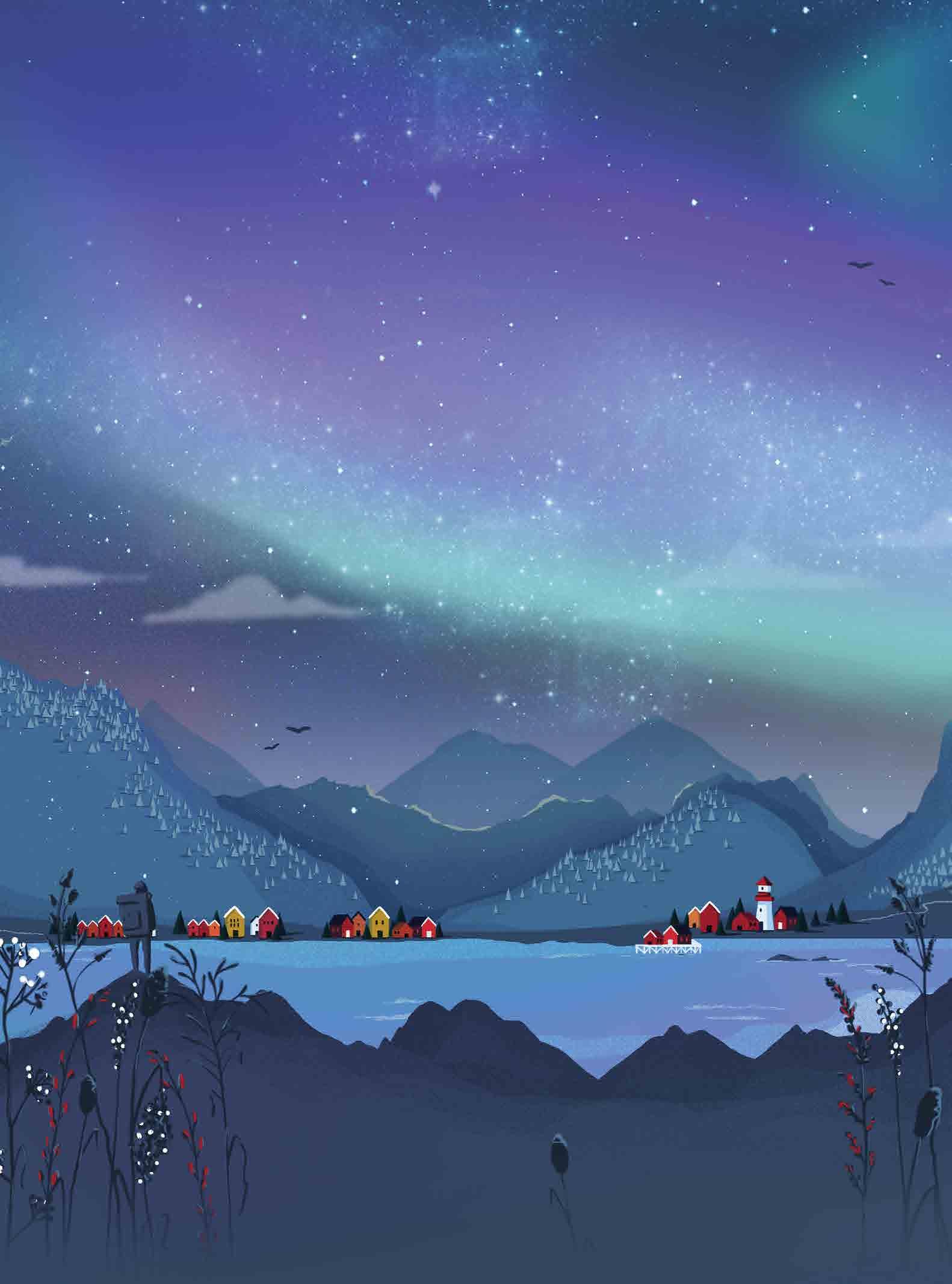
WINTER 13/2018 NORWAY

BEYOND NORTHERN LIGHTS
A natural reaction catches you by surprise at first only to plant the seed of doubt in your mind later about Norway being the second happiest nation in the world – and yet that is what a reputable UN agency reports. Ideally, you should accept it, but how can one be happy in a country where the sky is gray and the land is covered in ice most of the year? Where, in one of its parts, months can pass without a ray of sunshine, while in other parts even nights are sunny? All there is left to do is lose yourself in intoxication, any kind of intoxication, just to break loose from melancholy.
The Norwegians, similar to the other Northerners, have been through it all. “Have been through” is pretty succinct because they have already left it behind, defeated, dead, and buried. Using technological terms, they seem to be on the upgrade, improving, and now enjoying a brand-new chapter of civilization and humanity. They do what many other societies would love to do in theory but find hard in practice. They create effective urban and rural mixes of nature and modernity, never losing touch with their principles and values, certainly keeping their finger on the pulse of their roots and both feet on the ground.
What comes across as a dream in a society like ours is in practice and very real in Norway. It is a way of life in Norway, which is why I think it’s worth visiting the country to check whether implacable urban comfort, like taking a subway train to your ski destination, can make one happy. Can caring for the environment and being in perfect harmony with it bring us happiness? Is happiness about an innovative educational system? Or a human-oriented state seeking to engage with and embrace its citizens and cherish in their development, instead of punishing or marginalizing them?
Norway is a country where these questions are not only items on the list of questions to be answered, but also practical exercises to be done on a daily basis. As for us, we can pretend to be hunting the northern lights and visit Norway to find out that which is also clearly visible in this country, that is, answers to the question: What makes one happy?
TAMAR BABUADZE Editor-in-Chief
LETTER FROM THE EDITOR

#ThisIsYourTime






To become a member please contact: corporateclub.turkishairlines.com or corporate.iev@thy.com







CONTENTS A LETTER FROM OSLO FIRST IMPRESSION 14 OSLO TRANSPORT/MUSEUMS/HOTELS/SHOPPING NORWAY’S CONTROVERSIAL AND CONSERVATIVE CONTEMPORARY ART 34 NORDIC CUISINE 38 SKAL –CHEERS IN NORWEGIAN 46 WHAT DEFINES NORWEGIAN HAPPINESS? 50 FJORDS 54 BERGEN BETWEEN SEVEN MOUNTAINS MUSEUMS/HOTELS/RESTAURANTS 63 SOLAR WIND HUNTERS 74 NORWEGIAN DIARY 86 IBSEN INFILTRATOR FROM NORWAY 96 A GREAT AUTHOR SWEPT UNDER THE RUG 98 LILYHAMMER – NORWAY AS SEEN FROM A SMALL VILLAGE 102 “I AM SO ANGRY, LIV!” 106 YOU CANNOT COME BACK UNLESS YOU LEAVE 112 THE UNBEARABLE NORWEGIANNESS OF JAZZ 116 WAYWARD TEENAGERS’ OPERA 120 DAGNY JUEL 124 22 33 8 VOYAGER 13/2018



Editor-in-Chief
Tamar Babuadze
Project Curator
Tina Osepashvili
Copy editor
Nino Saitidze
Norwegian Language Consultant

Sopio Karchkhadze
Cover Design
Tina Gordeladze
Mari Kakhurishvili
Designer
Nino Kavelashvili
Authors:
Maya Kipshidze
Irina Popiashvili
Tamar Kvinikadze
Una Abashidze
Natia Akhalashvili
Kakha Tolordava
Desi Dashkova
Sandro Naveriani
Project Manager / SOLO DIRECTOR
Nino Chikovani
Project Consultant
Nino Gegeshidze
SOLO Brand Manager

Keti Nikoleishvili
Mikheil Tsikhelashvili
Vera Zarkovska
Salome Kikaleishvili
Lasha Bughadze
Archil Kikodze
Aka Morchiladze
Sales Director
Nazzi Goshadze
Photo - Shutterstock
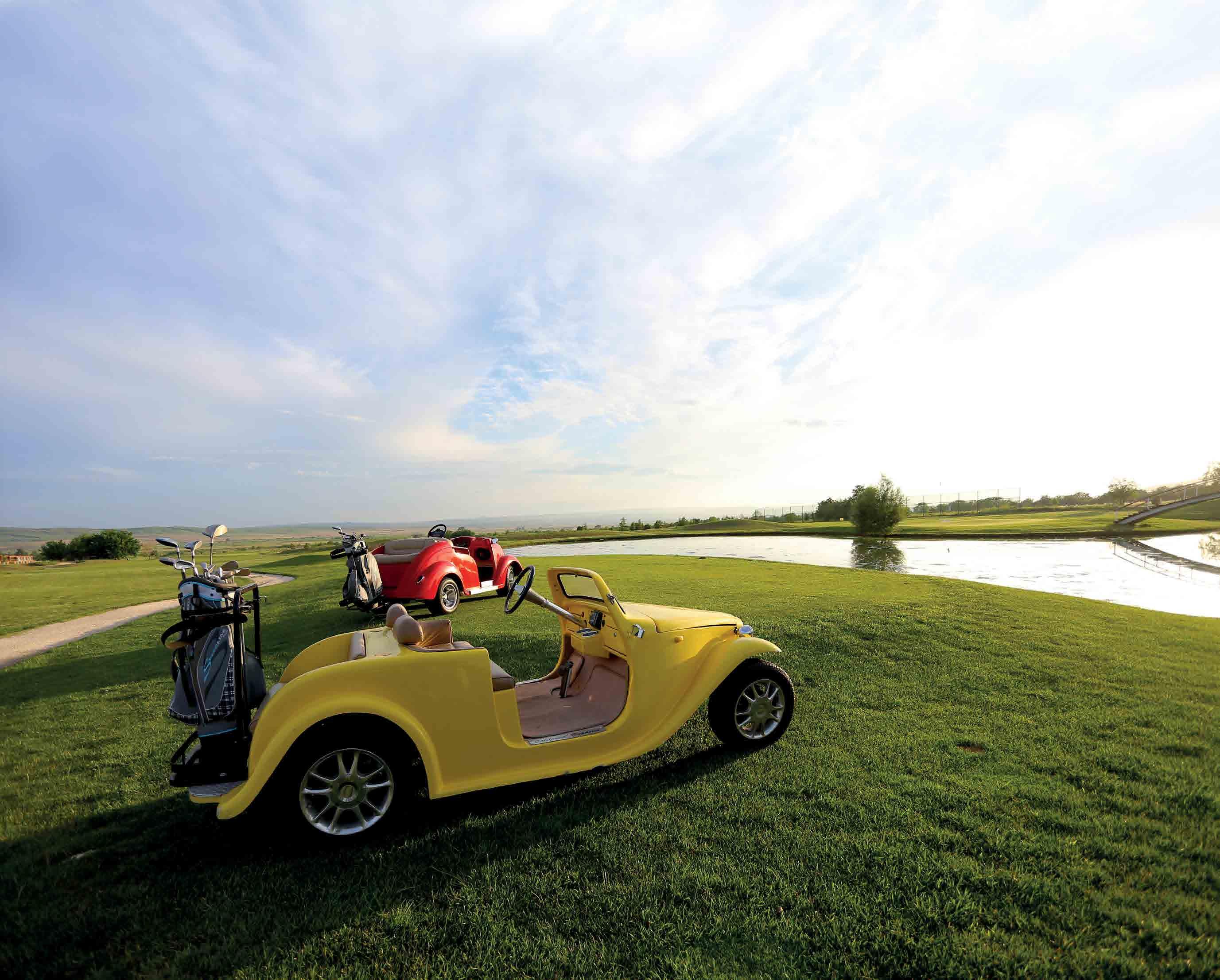
Maya Kipshidze
Archil Kikodze
ISSN:
13, 2018
Advertising: +995 599 330 364 / Published material owned by LTD SOLO. Written Consent of the Company necessary for use of any material published in this magazine. Publisher: LTD SOLO
+995 32 2 44 44 00
Phone.:
2346-8130

TBILISI SOLO LOUNGE MTASTMINDA 11, Chitadze Str.
TBILISI SOLO LOUNGE PALIASHVILI 23, Paliashvili Str.
TBILISI SOLO LOUNGE ABASHIDZE 70, Abashidze Str.
TBILISI SOLO LOUNGE TSINTSADZE 12, Tsintsadze Str.
TBILISI SOLO LOUNGE Chavchavadze 29, Chavchavadze Ave.
TBILISI SOLO LOUNGE KAZBEGI 24G Kazbegi Ave.
TBILISI SOLO LOUNGE KAZBEGI 25, Kazbegi Ave.
KUTAISI SOLO LOUNGE KUTAISI 5, Q. Tamar Str.
BATUMI SOLO LOUNGE Batumi 22, Rustaveli Ave.
TBILISI SOLO LOUNGE TSERETELI 73 Tsereteli Ave.


TBILISI SOLO LOUNGE GLDANI 8, Nozadze Str.
TELAVI SOLO LOUNGE Telavi 3, Cholokashvili Str.

www.solo.ge Tel.: +995 32 2 44 44 00

A LETTER FROM OSLO
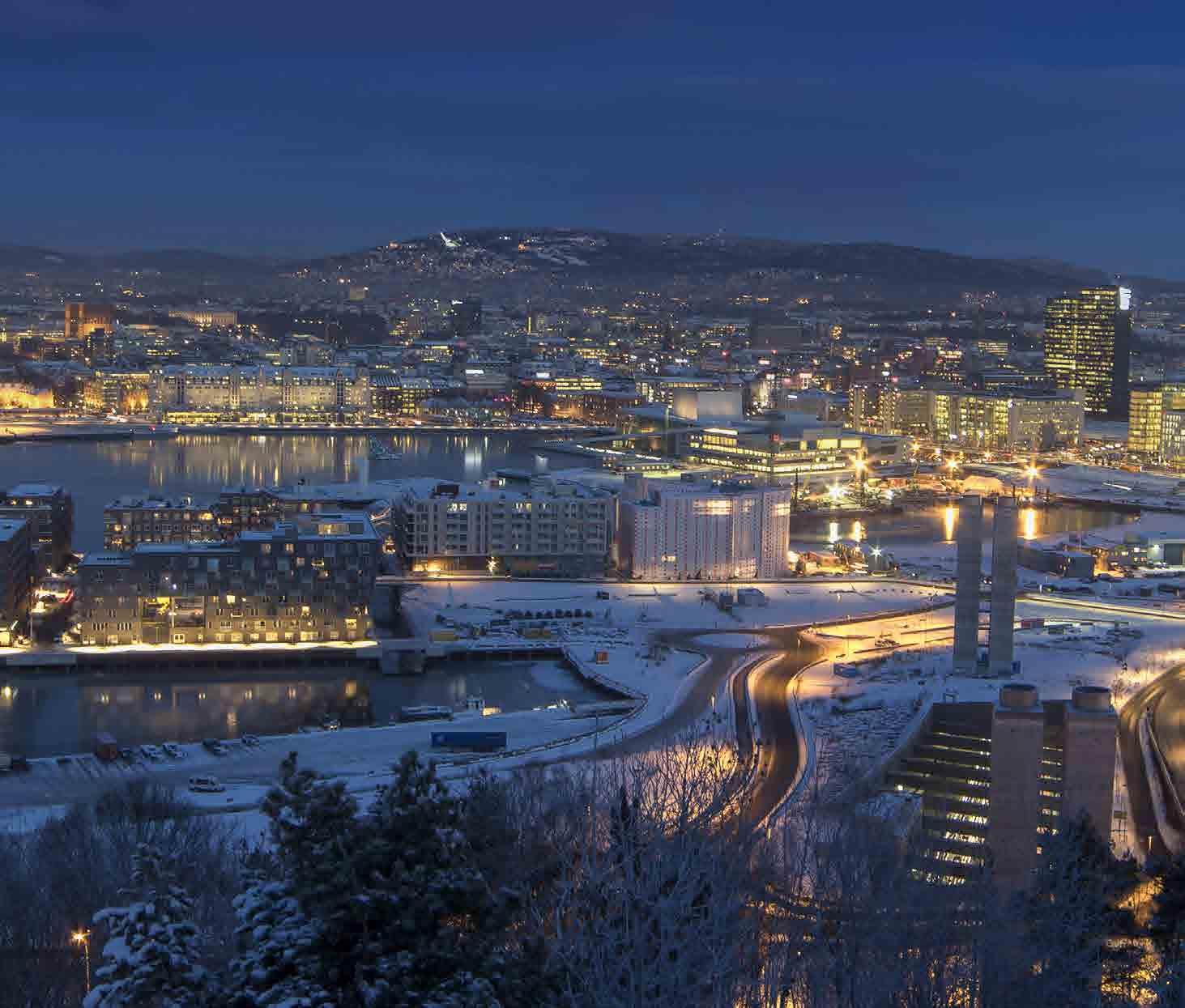
FIRST IMPRESSION
Some of the first associations to pop into your mind in relation to Norway are likely to include fjords, white nights, the northern lights, celebrated authors Knut Hamsun and Henrik Ibsen, composer Edvard Grieg, polar explorers Fridtjof Nansen and Roald Amundsen, Thor Heyerdahl and his KonTiki, artists Edvard Munch and Theodor Kittelsen, Nobel Peace Prize Laureates, trolls and, of course, Vikings.
It has been nine months since I arrived here in early February, and I already have my favorite places in Oslo. Frogner Park is one of them. This exceptional landmark favored by Oslo’s visitors features 214 works by sculptor Gustav Vigeland. Regardless of the season, I am willing to go contemplate these bronze, granite, and wrought iron sculptures and fathom different stages of life depicted by the scupltor, such as male-female or parent-child relationships, or the elderly – these gigantic sculptures portray the whole circle of human life. They are very impressive and offer new details
each time. I often take my guests there. I also have a soft spot for Ekebergparken Sculpture Park in the heart of Oslo. It’s so big, though, that it reminds me of the Kechkhobi Forest in Borjomi, but with spellbinding views of the Oslo Fjord and gripping sculptures. Generally, the Norwegians love sculptures. Norway’s streets, forests, and bridges abound in all kinds of sculptures. One particular spot in Ekebergparken Sculpture Park is famous for being the place where Munch painted The Scream, probably his most celebrated work.
I find it equally delightful to stand on the shore and enjoy the sight of Oslo Fjord. Aker Brygge is a neighborhood offering some of the finest views of ships, boats, and ferries sailing between islands. The Bygdøy Peninsula, which brings together Oslo’s famous museums, can also be seen clearly from here. I love being able to take a subway train to Sognsvann, a lake just 15 minutes north of Oslo packed with picnic, recreation, and athletic areas.
OSLO
MAYA KIPSHIDZE
14 VOYAGER 13/2018
Georgia’s Ambassador Extraordinary and Plenipotentiary to Norway
As a newcomer, I did not find it hard taking in the local environment or people. I had Norwegian friends before arriving here, and I knew that they were reserved people tending to keep their distance and to stick to their established routine – they know exactly what they are doing and why, and what is happening around them and why. They even meet surprises and challenges consciously. To me, their characteristic ties to the wild nature and proves the point above, because they strive to prove to themselves that they can overcome obstacles and triumph over challenges. They would rather get lost in the forest and then fight their way back. They prefer to ski the more ungroomed places, to have the more intense experiences. They often opt to travel alone. They even joke about it, “I had a wonderful time skiing because there was no one around.” Relentlessness in overcoming difficulties is in their blood, an absolutely unique characteristic, I believe.
There are other details indicative of their immaculate social consciousness, which I discovered in the first few months of my stay in Oslo. It took me a while to figure out why I was having a hard time adapting to temperatures below -20 °C and snow-covered landscapes. The thing is that the ice is not cut and removed from the streets here because it is too expensive. It is a policy of sorts – if you break your leg, it is your fault because you hit the street without cramponlike devices which, by the way, are sold in pharmacies and even shops on every corner. The entire period until
mid-April, I walked with my head down, unable to see anything but the ground below. Nobody is wining about ice-covered sidewalks – they know that their safety is their own responsibility. To this day, I cannot hold back my envy watching Norway’s traffic with cars keeping a 50-100-meter distance. The issue of construction permits is also under strict control. Before issuing permits the environment is scrutinized, and there is no way in the world a permit can be issued if the given area is an irreplaceable environment for a particular plant or bird.
Oslo has been declared the European Green Capital 2019, so an innumerable relevant events have been scheduled. We want a delegation from Tbilisi to be present because sharing Oslo’s experience will be very interesting for us. A lot is being invested here to ensure well-functioning public transport, keeping tabs on fuel quality, and urging the population to switch to electric vehicles, also ensuring against too many parking spaces in the center even though it is quite uncomfortable for drivers – it is something that must be done and they know it to be right as well.
Oslo’s residents cover long distances on foot, and the issue of public transport here is simply irreproachable. I have, on several occasions, witnessed senior officials using a subway train to get to our embassy. The subway also reaches ski destinations in the suburbs, which is why it is normal to see Norwegians with their skis in their hands in trolleys
FROGNER PARK FEATURES 214 SCULPTURES. REGARDLESS OF THE SEASON, I AM WILLING TO GO CONTEMPLATE THESE BRONZE, GRANITE, AND WROUGHT IRON SCULPTURES AND FATHOM DIFFERENT STAGES OF LIFE DEPICTED BY VIGELAND.

15 VOYAGER 13/2018
or subway cars. Yes, they even go to ski by subway! It is in this country that I have witnessed the slogan “all men are created equal” at its best, producing the most tangible results. The Norwegians take pride in being the most egalitarian society. Although, technically, the country is a constitutional monarchy, the king and queen certainly do not bask in splendor. I have even read somewhere that you might bump into them in a local supermarket buying pizza. The Royal Palace Park is open to all, and many Oslo residents, now including me, walk to work through this garden.
Many people in Norway, however wealthy, never flaunt their wealth. Judging by the exterior, you may never guess that a rich Norwegian lives in any given house. You may see senior officials walking to work and enjoying a brown bag during a lunch break – you might not believe your own eyes. Privileges just do not apply here. Yes, they are proud of their egalitarianism, and they hope that this notion and tradition of equality will never change in their country. That might explain Norway’s unique, famed sovereign wealth fund, which has declared the people’s heritage worth over 800 billion euro, and the state does not spend a penny of it in order to hand it down to future generations. When discussing this country, we absolutely must mention a few historical dates that have forged this nation and defined its character, way of life, and relations with neighbors. Instead
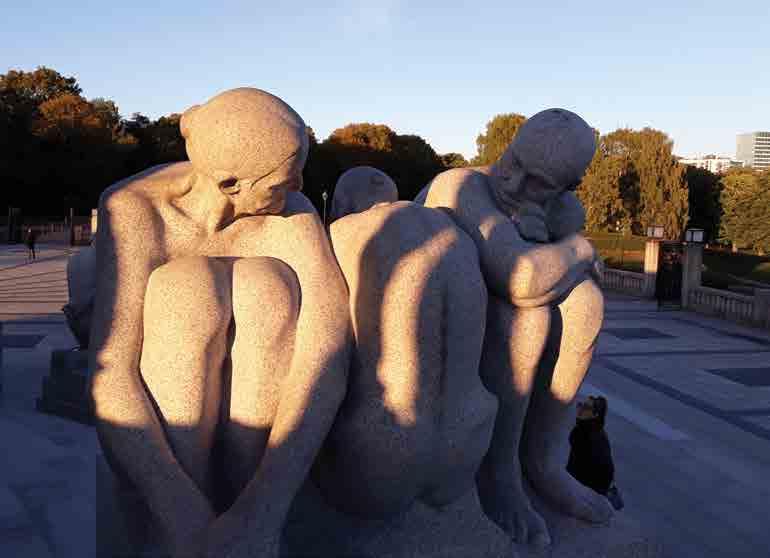

PRIVILEGES JUST DON’T APPLY HERE. THEY ARE PROUD OF THEIR EGALITARIANISM, AND THEY HOPE THAT THIS NOTION AND TRADITION OF EQUALITY WILL NEVER CHANGE IN THEIR COUNTRY.
Royal Palace Park
OSLO 16 VOYAGER 13/2018
Frogner Park
of a distant past, let’s skip the Viking Age and have a look at two crucially important dates in Norway’s history: May 17, 1814 and 1905 when Norway restored its independence after being part of Denmark for about four centuries.


In 1814, the first constitution was drafted, though in the same year Norway found itself under Swedish rule. Ultimately, Norway claimed independence as late as 1905, and May 17 celebrates that glorious event. If you happen to be in Oslo, or anywhere else in Norway, you will witness an unbelievable festival of unity, with Norwegians in their traditional bunad attire celebrating their independence. Bunad is found in every household, and it is almost invariably present in wedding receptions and feast-day events. On May 17, a parade is held, during which the students of Oslo’s schools proudly proceed in front of the Royal Palace to greet the royal family cheering from the balcony.
For quite a while, Norway was a pretty poor country mainly living off agriculture, fishing, and shipbuilding. The situation changed dramatically in December 1969 with the discovery of Ekofisk, the first Norwegian oil field, turning the country into one of the richest in the world. Yet to the Norwegians, nature is what matters most, not necessarily oil deposits. Of course, oil and its wealth does have an impact on their way of life, but nature certainly is what makes the Norwegians
truly happy. Spending quality time in the great outdoors seems to be an end in itself.
Another striking feature is trains packed with Norwegians on Fridays on their way to hytte summer houses or winter cottages. The locals are religious about weekends – it is a time when they literally become one with nature, skiing in winter and camping in summer, and the wilder their destination further from civilization is, the happier they are. Some hytte houses do not even have heating, water, or power. Just this summer, I spoke with a Norwegian couple in their late 70s, who was about to set off for their hytte. “We have no water supply in our cottage, so we carry it from the well,” they told me. I, too, have had a similar experience. Twenty years ago, when I first visited Norway to see my friends, they took me to their cottage in an old-growth forest, in the middle of nowhere – a local hospitality tradition of sorts to show respect for one’s guests. We hit the sack after sunset, they told me. It was 1995. Having arrived from Georgia, I nearly freaked out at the mere thought of a candle. Still, I asked for
IF YOU DECIDE TO VISIT THIS FAIRYTALELIKE COUNTRY, THE FIRST THING I WOULD RECOMMEND IS TO MAKE SURE YOU HAVE A GOOD PHOTO CAMERA.
17 VOYAGER 13/2018
Olympic Champion Sonja Henie, who stars in SunValley Serenade
one to read some, and my request was granted. After such adventures, one is more likely to have a better appreciation of urban comfort. In addition, environmentalism must be running through their veins. Norwegian guests in Georgia make a point of warning us to be careful, lest we cause much damage. They are equally fond of traveling abroad and are curious about the outside world.
“It is another world, more handsome people, redder wine, higher mountains. And I believe that God lives around Kazbegi all year around,” Knut Hamsun once described Georgia. In 1899, on his way from Finland via Russia, he entered Georgia through Kazbegi (Stepantsminda) and then traveled to Baku and Istanbul. Afterward, Hamsun wrote a book titled In Wonderland: Experienced and Dreamed in the Caucasus and published in 1903. The quote above is from his 1900 letter to Dagny Kristensen. Hamsun was not the only Norwegian bedazzled by Georgia, though.
In June-July 1925, Fridtjof Nansen traveled through Georgia, Armenia, and Dagestan, arriving to Batumi from Istanbul and then heading off to Tbilisi from there. The goal of this visit was to repatriate Armenian refugees from the region’s countries.
After this journey, Nansen published two books: one about Armenia in 1927 and the other about Georgia ( Through the Caucasus to the Volga ). In the book about Georgia, Nansen writes that the country has everything, including beautiful nature, vast forests, broad valleys, hills, high mountains, and gorgeous coastal cities. In 1932-1933, Professor and
later Rector of the University of Oslo Hans Vogt (1903-1986) lived in Georgia and studied the Georgian language. He also studied Armenian and Georgian in Paris. In 1936, he received a doctoral degree from the University of Oslo for his work on modern Georgian grammar. He also delved into other Caucasian languages, including the extinct Ubykh language.
In a letter sent from Georgia, Vogt describes the great impression that the Georgian people made on him and talks about friends he made during his brief stay. The archives of Hamsun, Nansen, and Vogt were exhibited in the National Library of Norway on October 29.
This small exposition at the entrance of the library’s special reading room was dedicated to the 100th anniversary of Georgia’s first democratic republic and lasted until November 13. The Georgian Embassy has already contacted the National Library of Georgia to start deciphering and digitalizing these works, which must be a mutually exciting process.
I believe that our literary ties will grow stronger, especially in light of the Frankfurt Book Fair. After all, Georgia has just passed the Guest Scroll on to Norway as the Guest of Honor in 2019. We, for our part, dedicated a special exhibition to celebrate Georgia as the Guest of Honor in 2018. On October 12, the Georgian Embassy in Norway, in cooperation with the University of Oslo, introduced almost 100 guests to the history of the three types of Georgian script. Among others, Hans Vogt’s son spoke about the merit of his father.

OSLO 18 VOYAGER 13/2018
She Lies floating installation and the Opera House
Norwegian literature is duly appreciated in Georgia. In cooperation with NORLA (Norwegian Literature Abroad), more than 80 Norwegian literary works have been translated and published in Georgia. I very much hope that, in the future, we will introduce Georgian literature to Norwegian audiences. Our embassy is already cooperating with two publishers.
Two major literary festivals are held in Norway each year, and we would love to showcase Georgian literary works in the Norwegian language at both.

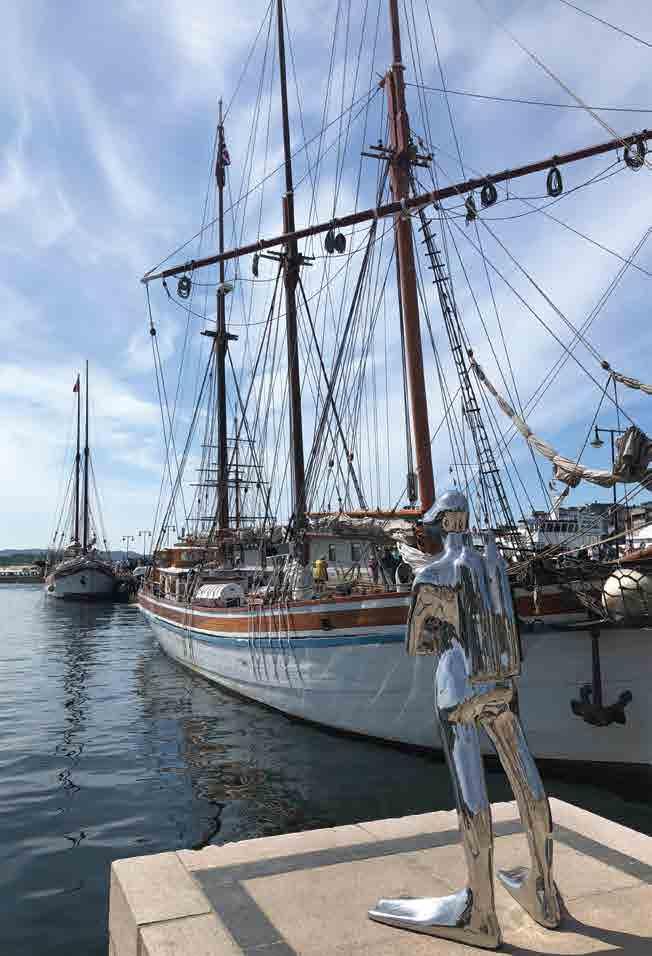
The literary and other ties between our countries have a long history. We first established diplomatic relations in 1918. To celebrate the 100th anniversary of Georgia’s first democratic republic, the embassy, in cooperation with the ABK Technology studio, produced a short documentary on Georgian diplomats Mikhako Tsereteli and Aristo Chumbadze, our first ambassadors to Sweden and Norway. They are credited with contributing to the fact that the prominent Norwegian politician, explorer, and Nobel Peace Laureate Fridtjof Nansen played a decisive role in the recognition of Georgia’s independence by the League of Nations.
The film also describes the merits of famous lawyer and diplomat and member of the first Georgian Government Zurab Avalishvili and his wife, Maya Vogt. Nansen, along with two other Norwegian explorers: Thor Heyerdahl and Roald Amundsen, is hailed a role model in Norway. I believe that together they embody every value characteristic of this nation.
Aker Brygge. A view of the Oslo Fjord
19 VOYAGER 13/2018
The Oslo Fjord with the City Hall in the backdrop
We absolutely must mention trolls. Theodor Kittelsen (18571914), a nature painter and illustrator of Scandinavian folklore and Norwegian fairytales and legends, was actually the first to paint trolls, based on which Walt Disney created his seven dwarfs. Kittelsen also created a famous illustration with a little boy named Askeladden looking at the fairytale Castle of Soria Moria.
Kittelsen’s small house museum in Blaafarveværket, just one hour from Oslo, is certainly worth visiting. This neighborhood also incorporates the famous cobalt mines favored by scores of tourists. Trolls appear in numerous legends and fairytales; they seem to be all over the place, be it in literary works (e.g. in Peer Gynt, a famous play by Henrik Ibsen with incidental music by Edvard Grieg), a sculpture in the street, a souvenir shop, or postcards.
According to Norwegians, though you may not see them, they are certainly real. If you decide to visit this fairytalelike country, the first thing I would recommend is to make sure you have a good photo camera. Don’t let the cold intimidate you.
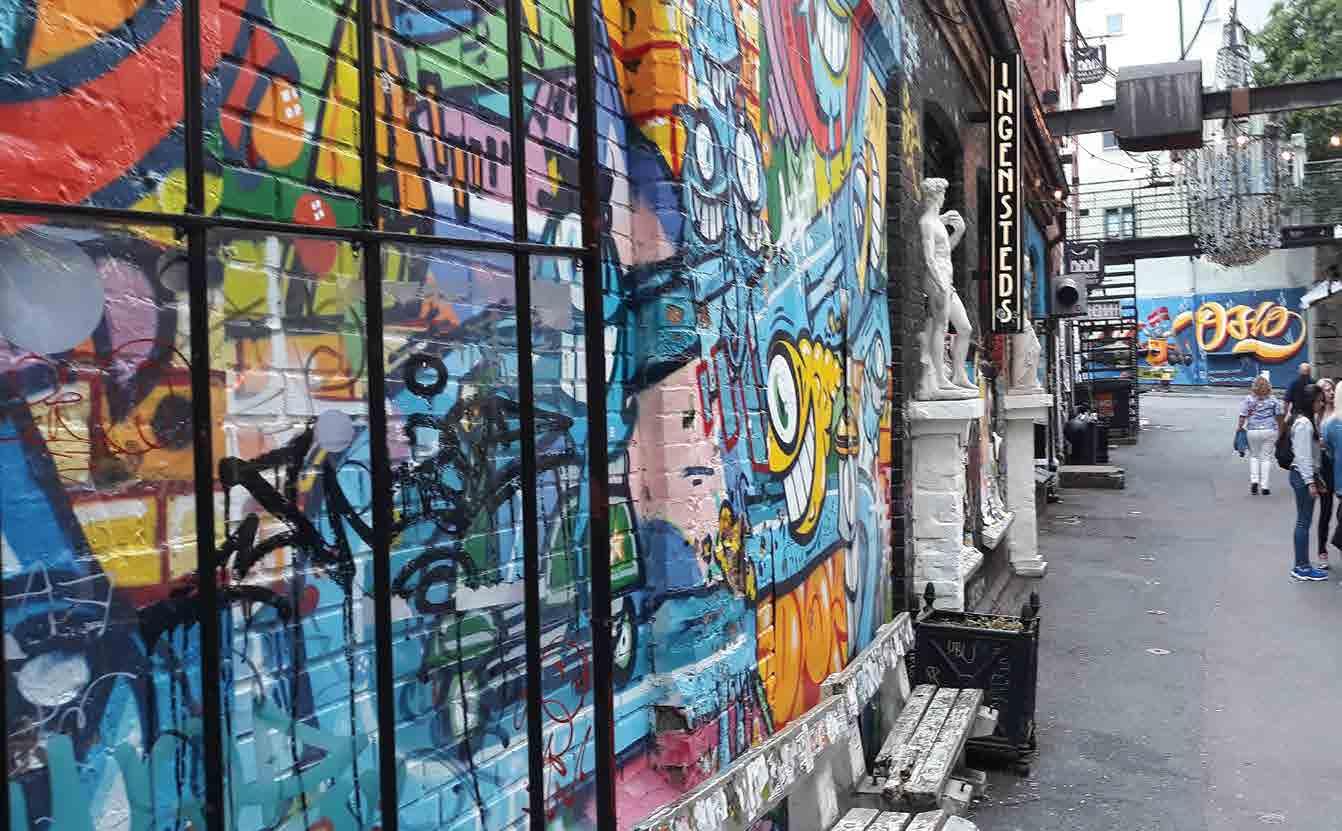
As Norwegians love to say, there is no cold or bad weather; there is only a bad choice of clothing. In your travel to Norway, you will need comfy shoes, a camera, and a desire and ability to take in the nature, and, equally importantly, a well-planned budget because the country is not cheap by any stretch of the imagination.
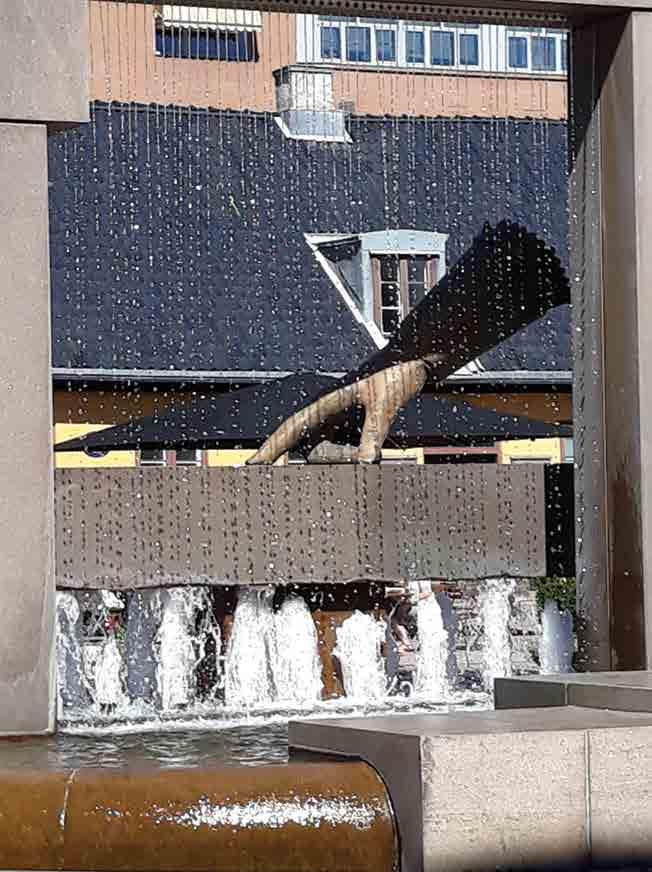 Bohemian Grünerløkka District
Bohemian Grünerløkka District
OSLO 20 VOYAGER 13/2018
Sculpture of King Christian IV’s Hand symbolizing the city’s founding:“Christiania (Oslo) will rise here!”



IMAGINE 2950 ₾ From LANDSCAPING EVENT HALL KINDERGARTEN SECURE AREA Open park with secure access points. LOBBY An ideal place for business meetings with a dedicated concierge service. A colorful environment and caring teachers for the tiniest residents of Tbilisi Gardens. Perfect place for noisy parties and huge events. 21 000 m2 of green area to relax. All day gym with experienced trainers. Olympic-size and kids swimming pools. FITNESS CENTRE POOL IN THE CENTER OF THE CITY All in one place First New York Skyscraper in Tbilisi
VISITING OSLO
If you happen to be in one of the crowded subway stations of Oslo in winter, you may come across a strange sight: most of the passengers holding skis in their hands busily swarming and rushing toward their desired destinations. Holmenkollen is one of the major stops where skiers usually gather further to proceed toward the mountains. This means of rapid transportation from the city into nature was established more than a century ago. The mountain-bound train has been operating since the 1890s as one of the key components of the city’s urban fabric.
Those going to ski disembark at the Frognerseteren Station, and getting there is an adventure in itself. As the train exits the tunnel and starts its uphill ascent, the most fantastic views appear before you, with the most impressive sight awaiting you at your final destination: a myriad of ski runs and enormous forests poised to put you in the right mood.
NORWAY’S AUTHORITIES ARE MAKING AN ALL-OUT EFFORT TO PRIORITIZE
PUBLIC TRANSPORT OVER PERSONAL AUTOMOBILES, SO THEY ARE PUTTING IN PLACE EVERY CONDITION TO THIS END, INCLUDING CHEAPER FARES AND USER-FRIENDLY SMARTPHONE APPS AS A PREREQUISITE FOR A COMFORTABLE RIDE.
The cost of their transit card, the Oslo Pass, covers Oslo’s public transport and free entry to 30 museums and entertainment centers. It also gains you entrance to outdoor pools, participation in walking tours around the city, and grants a discount on amusement park admission, concert tickets, mountain-climbing sessions, ski gear, and other bonuses. Ruter, Oslo’s public transport authority, combines local bus, trolley, subway, and ferry networks.

Ferries are necessary to reach Oslo’s nearby islands, with a special ferry serving the Museum Island. Keep in mind the NSB, the Norwegian State Railways, strives to ensure comfort for its passengers. Naturally, Oslo has numerous bike services to supplement public transport, so you may want to try Oslo Bysykkel (Oslo City Bike) to locate them.
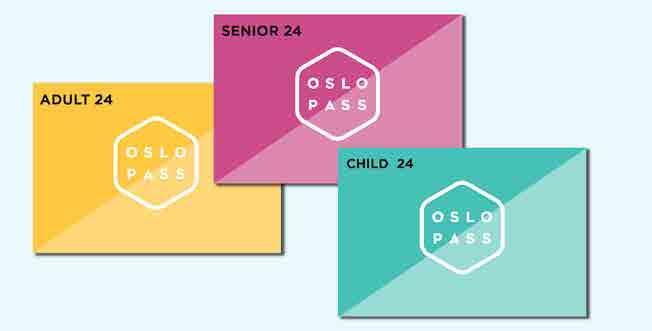
TRANSPORT 22 VOYAGER 13/2018
MUNCH MUSEET
It is the place where Edvard Munch and contemporary Dutch artist Marlene Dumas meet.
Lunar sunrise
Marlene Dumas And Edvard Munch
EXHIBITION CONTINUES
UNTIL JANUARY 13, 2019
Born in 1953, Marlene Dumas is known for his expressive portraits and compositions. Dumas’s fascination with Munch goes way back to 1981 when he first visited the Munch Museum to be forever captivated by the artist.
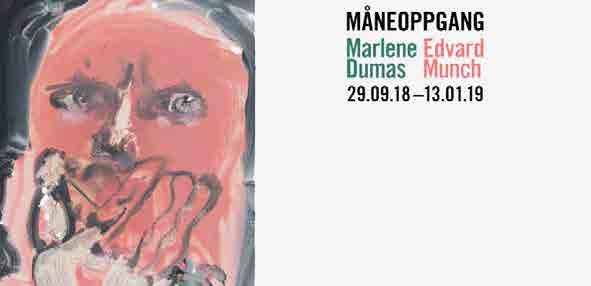
Ever since, Dumas’s favorite works from Munch’s oeuvre is Alpha and Omega (1908), a series of lithographs. The key themes of this satirical parable are featured as part of the museum’s permanent exhibition to portray guilelessness transforming into loneliness, temptation, eroticism, anxiety, and death. This museum, which displays a number of works by Munch and a full catalogue of his work, hosts international collaborations and exhibitions linking a variety of artists, such as Van Gogh, Paul Gaugin, Andy Warhol, and others, to Munch.
Tøyengata 53 / www.munchmuseet.no/en
NATIONAL MUSEUM IN OSLO
The largest collection of Norwegian arts, architecture, and design www.nasjonalmuseet.no/en
EDVARD MUNCH AND THE SCREAM
National Gallery
The National Museum in Oslo preserves the most impressive collection of works by Edvard Munch (1863-1944), including such a celebrated iconic painting as The Scream. The unique Munch Hall at the National Gallery permanently displays 15-20 of his works. Here you can see the earliest versions of The Scream (1893), Madonna (1894-1895), Girls on the Pier (1901), The Dance of Life (1899-1900), and The Sick Child (1885-1886), his artistic manifestos captivating us with their blunt and deep humanism. Most likely, it is only here that you can take in Munch’s oeuvre to the fullest.

Universitetsgata 13, Oslo
THE SCREAM
Created in 1893, this painting was handed to the National Gallery in 1910. In terms of popularity, it is on par with such masterpieces as The Mona Lisa (1503) by Da Vinci and Van Gogh’s Sunflowers
A piece of advice: Those into the later works by Munch, along with the Munch Museum, are also advised to visit the KODE Art Museum in Bergen, also Munch’s home in Åsgårdstrand and summer cottage in Hvitsten, where he drew on the magical powers of the local landscapes to inspire him throughout his life. Both houses are within one hour by car from Oslo.
MUSEUMS 23 VOYAGER 13/2018
HOUSE VIEWING
House Viewing until December 30, 2018 offers an impressive two-room residential exhibition with excellent views.
During the early 2000s, Oslo became one of the fastest growing cities in Europe. New apartment buildings began rising ever faster and higher, and in ever denser configurations. With its exploration of residential projects planned and realized in the capital over the past 10-15 years, the exhibition focuses on standards of urban living.
How do outdoor areas, neighborhood structures, access to daylight, and the layout of individual apartments affect our quality of life? The exhibition exposes the links between politics, regulatory mechanisms, and architecture, with further reference to cities such as Copenhagen and Vienna.
HARALD SOHLBERG—INFINITE LANDSCAPES
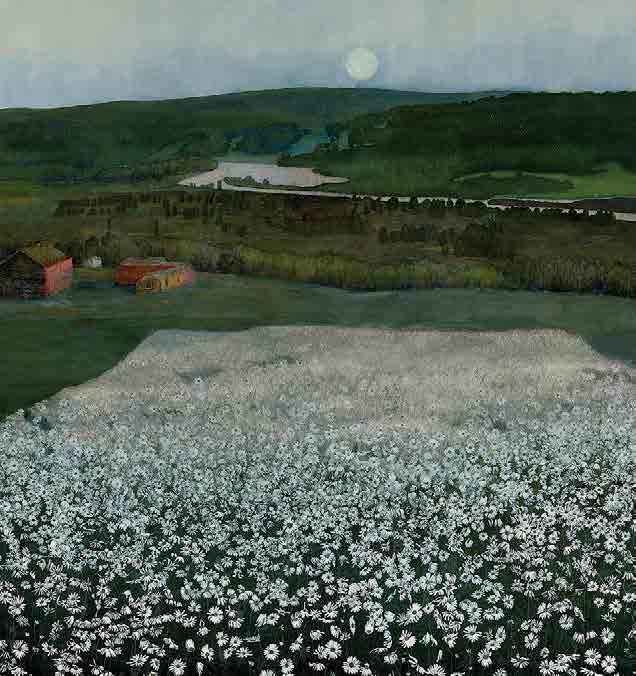
This exhibition is open until January 19, 2019 to display a large-scale retrospective exposition of Harald Sohlberg, one of the great masters of landscape painting, including almost 60 paintings, along with sketches and photos. This exhibition showcases such famous works as Winter Night in the Mountains (1914), Summer Night (1899), Flower Meadow in the North (1905), and others, along with various paintings from private and public collections that have not been displayed publicly in the past 50 years.
Universitetsgata 13, Oslo
HOUSING DESIGN
The National Museum – Architecture, permanent exhibition in the Bucher Room.
Because housing is one of the National Museum’s focus areas in 2018, this exhibition space is constantly updating its permanent architectural collection. With models, drawings, and photographs from the collection, the exhibition offers insights into the history of modern Norwegian housing.
How have notions of housing quality changed during the century from around 1920 to the present? The exhibition shows how Norwegian architects have explored new forms of housing and new approaches to urban planning in residential projects.

Of central interest are the garden cities of the inter-war period (1918-1939) and the expansion of the suburbs after WWII. Alongside the main emphasis on social housing, the exhibition looks at experiments in home architecture in terms of selected detached houses. Atrium houses from the 1960s are also on show, a particularly fruitful test bed for new life styles.

24 VOYAGER 13/2018
NATIONAL MUSEUM Bankplassen 3, Oslo Architecture
MUSEUMS
LE CORBUSIER – LITHOGRAPHY

Exhibited until January 20, 2019
“Since 1918, I have painted practically every day. It is through painting that I’ve found the forms for my architecture,” Le Corbusier stated in an interview in 1962. Le Corbusier, one of the most influential architects of the 20th century, viewed himself primarily as a plastic artist. In creative work he made no distinction between painting, sculpture, and architecture, and viewed them as a single whole.
In the winter of 1966, the Museum of Decorative Arts and Design in Oslo presented a major exhibition about Le Corbusier, a commemoration of the architect just a few months after his death. For this, the curator and architect Robert Esdaile built an exhibition pavilion within the museum as a setting for reproductions of architectural models, sculptures, and paintings. It was time the Norwegian public rediscovered Le Corbusier’s varied production. For the first time since 1966, those artworks are on show again.
In 1955, the viewers were shocked by the sculptural and so-called irrational forms of the Notre Dame du Haut Chapel unveiled by Le Corbusier at Ronchamp, France. The exhibition includes photos from old collections and press reviews revealing how these new architectural forms were perceived at that time.
NOBEL PEACE CENTER
The Nobel Peace Center offers an intriguing combination of permanent and temporary exhibitions. Its innovative interactive expositions focusing on war, peace, and conflict resolution contain a sea of information.
The Peace Prize laureates are all presented on digital screens in the Nobel Field where smaller screens are dedicated to individual laureates, with relevant textual, audio, and visual information available for visitors to enjoy.
The museum also facilitates activities and games for children. The gift shop has a lot to offer to those interested in books, printing technology, and book design.
FORTELL VERDEN OM OSS (Tell the World about Us) is an ongoing exhibition at the Nobel Prize Center.
In 2002, while the civil war in Colombia was still raging, photographer Rune Eraker was granted permission to visit a prison in Bogotá. His objective was to document the conditions under which political prisoners were being held.

When the guard turned his back for a moment, Eraker took a photo of a prisoner in solitary confinement. The prisoner approached the photographer and handed him a crumpled note.
It read, “Tell the world about us.” Sixteen years later, that plea turned into an exhibition at the Nobel Peace Center in Oslo. Eraker visited 18 countries in four years, managing to enter strictly guarded prisons in Latin America, Asia, Africa, the US, and Norway. Everyone exhibited here has one thing in common: they all have been deprived of their freedom and dignity, and they are fighting tooth and nail to retain it Radhusplassen, Oslo / www.nobelpeacecenter.org/en
25 VOYAGER 13/2018
BYGDØY PENINSULA OF FIVE NATIONAL MUSEUMS

Bygdøy, an Peninsula west of Oslo, houses several famous museums, besides being an excellent residential area. In summer, however, it transforms into a popular recreation area with beaches, volleyball courts, horse racetracks, and waterside restaurants and cafes. It also has bike paths and sidewalks for those curious about learning everything about the whole island.
Most importantly, ferries are available year-round to take straight to each of the five museums, and information about routes and stops is easy to find using the keyword Bygdøyfergene.

MUSEUMS 26 VOYAGER 13/2018
THE KON-TIKI MUSEUM
Norwegian traveler Thor Heyerdahl made a name for himself in 1947 by crossing the Pacific Ocean on a balsawood raft. His book describing the journey became a bestseller, and the documentary using the expedition’s footage won an Oscar for Best Documentary Feature in 1951. This museum, which is actually dedicated to one small primitive raft, opened in 1950 and has since turned into a symbol of insatiable curiosity, defiance of conventionality, and championing environmental issues.
The Kon-Tiki Museum’s exhibits are displayed in a number of languages and include ancient rafts, ships, and other materials about Heyerdahl’s expeditions, including models of sharks and other large fish. Here you can also visit a 30-metre-long replica of a cave on Easter Island, an underwater exhibition, books from Heyerdahl’s

NORWEGIAN MARITIME MUSEUM
Since its inception in 1914, the Maritime Museum has been collecting, studying, and teaching Norway’s maritime cultural heritage. The museum has a wide range of indoor and outdoor exhibits. At scheduled times, children can attend special workshops to learn how to build boats and ships. In a special room, a panoramic film depicting life underwater is screened to cover almost

NORSK FOLKEMUSEUM
Also found on the island, this museum incorporates both outdoor and indoor areas to showcase separately a mockup of the Old City and a reenactment of life in the village. The indoor exhibit includes the Apartment Building, showcasing the same building with eight different period interiors from the
19th century to 2002. This enormous space offers incredibly impressive visual, textual, and audio materials in clear and simple language to reenact different periods in Norway’s history since 1500. The museum holds frequent temporary exhibitions.
If you are in town for Christmas, you should visit the museum’s Christmas exhibition, a genuine treat for your children. The
personal library, and other materials better to familiarize yourself with the explorer. The Kon-Tiki Museum seems of special interest to younger ones, including those of preschool age, because a part of the exhibition is designed to suit their knowledge and perceptions. In all honesty, what can be better than teaching our children these words by Thor Heyerdahl: “Borders? I have never seen one. But I have heard they exist in the minds of some people.”
Bygdøynesveien 36 / kon-tiki.no
the entire wall. Similarly, panoramic interactive exhibits and computer games allow visitors to learn more about life at sea and great expeditions. An interactive educational center operates in a separate 500 square meter territory under the museum, where children, through impressive technological means, familiarize themselves with the exhibition Norway Is the Sea.
Bygdøynesveien 37 marmuseum.no
territory of the Open-Air Museum consists of 160 buildings portraying the history of different time periods, villages, and cities, and differences between social strata. Most importantly, the museum brings contemporary history to life in the form of different artistic and documentary projects.
Norskfolkemuseum.no
Museumsveien 10, Bygdøy
27 VOYAGER 13/2018
SKIFORENINGEN
SKI MUSEUM
Skiforeningen, a ski museum in Holmenkollen, is located under the oldest ski jump in the world and covers 4,000 years of ski history, bringing together polar exploration exhibits and offering snowboarding and modern skiing exhibitions. The ski jump tower offers a breathtaking view of the entire

DEN NORSKE OPERA & BALLET
The Norwegian National Opera and Ballet is located on the waterfront of the city’s central district of Bjørvika and leaves an unforgettable impression from any spot, both near and far, night or day. The building was completed by the Snøhetta architecture company and opened its doors in 2008.

In 2009, the building received the EU Prize for Contemporary Architecture. Visit the opera house’s website because the holiday season is especially festive and magical there. On the other hand, even if you do not feel like watching an opera, don’t leave Oslo without simply having a look at this magnificent building.
Norway’s main tourism website reads that people are likely to be arrested if you walk on the opera house rooftops. The opera house in Oslo, however, feels like the complete opposite of the usual “Please don’t touch” culture tourists are often met with worldwide. Enjoy unforgettable views from

city of Oslo. From a distance, the whole complex resembles a ski jump reaching up to touch the sky and inviting you to draw in closer.
Kongeveien 5 / www.skiforeningen.no
the marble-embellished roof of this opera house. Just keep in mind that under your feet there are three differently designed ultramodern stages, a myriad of public rooms and halls of one-of-a-kind designs, and a unique chandelier with a moonlike presence.
Kirsten Flagstads Plass 1 / www.operaen.no
MUSEUMS
28 VOYAGER 13/2018
THERE ARE DOZENS OF HOTELS IN OSLO TO FIT ANY TASTE OR BUDGET. HERE YOU CAN FIND THE FAMILIAR CONTINENTAL AND RADISSON BLUE BRANDS AND THE HISTORICAL GRAND HOTEL, AN INTEGRAL PART OF THE OLD CITY IMAGE. AS A RULE, OSLO’S HOTEL ROOM RATES INCLUDE GENEROUS BREAKFASTS, AND MANY OF THE HOTELS ARE LOCATED IN THE HEART OF THE CITY OR NEARBY. HOWEVER, DISTANCES IN OSLO ARE NOT PROBLEMATIC GIVEN THE COMFORTABLE AND WISELY PLANNED TRANSPORT NETWORKS SIMPLIFYING THE TRAVEL-RELATED EXPERIENCE FOR TOURISTS.
BESIDES USUALLY DIFFERENTIATED HOTELS, SUCH AS GUESTHOUSES AND FAMILY-RUN INNS, OSLO FEATURES A NUMBER OF CAMPING AREAS, SOME OF WHICH ARE OPEN ONLY IN SUMMER, THOUGH OTHERS LIKE BOGSTAD CAMPING (BOGSTADCAMPING.NO/EN) OPERATE YEAR-ROUND.
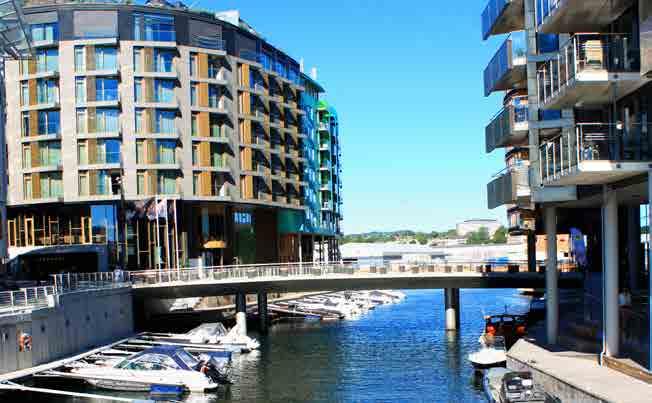
NATURALLY, NOBODY TRAVELS TO OSLO WITHOUT A HOTEL RESERVATION. IN ANY UNPLANNED OCCURRENCES RELATED TO AN OVERNIGHT STAY, HOWEVER, WE GET IN TOUCH WITH TOURIST INFORMATION CENTERS.
GRAND HOTEL
This deluxe full-service hotel on Karl Johans gate, Oslo’s celebrated main street, is surrounded by the best shops and entertainment venues in town. The hotel includes 274 elegant rooms and 54 suites, a fitness room, spa, and pool. The Grand Hotel, which first opened its doors in 1874, has legends and fascinating stories of its own.
Almost a century ago, it was frequented by Edvard Munch and Henrik Ibsen. Traditionally, every new Nobel Peace Prize laureate stays in the hotel’s Nobel Suite. Three restaurants and a bar also operate here.


Karl Johans Gate, 31 / www. Grand.no
SCANDING VULKAN
If you are fascinated with arts, culture, nightlife, and design, this hotel is your best shot, the hotel’s website reads and invites us to rooms with exceptional decorations and comfort.The hotel is located in Vulkan, by the River Akerselva, close to the hipster Grunerlokka neighborhood. Right next door is Mathallen, a mecca for anyone interested in food and drink experiences, a place with more than 30 businesses with one thing in common: they never cease to offer the highest-quality local ingredients to their clients. The Oslo City Center is just 15 minutes away on foot, and it takes 10 minutes by bus to reach the Central Station. The hotel proper displays a true celebration of modern design, colors, and unconventional furniture and accessories. The hotel’s strikingly avant-garde rooms, 201 in all, are “for young people of all ages.”
www.scandichotels.com/vulkan

THE THIEF
This exceptionally individualistic and elegant hotel in Tjuvholmen is the first among its peers in Oslo to have direct access to the Oslo Fjord. The Thief has 116 rooms and suites with private French balconies, also a penthouse with a terrace on the roof which, needless to say, offers an unforgettable panoramic view. Equally special is the hotel’s restaurant with a refined, exquisite menu and a rooftop terrace where you can while away relatively warm evenings enjoying cocktails.
The Thief also has an 800 square meter spa and a fitness room. Tjuvholmen / thethief.com
HOTELS 29 VOYAGER 13/2018
HOTELS
SAGA HOTEL
Another old hotel built in the 1890s, this boutique hotel was recently renovated and is located in the heart of the city, on a quiet street on the west bank surrounded by trees, with cozy buildings on either side, just a couple of minutes on foot from Bogstadveien.
The hotel has 47 rooms. Some single rooms have balconies. The hotel offers generous breakfast, coffee, or wine in the bar and snacks in abundance, and free internet access, of course. Nearby down the street, the hotel runs a restaurant, Fangst, eager to treat you to a mouthwatering mix of Nordic ingredients and auteur Japanese cuisine traditions.restaurantfangst. no/menu-eng.
Eilert Sundts gate, 39 www.sagahoteloslo.no
THON HOTEL ROSENKRANTZ
Thon Hotel Rosenkrantz
Oslo is a modern design hotel in the heart of Oslo, just a block away from Karl Johans gate, where, similar to elsewhere in Oslo, public transport or entertainment venues are no problem at all. The hotel has 151 rooms of different sizes, from standard single rooms to large suites with internet access, smart TV sets, Bose music systems, and private safes. The hotel serves breakfast in its restaurant, Brasserie Paleo, and offers a relaxation area on the 8th floor with a view of the Royal Palace Garden. The relaxation area hosts free suppers and coffee with snacks.`
Rosenkrantz gate 1 www.thonhotels.com
HOTEL BRISTOL
This hotel is also located near the city’s main street and offers 251 rooms and suites, fully equipped training facilities, a spa, and the Bristol Grill restaurant serving seasonal dishes. You can also enjoy live piano music at Vinterhaven/ Biblioteksbaren.
Kristian IV Gate 7 www.bristol.no
FIRST HOTEL GRIMS GRENKA
Another modern design hotel, the GRENKA combines the colors and voices of Norwegian landscapes and Oriental mysticism and sensuality. The hotel is found in the historical Kvadraturen district, near Karl Johans gate, from where you can simply walk to Oslo’s Central Station and Aker Brygge. The hotel offers 65 deluxe rooms, of which 10 are suites and some are as large as 70 square meters. The roof houses Q Lounge, an entertainment area and one of the most popular terraces in Oslo open from April to September.
Kongens gate 5 www.firsthotels.com
LYSEBU
uated near Holmenkollen, this hotel offers 85 rooms, walking trails, ski runs, and a ski resort nearby, pretty much at your doorstep. Built in the traditional Norwegian style in 1916, this hotel is located by the entrance of the Nordmarka area, a forested paradise on earth just 30 minutes from downtown Oslo, where winetasting rituals, lectures, and exhibitions are frequently held.
Lysebuveien 12 www.lysebu.no
FUGLEN
By day it’s a coffeehouse, by night, it turns into a cocktail bar and a vintage design shop. Fuglen opened its doors in 1963 as just a coffee shop. Top-quality coffee and tea are still prioritized by the owners. Fuglen’s barista, who happens to have won numerous championships, will prepare any type of coffee drink for you. At sunset, the flavor of coffee is complemented by the aroma of cocktails. Fuglen boasts both traditional cocktails and innovative mixes, along with bottled Norwegian beer and a list of seasonal wines.
The establishment’s vintage design shop has everything you can imagine: chairs, tables, lamps, plates, glasses, and so on and so forth. The interior’s Scandinavian style is predominantly from the 1950s-1960s, which is credited to the new owners and friends Einar Kleppe Holthe and Peppe Trulsen. Holthe won the Norwegian Barista Championship and Trulsen is an expert in Norwegian vintage design. “We wanted to keep this little piece of Oslo’s identity,” Holthe says.
Consequently, this place resembles a cozily arranged lounge more than it does a café. If any of the items surrounding you catches your fancy, you can always have its price included on your check – everything here is for sale. In 2012, Holthe and Trulsen opened another Fuglen in Tokyo. Norway and Japan, the owners say, are somewhat similar, especially when it comes to their attitude toward work, appreciation of quality, and minimalist design. Both Oslo and Tokyo Fuglen branches, with their relaxing, quiet atmosphere and vintage furniture, will make you feel at home.

Universitetsgata 2 / www.fuglen.no
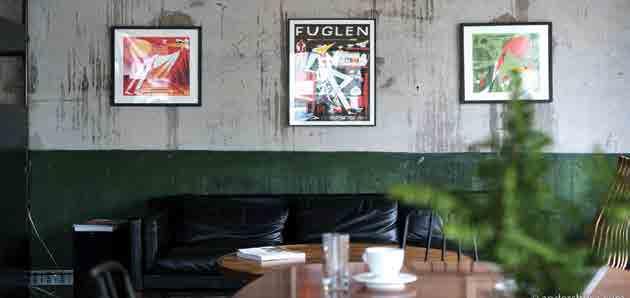
30 VOYAGER 13/2018
OSLO’S NEW FASHION DISTRICT
Promenaden is Oslo’s shopping district in the heart of the city. Those into fashion and design are strongly advised to visit it. Along with high-end brand stores, you can visit conceptual and exclusive shops of local fashion.


The district stretches along Oslo’s main street, Karl Johans gate, and overlaps the neighboring streets of Akersgata, Kongens gate, Prinsens gate, Øvre Slottsgate, and Nedre Slottsgate.
You can celebrate your shopping experience in the best restaurants the city has to offer.
STEEN & STRØM
Steen & Strøm is the largest chain of department stores in Scandinavia, which opened in Norway in 1797 and currently runs 52 outlets throughout the region. Here you can buy products from more than 62 brands and, at the same time, appreciate the store’s history and strong presence. For example, the first escalators in Norway were installed here in 1930. Today, this center in downtown Oslo occupies six stories to showcase fashion and style, beauty products and food.
Nedre Slottsgate 8 www.steenogstromoslo.no
BYPORTEN
When it comes to shopping, Byporten defines the term perfect. Located near Oslo’s Central Station amid numerous other attractions, it combines pretty much everything: more than 70 stores and 12 restaurants offering everything you may ever want to buy, taste, present as a gift, or share.
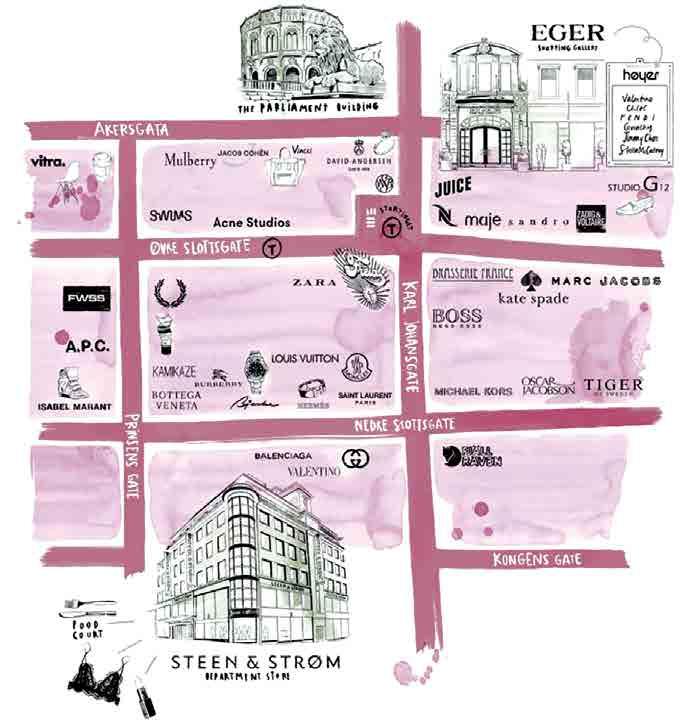
PALEET
Paleet is designed for more relaxed, elegant shopping rituals. The center incorporates more than 30 stores and offers its customers top-quality services. Paleet is located on Karl Johans gate, the street known among the locals as the main street and famous for an abundance of refined cafes, bar/restaurants, and brand stores.
Karl Johansgate 37-43
www.paleet.no
AKER BRYGGE
Aker Brygge is an absolute must-see if you appreciate modern, fashionable accessories and clothing and the latest products from large and famous brands. This mall includes numerous bars and restaurants, and its more than 30 stores sell watches, footwear, books, jewelry, and even food.
Bryggegata 9
www.akerbrygge.no
GLASMAGASINET
The brand stores that line up in this district include: Bottega Veneta, Burberry, David Andersen, Gucci, Hermes, Kamikaze Luxury Shoes, Louis Vuitton, Marc Jacobs, Mulberry and Urmaker Bjerke. If you are looking for cosmetics, accessories, and other similar products, you can visit other outlets like Eger, Steen, or Strøm.
Promenaden.no
The place also features Egon, the largest restaurant chain in Norway, and Scandic Hotel.
Jernbanetorget 6 www.byporten.no
Established in the 19th century, GlasMagasinet is one of the oldest malls in Oslo bringing together large brand stores and offering a wide array of refined glass accessories and tableware, gifts, perfumes, and jewelry. It also has a shop selling everything one may need for a wedding ceremony. Stortorvet, 9
www.glasmagasinet.no
SHOPPING
31 VOYAGER 13/2018
NORWAY DESIGNS
Norway Designs is one of the oldest areas for interior design stores selling Nordic and other design items and accessories. It is your place to go for ceramics, silver jewelry, fine paper products, glass, kitchen utensils, books, furniture, textiles, and other decorative works. It is an exhibition of sorts to plunge into and lose yourself in.
Stortingsgt. 28, 0161 www.norwaydesigns.no
MAGMALOU
This store, located in the fashionable Frogner neighborhood, offers the latest vintage clothing, footwear, and accessories exclusively for women. The store’s beauty salon offers what is known at Magmalou as “star treatment.” Run by makeup artist Marthe Kvenli Valeberg, who has won prizes for her work, Magmalou opened its doors in 2011 and, thanks to its popularity among women, is still going strong.
8 Skovveien www.magmalou.no
FROKEN DIANAS SALONGER
Silk ties, handbags adorned with prints from the 1960s, pink leather belts, oldfashioned jewelry, Italian sunglasses from the 1950s, and furniture from the 1800s through the 1980s make only a small portion of the unconventional items with stories of their own found in the Frøken Dianas Salonger vintage store. You can pretend you are visiting an exhibition, the only difference being that you will not leave empty-handed. The name itself, Frøken Dianas Salonger, comes from Ibsen's play Hedda Gabler, in which it acts as a shady establishment where red-headed singer Diana offers pleasures of all kinds to upper-class men.
Markveien 56
www.frokendianassalonger.no
MOODS OF NORWAY
Since its inception in 2003, this fashion house has been producing unusual, characteristic, and sometimes even showy clothing enabling it to remain in the spotlight. The company, in its own words, draws on Norwegian landscapes, character, and urban life.
The Moods of Norway website reads, “Our ultimate goal is to create happy clothes for happy people.”
3 Stortorvet www.moodsofnorway.com
ESAIAS SOLBERG AS
Esaias Solberg invites all those enamored by shiny luxury items.
The store has been around since 1849 and remains a popular place for posh antique and vintage items.
Be it a diamond necklace, a Rolex watch, or an antique silver ring, Esaias Solberg has everything to feast your eyes on. Most importantly, as they themselves say, it is all offered for half the price, because they make many pieces themselves, as well as redesigning the used pieces they buy.
27 Dronningens gate
FUTURA CLASSICS
This interior lighting, furniture, and accessories store displays classic Eames chairs of every color, Verner Panton pot hanging lights, George Nelson 1947 bubble lamps, and the latest items from Tom Dixon and Orla Kiely.
For a more Nordic emphasis, make note of Norway's Northern Lighting and the Gubi Danish brand. A visit to this store may also prove to be an educational experience if you are into Nordic design and its exceptional examples.
Olaf Ryes Plass 1
www.futuraclassics.no
NORLIS ANTIKVARIAT
Norlis Antikvariat, a genuine paradise on earth for bookworms, reiterates that no matter how noisy and big Oslo may appear, you can always find peace and quiet, a comfy nook, a refuge full of books, and silence. Since opening in 1890, the store has been offering its patrons big literature and rare collectible books alike.
18 Universitetsgata f: Norlis Antikvariat
ORIGINAL AND UNCONVENTIONAL STORES
IN OSLO BYPASSING THE STANDARD TRADE ROUTE.
LUCK CONCEPT STORE
Nowadays, a city without a hipster neighborhood is simply unimaginable, and Oslo is no exception to the rule. Make note of the word Grünerløkka. It used to denote Oslo’s industrial sector on the Aker riverbank, which artists and youth have transformed into a stylish
neighborhood – albeit overly expensive even for Oslo. The locals compare it to Shoreditch in London and Williamsburg in New York, and recommend a variety of food, shopping, artistic, and recreational areas. Luck Concept Store is one of them.

Everything you see beyond the store’s jungle-like entrance is for sale, including clothes, books, furniture, design accessories, and potted plants of all sizes.
Aleksander Sahr is the store’s designer known for his eclectic style. In a nutshell, both the environment and the items for sale are artistic here. You may even come across something – be it a blue shirt, a fluffy scarf, or a odd-shaped purse – to make you exclaim, “Where have you been all my life?”
Grüners gate 9
www.luckoslo.com
SHOPPING 32 VOYAGER 13/2018
NO. 52
No. 52 is one of the most famous stores in hipster Grünerløkka. It sells both exciting vintage items of top quality and new high-end products. The store’s clothes and footwear for both men and women are exceptional, manufactured by different brands, and sold at liberal prices.

EMBLA KERAMIKK
Embla Keramikk is a workshop and store in one that produces and displays some of the finest original ceramic pieces and supplies relevant tableware to Maaemo, Oslo’s famous three Michelin Star restaurant. Even from the street you can see Embla Keramikk’s ceramic artists at work, creating exceptionally original auteur pieces, some small enough to grab as a souvenir.
Hegdehaugsveien 14
www.embla-keramikk.com
BRUDD
The shelves in the BRUDD store overflow with works from prominent ceramics and glass artists, and jewelers. It is a store and a gallery at the same time, and it offers a wide array of items from Sara Skotte turquoise china bowls and Anne Ka Munkejord wine vessels with lemon-shaped legs to Dina Hald brooches featuring different birds.
Markveien 42 www.brudd.info
PENTAGON
Judging by the name, it must be a martial arts store, which it is. Pentagon offers Viking attire, uniforms, daggers, masks, and all kinds of other combat accessories that you would never imagine you would need. One of the reviews reads that it is a fun place for adults, because everyone may want once in a while to have fun with vintage antique items.
Storgata 37
SINSEN BRUKTHALL
Sinsen Brukthall, one of the largest outdoor consignment shops in Norway, offers a bunch of well-worn and wellpreserved items describing the everyday details of life in Norway in the past 100 years. It is certainly worth dropping by if you are looking for affordable, entertaining, and gripping gifts instead of standard tourist souvenirs.
Sinsenveien 11
RUTH 66
The name Ruth is an archaic Nordic female first name, yet its slightly modified form in English reads as route, a pun intended by the store’s owner Hege Nylund – a combination of the obsolete Norwegian and the legendary Route 66 in the US.
Everything here is associated with American pop culture and reminds one of typical movies, songs, or personal adventures. In a word, it is an American store in the hipster section of Oslo.
Torshovgata 3. www.ruth66.no
KOLLEKTED
This place showcases cherry-picked harmonizing furniture pieces and interior design items, such as cutting boards, candles, marble stands, terracotta vases, and much more.
The address below is your destination if you wish to meet up-and-coming Scandinavian designers with unique signature styles.
Rathkes gate 4 www.kollektedby.no
NESEBLOD RECORDS

NATURENS MANGFOLD
Naturens mangfold is not just a store but an entire world in itself, a world created by Rune Frøyland, a collector of minerals, meteorite fragments, and insects who owns all the equipment and gear a researcher and explorer needs.
This world draws on Rune’s insatiable curiosity and love of nature, environment, research, and science. The store, whether by accident or design, is associated with the Botanical Garden of Oslo or the Natural History Museum, both found around the corner. Consequently, either the garden and the museum will lead to Rune’s store, or Rune will inspire you to familiarize yourself with Norway’s nature at a museum level.
Ullevålsveien 13
RÅKK & RÅLLS
Råkk & Rålls is one of the most famous and reputable record shops across Norway. This place is not fixated on one particular genre or another –here they will offer you a wide choice of musical diversity at your leisure in the store’s café.
Akersgata 39
Neseblod Records is an iconic heavy metal shop in Oslo, often referred to as the museum of this genre. Fans from all over the world come to Norway just to visit this store, and they couldn’t care less about its name which translates as nosebleeds.
Schweigaards gate 56
52 Thorvald Meyers gate
33 VOYAGER 13/2018
NORWAY’S CONTROVERSIAL AND CONSERVATIVE CONTEMPORARY ART
 IRINA POPIASHVILI
IRINA POPIASHVILI
I came to know Norway through Knut Hamsun’s Mysteries. For quite some time, I saw this country through the eyes of Hamsun and exactly the way Johan Borgen, my other favorite Norwegian author, describes it in his Lillelord. Wilfred Sagen, Nagel, and Dagny Kielland are the characters who inspired me to see the poor Oslo-Christiania, the city of fjords, of the early 20th century. Back then, Norway, which had yet to discover oil fields, was considered the least developed country in Scandinavia. Yet the poverty described in Hamsun’s Hunger appeared to me only in the form of the houses and street sections preserved as exhibits in the Ethnographic Museum of Oslo. When I visited Norway in 2006, the country had nothing in common with what the authors described so vividly in the early 20th century.
In Norway, I paid a visit to contemporary art collectors Rolf and Venke Hoff, a couple actively engaged in the collection of contemporary art pieces. I first met them at the Contemporary Art Fair in Marseille, a smaller event hosted by Marseille-based
gallerist Roger Pailhas in his gallery. Pailhas personally selects and invites representatives of different galleries and his friends, all prominent European collectors, to spend quality time together in a four-day event in Marseille. A large portion of the fair is set aside for conversations among gallerists, museum delegates, and collectors, dinners, sightseeing, and promenading the city. And that is where I became acquainted with the Hoffs.
The residence of Venke and Rolf Hoff, close to downtown Oslo, is a historical building in what used to be the city’s suburbs in the early 20th century. Near the residence, one finds the winter studio and home, known as the Ekely estate, where Edvard Munch, the most celebrated Norwegian artist in the 20th century, spent the last 28 years of his life. The estate was demolished, but the winter studio built in 1920 is open to tourists. An artist colony has also been operating on the site since the 1950s, a place where a group of artists live and work.
ART
34 VOYAGER 13/2018
Rolf Hoff and his wife Venke started collecting artwork in the 1980s. Rolf owns Signex, a large advertising company, and a large portion of the couple’s collection is displayed in the company’s offices. The company’s headquarters, for example, features Banks Violette’s installation in the vestibule and Piss Christ, a controversial photo by Andres Serrano, on the wall. A part of the collection is stored in the company’s warehouse.


Rolf Hoff invited me to his office. As he led me to the warehouse, he revealed to me that his wife knew nothing about this stash, because he would sometimes buy artworks unbeknownst to her, in secret. The Hoff collection includes two Georgian artists, Tamuna Sirbiladze and Giorgi Khaniashvili.
In 1988, the Hoffs acquired the historical Henningsvær lighthouse on the Lofoten Islands. This lighthouse in a fishing village had been long inoperable, in need of a new owner to take care of this monument of national heritage and save it from ruin. The Lofoten Archipelago is located in the Arctic Circle, which means that it is far, far away from Oslo. The place is accessible only by plane or boat, while getting as close as possible to the area takes about two days by car. At first, the Hoffs pitched the lighthouse to various artists as an artistic residence, a role perfectly fulfilled by the lighthouse. Gradually, artists started to flock to the fishing village. The Hoffs hosted scores of guests in summer at first, and as the Lofoten Islands kept drawing the growing attention of the artistic community, they established the Lofoten Festival.
There was an old caviar factory in the fishing village, built in the 1950s and long inoperable. In 2006, Venke Hoff talked her husband into buying the factory. At first, all they wanted was to save the building, but later Venke Hoff conceived the idea of modifying it into an exhibition space. They decided to use it to exhibit a part of their collection, examples of contemporary Norwegian and international art collected in the course of 30 years.
Today, the Kaviar Factory is a local cultural hub hosting annual exhibitions and an educational center serving the local population.
THE FAÇADE OF THE EXHIBITION SPACE READS KAVI FAC ORY. AT FIRST GLANCE, BECAUSE OF MISSING LETTERS, IT MAY COME ACROSS AS AN OLD TIME-WORN PIECE OF SIGNAGE. IN REALITY, HOWEVER, IT IS A CONCEPTUAL WORK BY FAMOUS GERMAN ARTIST MICHAEL SAILSTORFER. THE DOOR HANDLES WERE CREATED BY CONTROVERSIAL NORWEGIAN ARTIST BJARNE MELGAARD. BORDERING THE SEA ON ONE SIDE, THE EXHIBITION SPACE, ALONG WITH THE LIGHTHOUSE, IS THE MOST POPULAR TOURIST DESTINATION ON THE LOFOTEN ISLANDS.
35 VOYAGER 13/2018
In January-February 2018, the Faurschou Foundation, in cooperation with the Kaviar Factory, organized an exhibition of Yoko Ono’s ONOCHORD light installation at the Henningsvær lighthouse. Yoko Ono’s work is instructive in nature as she offers the viewers to send an I Love You message to one another using the ONOCHORD code, a sequence of blinking lights invented by her: one lighthouse blink stands for I, two for Love, and three for You. The Lofoten event marked the first time when the ONOCHORD message was send from a lighthouse. With the northern lights, white mountains, the sea, and darkness in the backdrop, it was much bigger than a message exchanged by two people – it was from humankind addressing Mother Earth. Throughout the exhibition from January 20 to February 28, the ONOCHORD message would be sent from the lighthouse non-stop, 24 hours a day.

The Hoff collection is also significant in that Rolf Hoff has always supported and stood by Norwegian artists Eide Einarsson and Bjarne Melgaard. Einarsson’s installations and paintings are
mostly textual or graphic, and Hoff has repeatedly supported him in printing and assembling his works.

Bjarne Melgaard presently lives and works in New York. His largest collection in Norway is owned by Hoff. Recently, Melgaard, who is the most famous Norwegian artist next only to Munch, decided to create a sculpture that would double as his home and studio near the Hoff residence and Munch’s Ekely Estate. To this end, he engaged Snøhetta, a reputable Norwegian architecture and design company commissioned to design the Oslo Opera House and the 9/11 Museum Pavilion in New York. According to the plan based on Melgaard’s sketches, it will be a UFO-shaped house.
The artist’s project failed, though, because the artists’ colony at Munch’s studio strongly opposed the idea. The opponents believed that this building/sculpture would distort the environment where Munch used to draw inspiration. After all, it is here that he painted many landscapes in his later years.
ART 36 VOYAGER 13/2018
To Melgaard, however, it is a project of ultimate importance. He refers to it as A House to Die In, this way inverting Scandinavian architectural ideas of durability. To the author, it stands for the final destination and reflects the transience of life. The structure, with a black wooden façade, builds on dwarf-like figures. In designing this house, Melgaard was inspired by the homes of drug lords, like the poppy palaces of Afghan opium barons, where one finds all kinds of mixes of architectural styles.
That’s why he commissioned a “drug room” which, Snøhetta’s architects say, will be suspended from the house’s walls and ceiling, intended to create a feeling of disorientation, just like narcotics.
Eventually, on August 30, 2018, Oslo’s City Council denied a building permit for Melgaard’s house/sculpture project, an endeavor launched in 2011. Although the local and national monument protection authorities upheld the project, the Oslo Municipality gave priority to the demands of the local population and instructed the authors to find a different location for the building. In his text message to Norwegian Aftenposten newspaper, Melgaard wrote, “There is great opposition to new things in Norway.”
Indeed, this ambitious project failed in Oslo. Still, it is commendable that private collectors, with their exhibition spaces and private museums, often support projects rejected by state-run museums and public spaces for financial or political reasons.


The Astrup Fearnley Museum of Modern Art, for example, is one of the largest and most popular exhibition spaces in Oslo. It is a private museum that started with the collections of two foundations established by a family owning a prominent maritime transport company.

The museum opened in the 1990s and, in 2012, relocated to a new museum facility designed by architect Renzo Piano. Along with Norwegian artists, the museum’s permanent exhibition displays American and European pop-art, German abstractionism, and the Young British Artists. One of the most acclaimed exhibits of the museum is Jeff Koons's porcelain sculpture of Michael Jackson with Bubbles, his favorite chimpanzee. This work by Jeff Koons, a quite controversial artist in the earlier period of his career, was purchased by the museum at an auction for 5.1 million USD.
THUS, IF YOU CANNOT MAKE IT AS FAR AS LOFOTEN IN NORWAY, THE ASTRUP FEARNLEY MUSEUM IS DEFINITELY YOUR MUST- SEE DESTINATION.
© reddit.com
37 VOYAGER 13/2018
"A House To Die In"
NORDIC CUISINE

CUISINE
38 VOYAGER 13/2018
I first read this country in my favorite childhood book. Yes, I read it. As a rule, colors, sounds, smells, and tastes are first perceived through reading. A mother, a father, and their eight children often shared their joyful meals in a cramped apartment in the city or a reeking forest house. I remember lots of berries, fish, the aroma of the freshly boiled, frothing milk, and the amazing adventures of the eight kids.
Later, weightier authors entered my life, with some of them even having special ties to the past of my city. Around came Nagel from Mysteries, my girlhood flame, who forever imprinted this land of northern lights, brief summers, and long cold winter nights on my mind.
Today, besides girlhood infatuations, Norway and I are bound by other experiences, and my sense of taste, which serves as my personal compass to navigate the world map.
In terms of reading gustatory perception, Norway is about two key concepts: quality products and authentic taste, which make up an experience just as impressive as northern lights contemplated from icy fjords. What is Norwegian cuisine like, one sustained by the experience of fishers, travelers, and hunters? It is just like how contemporary Norwegian literature combines the semi-feral mythical spirit of ancient Scandinavian sagas and modern European literary sentiments. The best grain crops and vegetables, a touch of spices, wilder leafy greens, fresh smoked or canned meat, an amazing diversity of berries, fish, and seafood – if there is a gastronomic Valhalla on earth, it is here in the North.
What would be our first stop? Fish, of course! This Nordic country enjoys one of the longest coastlines in the world, which defines the abundance of sea goodies here. Little Norway is the second largest seafood exporter in the world. No matter where in the world you are, your diet, albeit unbeknownst to you, does include some of the local sea riches.
All kinds of Norway’s sea products, such as salmon, mackerel, cod, mussels, mollusks, scallops, oysters, lobsters, octopuses, and many others, are used in the cuisines of countries across the world. Naturally, they make up a significant portion of Norwegian cuisine.
NORWAY’S FISHING INDUSTRY IS CLOSELY TIED TO EXCITING GASTRONOMIC TOURISM ADVENTURES. FOR EXAMPLE, WHILE OBSERVING THE NORTHERN LIGHTS IN WINTER, YOU CAN ENJOY EXQUISITE STURGEON; OR, IF YOU PLAN TO VISIT NORWAY’S LOFOTEN ARCHIPELAGO IN MARCH, YOU CAN COMPETE IN THE LOCAL STURGEON FISHING CHAMPIONSHIPS.
Norwegian cuisine uses a wide array of fish processing rules and techniques, such as drying, smoking, thermal processing, or brining in a variety of liquid mixes. Fish – raw or half-cooked, preserved in a number of ways, dried, or marinated – is a Norwegian delicacy.
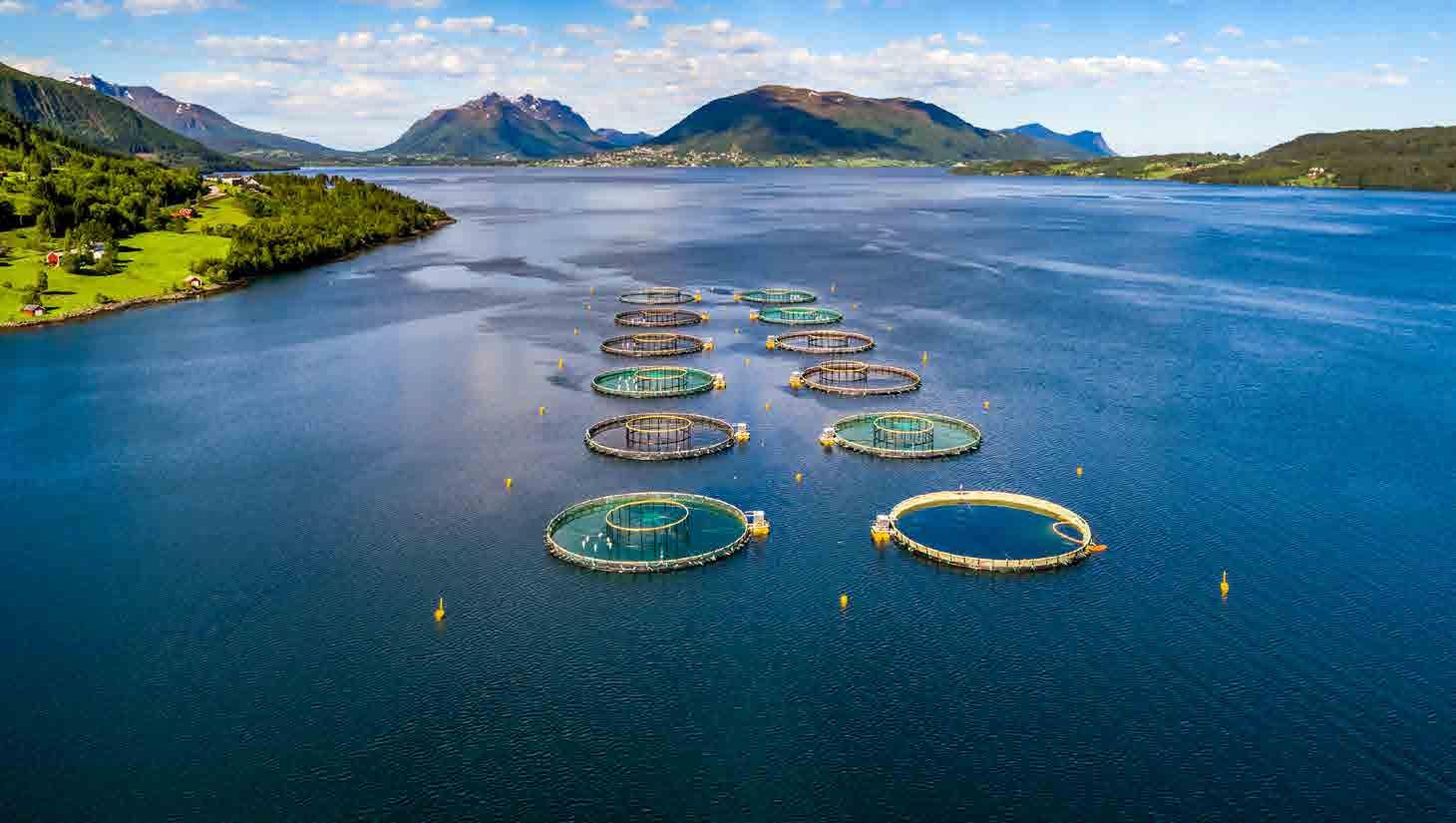
ANPHIMIADI 39 VOYAGER 13/2018
DIANA
If, besides dried cod, freshly caught salmon, or fresh mussels, you need a more intense experience, then you may find the tørrfisk (stockfish) drying method especially exciting. In this process, fish is nearly decomposed, and every aspect is given due attention, such as temperature, timing, and texture. This recipe must have been invented by fishers in time immemorial where weeks or even years at sea compelled one to come up with a variety of methods to enrich one’s diet.
Equally exciting technological processes are involved in the preparation of other delicacies. Rakfisk, for example, is made from elaborately fermented trout or other freshwater fish, while mølje consists of the roe, fillet, and liver of cod.


Skrei is a special kind of Norwegian cod migrating from the Barents Sea to the north coast of Norway and famed for its exquisite taste. Only the local fishers are allowed to catch this fish, and the whole process is under strict control, which is why this cod, with its delicate white and exceptionally oily texture, is so expensive and popular. Generally, Norwegian environmentalists exhibit exemplary commitment to the local fauna, including fish, and the fish industry is under a microscope to preserve the diversity of fish species.
The special taste of Norway’s seafood and fish is due to the country’s cold and clean water, which enables fish to grow and feed naturally, step by step, hence the exceptional taste and quality. Fish dishes are relevant in every region of Norway, though regional differences produce an amazing culinary diversity. Besides Arctic lobsters and smoked cod, you will find a variety of dishes using different cooking methods and fish caught especially for you. Norway’s coastline is rich in small markets where you can buy or taste fish. For instance, the famous Ravnkloa Fish Market in Trondheim, where fish are sold or cooked to suit your taste, or the historical Fish Market in Bergen offering mouthwatering organic sea products from local farmers since 1276, or the Stavanger Fish Market where you can enjoy fresh mollusks for breakfast.
In Norway, fish are used to prepare a variety of dishes, from plain British dishes like fish and chips to sushi, special butter, sauces, diverse salads, pastas, or tacos. Most importantly, however, sea products here are always fresh and yummy with a touch of the frost and sobering breeze of the Nordic coast to go with its natural taste.
Where can we eat fish? Everywhere: in the port at dawn, in the hotel, in a simple local diner, in a small fish market, by the sea, river, or lake, or – which is even easier – make friends with a fisher and enjoy both the process of fishing and its delicious outcomes. Do you need any further, more detailed recommendations?
If you are up for gastronomic games, you will need to memorize these tongue twisters.
• Røkelaks is smoked salmon that you can buy whole or sliced to order with complementary mustard, which goes perfectly with oily salmon’s slightly tense delicacy.

• Ørret is brown trout slightly sweeter than salmon.
• Brunost is goat cheese, brown in color and sweet to taste, which you must slice into beautiful pieces and enjoy in a cozy comfortable environment.
• Sild is fantastic herring to be eaten in combination with Flatbrød unleavened bread or soft Lefse flatbread. Every dish here perfectly harmonizes with seaweed salt. As for desserts, tangy coffee and local varieties of waffles or berry preserves will make your day.
CUISINE
40 VOYAGER 13/2018
Norway is a genuine paradise for meat lovers. Regardless of your preferences in this department – be it lamb, venison, elk, or quail – scrumptious dishes from fresh game are inseparable from traditional Norwegian celebrations. Certain rules apply here, too. For starters, the meat of wild or domesticated animals is used almost fully, and many dishes employ offal and secondary parts. What matters here is using up everything that nature grants us with maximum efficiency. Hunting seasons are strictly defined, and local organizations enforce tough recommendations to preserve species diversity.
Whale meat used to be actively used in Norwegian cuisine. Although presently it is not as widespread, you may come across some Norwegian restaurants serving it.
Similar to every country with a long history of animal husbandry, Norway is famous for its cheese. Local varieties, though pretty modest in number, boast exclusivity and high quality.
Norwegian brown cheese, which is prized throughout the world, is consumed here with Norwegian waffles, a local variety of bread. To taste, brown cheese has a specific touch to it, and it takes an individual, refined taste to appreciate it.
Lately, Norway’s cheese industry has grown richer and more diverse. While continuing to produce traditional cheese varieties from quality milk, such as Gamalost and Pultost, Norway has seen a genuine cheese revolution, with products from more than 150 cheesemakers drawing attention in the local and international markets alike. Consequently, Kraftkar, a Norwegian cheese produced by a small cheesemaker, was recognized as World Champion. This variety of cheese with a bloomy rind is hailed for its special texture and taste. Norway’s cold climate provides excellent conditions for cheese ripening and defines the exceptional taste.
Norwegians are especially fond of milk and dairy products, including cold buttermilks. Milk, an integral part of Norwegian breakfast alongside berry preserves and unleavened bread, is used in porridges and other dishes.
Thus, if you happen to be visiting Norway for holiday, especially Christmas, you probably should know what a marvelous gastronomic feast awaits you. Just check the list and make sure you haven’t missed anything.
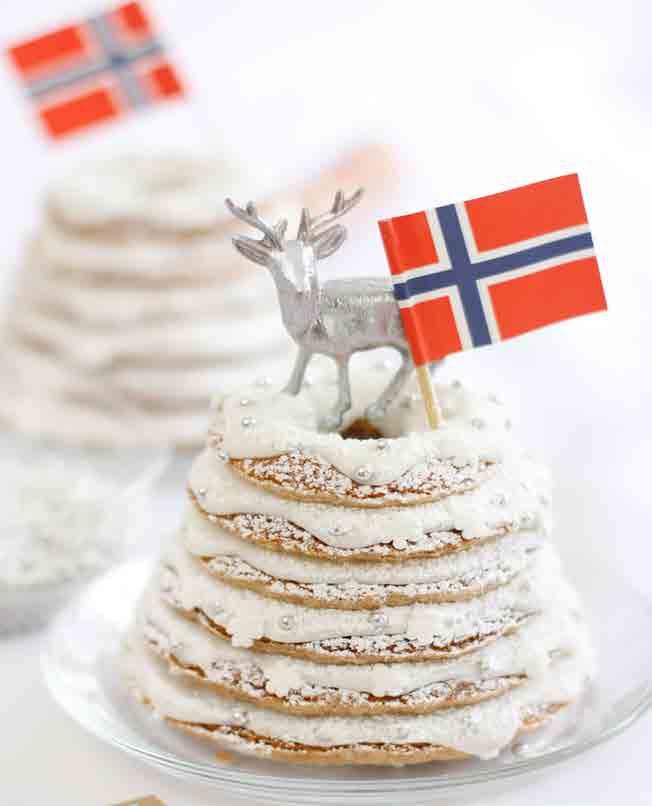
Ribbe is a dish consisting of roast pork ribs usually accompanied by sauerkraut and potatoes, also Christmas sausages, fried meatballs, and sauce. This dish is an essential part of Norwegian Christmas and Easter celebrations, and so are dried and smoked lamb ribs, and also Lutefisk, dried fish carefully soaked and baked in the oven. It is usually served with potatoes, ham, meat stew, peas, and mustard.
Equally wide is the choice of festive desserts. For example, Multekrem, a rich dessert made from whipped cream, and Christmas rolls and pastries. And last but not least, beverages, such as Akvavit distilled spirit flavored with a variety of herbs, or Glögg wine flavored with spices, almonds, and raisins, and also beer.
It does not matter where in particular this gourmet adventure of yours takes place, in a warm Norwegian house or a restaurant, you can always count the excellent taste of prime meat and fish and other top-quality organic products.
Equipped with the latest state-of-the-art technology, Norway’s restaurants are pushing the gastronomic envelope. And this culinary revolution rests primarily on local products, genuine, quality, and cherry picked. This is why scores of connoisseurs flock to different cities in Norway to enjoy the masterpieces of acclaimed local chefs. Norway is a new untapped island of gastronomy that has yet to be duly studied.
FIRE, SMOKE, SALT AND DRAMA, QUALITY, FRESH AND LIVELY, RAW AND DRIED, FISH AND MEAT, SPICES AND SEA SALT, HISTORY AND MODERNITY, TRAVEL AND ETERNAL LOVE OF THE NORDIC COUNTRY – THAT IS WHAT NORWAY AND NORWEGIAN GASTRONOMY ARE ALL ABOUT.
41 VOYAGER 13/2018
RESTAURANTS
MAAEMO

Maaemo is Old Norse for Mother Nature, and the restaurant’s concept focuses on creating clean, bright Norwegian flavors. Maaemo is a three star Michelin restaurant, so dining here is an adventure in itself. Even the menu here seems to invite one to journey through Norway’s landscapes.

STATHOLDERGAARDEN
“Fantastic food,” “the finest restaurant in Oslo,” “delicious dishes and wine,” this is how reviewers characterize the Statholdergaarden restaurant housed in a 17th century building in downtown Oslo. The restaurant comprises five uniquely designed rooms of different sizes. The Cleopatra Room, for example, features Northern Europe's most impressive plasterwork ceiling depicting Cleopatra’s death. The restaurant’s ceilings are also adorned with Egyptian figures and Late Baroque and Early Rococo details. In 1993, the establishment’s owner and chef Bent Stiansen became the first Scandinavian gold medal winner of the Bocuse d'Or. Every morning he joins chef Torbjørn Forster in creating a six-course gourmet menu full of surprises. The menu varies according to the time of the year and uses the finest Norwegian products. Stiansen cherishes the restaurant as a dining room at home. In other words, one may say that he is hosting his guests at his own home.
Prices: A three-course meal at Statholdergaarden costs 600-800 NOK, a six-course meal 1,395 NOK with additional 1,270 NOK for wine pairing.
Rådhusgate 11 / www.statholdergaarden.no
The restaurant’s innovative kitchen uses only organic and natural ingredients to offer signature dishes made with prime meat, seafood, fish, vegetables, berries, and leafy greens.
Esben Holmboe Bang, the restaurant’s chef and co-owner, was listed as one of Time Magazine’s 100 Most Influential Chefs in the World in 2013.



The restaurant has just eight tables in the main dining room as well as a private Test Kitchen table, which has a direct view of the chefs at work and the modern skyline of Bjørvika, Oslo’s central neighborhood.

The seasonal menu costs 2,800 NOK, and additionally 1,800 NOK for wine pairing.

For a fuller experience, the chef recommends dedicating an entire evening to the restaurant, and booking is preferable.
Schweigaards gate 15b / www.maaemo.no
GALT

This restaurant in Oslo’s Frogner neighborhood will welcome you to a relaxed atmosphere and traditional Norwegian cuisine targeting gourmet connoisseurs. The restaurant serves a set six-course menu with optional extras like caviar, cheese, oysters, and cured meats. Wine is perfectly paired with meals and Galt’s black coffee is perfection embodied.
The restaurant’s dinnerware seems to be adorned with images of Norway’s sky-like ornaments. Although the word galt means wrong in Norwegian, nothing about this restaurant is wrong. The kitchen crew is run by Bjørn Svensson and his four colleagues. Galt's acquired its Michelin star on their first try in 2018.
Frognerveien 12 / www.galt.no
42 VOYAGER 13/2018
KONTRAST
Kontrast is a modern Scandinavian restaurant in a new, modern neighborhood. It is a genuine gourmet paradise on earth, where the finest Norwegian organic products are used on a daily basis to create new dishes. The restaurant has one Michelin star. The meals are mediumsized, so you can keep ordering them one by one until you feel sated.
TJUVHOLMEN SJØMAGASIN
The restaurant also offers combo menus: six (950 NOK) and 10 courses (1,450 NOK) with an additional 850 NOK and 1,250 NOK for wine pairing, respectively. Make sure you save some room for the delicious complementary Kontrast desserts.
“The end result is never better than the quality of the product you start with,” says Kontrast chef Mikael Svensson, a man voted one of the best 300 chefs in the world.

Maridalsveien 15 / www.restaurant-kontrast.no
DØGNVILL BURGER VULKAN
The name of this restaurant speaks for itself. Døgnvill Burger Vulkan is located in the new, energy-efficient neighborhood of Vulkan, and it is the place where you are headed if you are looking for the best burgers in town.



Døgnvill burgers use beef from cattle grazing in the environmentfriendly Jæren area, fresh vegetables, and fresh bread from organic grains. To complement your burger, the establishment offers a wide choice of beers, wines, and cocktails.

For dessert, the restaurant offers rich creamy milkshakes made from premium Norwegian ice cream. Vegan and vegetarians will also find burgers matching their preferences.
Vulkan 12. www.dognvillburger.no
The chefs at Tjuvholmen Sjømagasin agree that the preparation of a good meal starts with simple ingredients. Located across from the Astrup Fearnley Museum, this restaurant boasts a sea of fish and seafood products. The establishment is divided into several areas: the main restaurant, the open Chambre Separée, the Fish Deli, and the Conference Centre. As you enter, you cannot help but to admire the lobsters and king crabs in the aquarium and catch a scent of fish and shellfish wafting from the panoramic kitchen out into the dining room.
The restaurant’s team is well aware of the importance of using fresh seasonal ingredients, which is why Tjuvholmen Sjømagasin is a holder of the Norwegian Foodprint badge, which means that you can enter without a second thought: this place is the crème of the crop serving the finest organic seasonal Norwegian food
Tjuvholmen allé 14 / www.sjomagasinet.no
SANGUINE
The Sanguine brasserie occupies the lobby of the Opera House and its outdoor waterfront section. Dropping by for a cup of coffee or to grab a snack in the afternoon is a great idea. But Sanguine is about far more than just snacks. It offers a variety of fascinating and pleasant flavors, from simple fish and shellfish soup to four-course dinner and a kid’s menu.
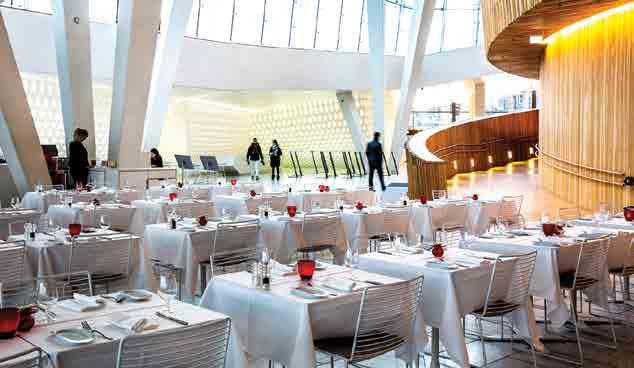
The brasserie works late hours whenever performances are held at the Opera House.
Kirsten Flagstads plass 1/ www.sanguinebrasserie.no

43 VOYAGER 13/2018
VIPPA
The port is a place where all kinds of people mingle and then head toward the city for a shorter or longer stay. Recently, scores of immigrants have flocked to Oslo, and there has been no consensus so far concerning whether or not Norway sees it as a problem, and if so, how it plans to deal with it. Vippa is an innovative social and business model launched in Oslo’s port last year to engage young immigrants in the food industry and facilitate their social integration. Each café or diner here showcases the gastronomic culture of immigrants: Aleppo shawarma, pancakes from Eritrea, and Tex-Mex chili (that is, Mexican cuisine assimilated into the Texan context). These youth, and many others in this space, enrich Oslo with their special, colorful, vibrant cultures. Personal stories heard here speak of ethical relationships, multicultural ties, and support for immigrants’ education and startups as part of Vippa’s philosophy.
MATHALLEN FOOD HALL
Mathallen opened in an old cast iron foundry on the Aker riverbank in 2012. This innovative project shook Oslo’s culinary culture and presented its significance to the community from a different angle. As for tourists, Mathallen has turned into one of the favorite spots to enjoy diverse dishes and snacks.
This vast space brings together different types of restaurants and eateries, including European and Asian cuisines, the finest Nordic fish/seafood and sweets, Italian ice-creams, special coffeehouses and teashops, wine bars, and many others. All these yummies are available under one roof, or in one hall, as the name of the establishment reads.

17, Maridalsveien. www.mathallenoslo.no
Visit Vippa if you are hungry in Oslo and curious about how the process of accepting differences works in a homogenous, clearly monolithic society. According to witnesses, it happens here on a daily basis, at the common tables both indoors and outdoors.
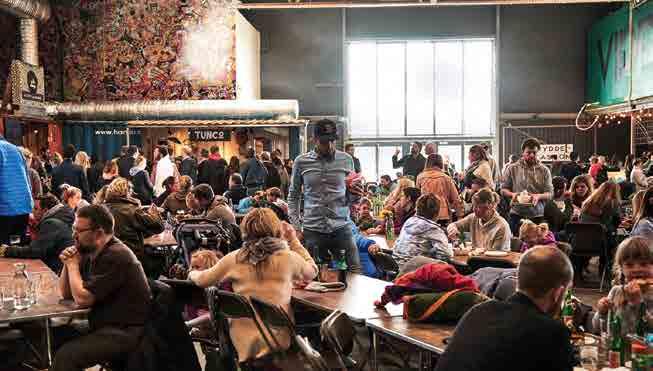
Akershusstranda 25
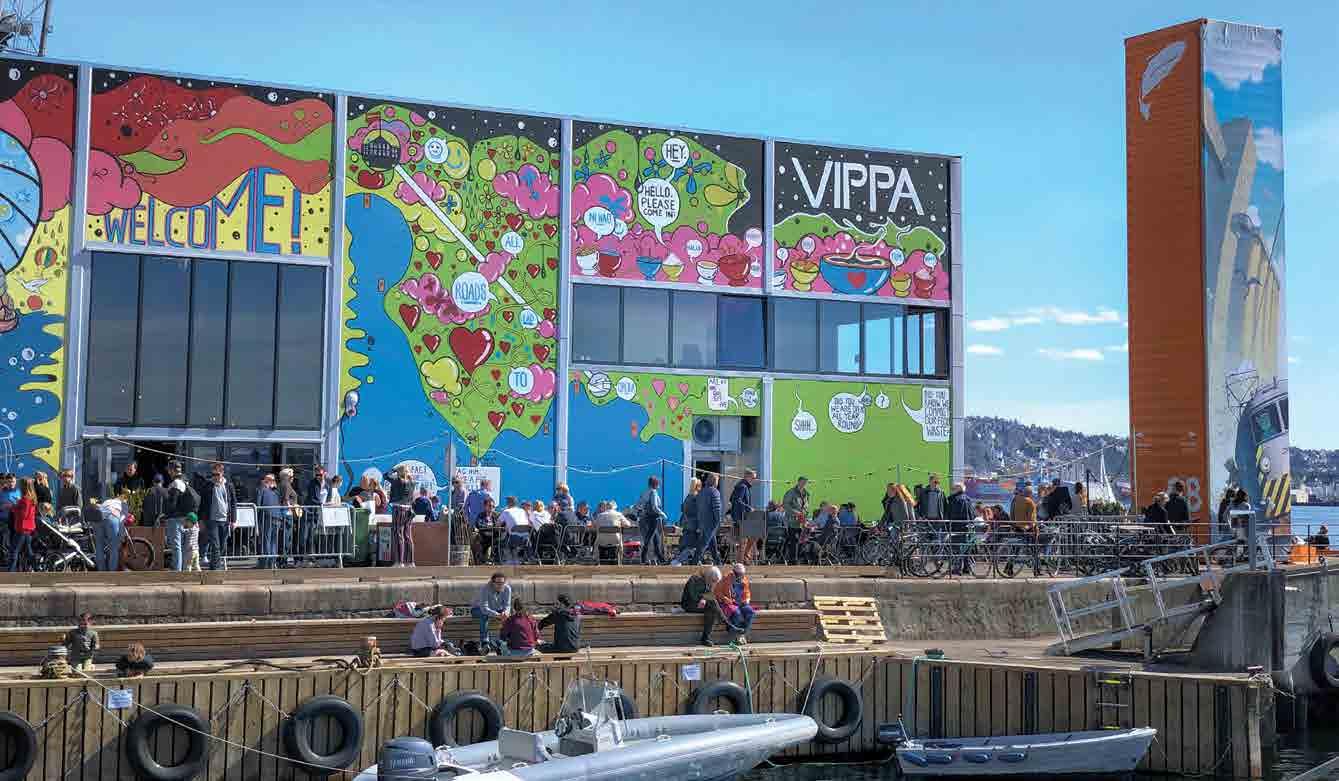
RESTAURANTS
44 VOYAGER 13/2018
TORGGATA BOTANISKE BAR

Torggata Botaniske is a cocktail bar where the plants enjoy just as much care as the cocktails. Miss Basil, for example, is one of the most demanded cocktails here that combines gin, lemon, sugar syrup, and, of course, basil. Fresh greens are used here to achieve the perfect flavors, not just as interior decorations. What makes this fashionable bar special, with its combination of greenery and wood and glass interior, is its creative approach to mixology, interior design, and client relations.

Torggata 17B / f:
Torggata-Botaniske
FOR MORE INFORMATION ABOUT OSLO’S ARTISTIC ATTRACTIONS AND LIFESTYLE, PLEASE VISIT THEOSLOBOOK.NO FOR THE OSLO BOOK, AN ENGLISH-LANGUAGE ONLINE PUBLICATION.
HERALDS VAFFEL
This seemingly simple waffle house on a popular shopping street has an incredible story to share, one related to Oslo-based Swede Jonathan Larsson. Once upon a time, Jonathan, a passionate waffle fan fond of his own recipe, decided to sell waffles from his home, straight through his bedroom window. His business flourished and, in a matter of months, he moved to the heart of the city.
Jonathan Larsson seeks to make Norwegian waffles as famous as Belgian, because he firmly believes that this honor is past due. The difference, at first glance, lies in thickness, as Norwegian waffles are not as thick and sweet, but Larsson’s recipes offer many exciting flavors and mouthwatering combinations. Jonathan offers waffles with bleu cheese, sausages, coconut flakes, several vegetarian yummies and gluten-free variations, also fawaffles inspired by falafel. To cut it short, it is one of the most popular stops in Oslo to grab a bite, so make sure to drop by.
Torggata 7
TIM WENDELBOE
Tim Wendelboe, a fabled espresso bar known throughout the continent, is located in the same hipster neighborhood of Grünerløkka. The brand’s new coffeehouse/coffee training center is found at Tøyengata 29C Tøyen. Both establishments aspire to turn Tim Wendelboe into the best coffee joint in the world, and what makes this barista special is his expertise and quality.
Tim is the 2005 World Cup Champion and 2004 World Barista Champion. He has been hailed by coffee connoisseurs all over the globe ever since. Since 2015, he has been developing an exclusively organic coffee farm in Columbia. New York Times raves that “it feels like a neighborhood shop, but it is run like a Michelin-starred restaurant.”

Grünersgate 1
ENGEBRET CAFE

Just a glance at the café’s exterior is enough to make you fall in love with it. Operating since 1857, Engebret Café is celebrating its 118th anniversary this year. In April, it will open an outdoor restaurant area in the garden to increase its seating capacity to 340. The café offers lunch and dinner menus that grow even more festive and refined during the holiday season. This establishment prides itself on brands of its own, such as house red and white wines and beer. It is the oldest operating restaurant in Oslo, so make sure you put it on your must-visit list.
Bankplassen 1 / www.engebret-cafe.no
45 VOYAGER 13/2018
© eatdrinkkl.blogspot.com © sprudge.com
IS CHEERS IN NORWEGIAN

For starters, tap water is safer and even tastier in Norway. Many travelers have fond gustatory memories of limpid brooks in the wild or water drawn with cupped hands from a creek. It is a strictly summer-related kind of pleasure, though. For every season in Norway here flows ubiquitous beer, akvavit spirit, glögg wine, and cider.
Yes, your memory is not failing you, and yes, Norway enforces strict rules on alcohol consumption and distribution – not sold on Sundays at all, and at limited times and quantities throughout the rest of the week – and you can easily double-check that. On the other hand, no restrictions apply to beverages served at local hotels or restaurants.
Let me lay it on the line: Norwegians take special pride in their beer history spanning 3,000 years. Of course, we will not scrutinize these numbers and take their word for it, but what is worth checking is seeing if 100 microbreweries really operate in the country. After all, many tourists are suckers for smaller breweries in remote areas. Voss is one such business that uses unusual ingredients, such as junipers handpicked in the mountains, to brew beer. But you can see it all for yourself.
Norwegians are a quintessential beer-drinking nation, though they also have long-standing tradition of cidermaking, and lately the country has been producing topquality apple and pear cider. So you may want to put it on your restaurant must-try list. If you are into stronger stuff, you can visit the abandoned NATO base in the country’s northern area known as Lyngen Fjord.
It is now a whisky distillery in the Arctic, the final frontier, as it were. Indeed, it is the world’s northernmost distillery rumored to have deer and sharks as its next-door neighbors. The area is often illuminated by the northern lights, imbuing it with a greater sense of magic. Bivrost is your keyword for more information about the unique characteristics of this place. Equally useful is the word Vikingfjord, the name of the most famous Norwegian vodka (40% ABV) using only glacier water and it’s the most popular hard liquor brand in Norway.
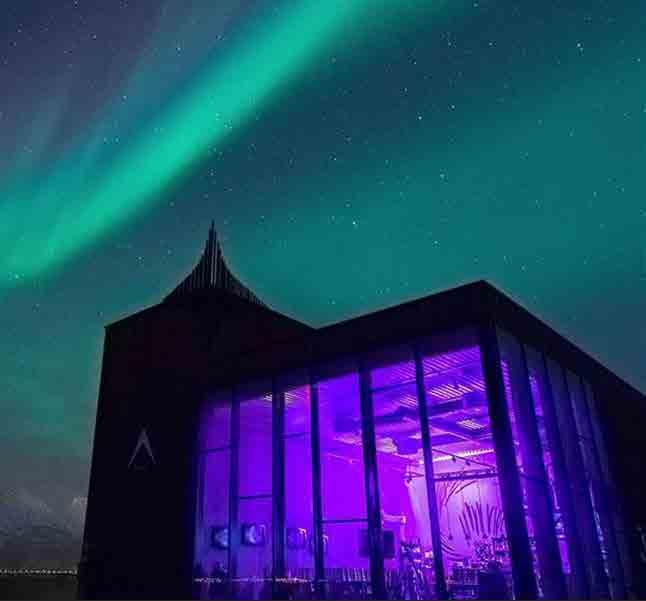
Akvavit, which I mentioned earlier, is a traditional Norwegian beverage that clears up any doubts about a mix of potatoes and grain making a good alcoholic beverage. Yes, akvavit proves it beyond the shadow of a doubt, though some say that its special flavor is defined largely by fennel and caraway seeds. Akvavit is often consumed on holidays, Christmas and Easter, and at wedding receptions, and so is mead – also known as honey wine because of the fermented honey that produces most of its sugar content – favored in wintertime served alongside ginger cookies.
Just be ready for a myriad of spices and flavorful overtones in Norwegian alcoholic beverages. For example, wine is often made from blackberries and seasoned with herbs and spices. Glögg, hot red wine with mulled spices, with its numerous nonalcoholic versions, is also a perfect way to while away long winter nights.
Ultimately, if you are into familiar international varieties of alcoholic beverages, be it bourbon, rum, or tequila, you can find them in any tourist area in Norway. All you need is to learn and observe the consumption rules and laws, and remember that alcoholic beverages alone cannot keep you warm in the cold, freezing weather. What is the other, strictly Nordic secret, then? For answers, we need turn to the Norwegians themselves.
BEVERAGES
46 VOYAGER 13/2018
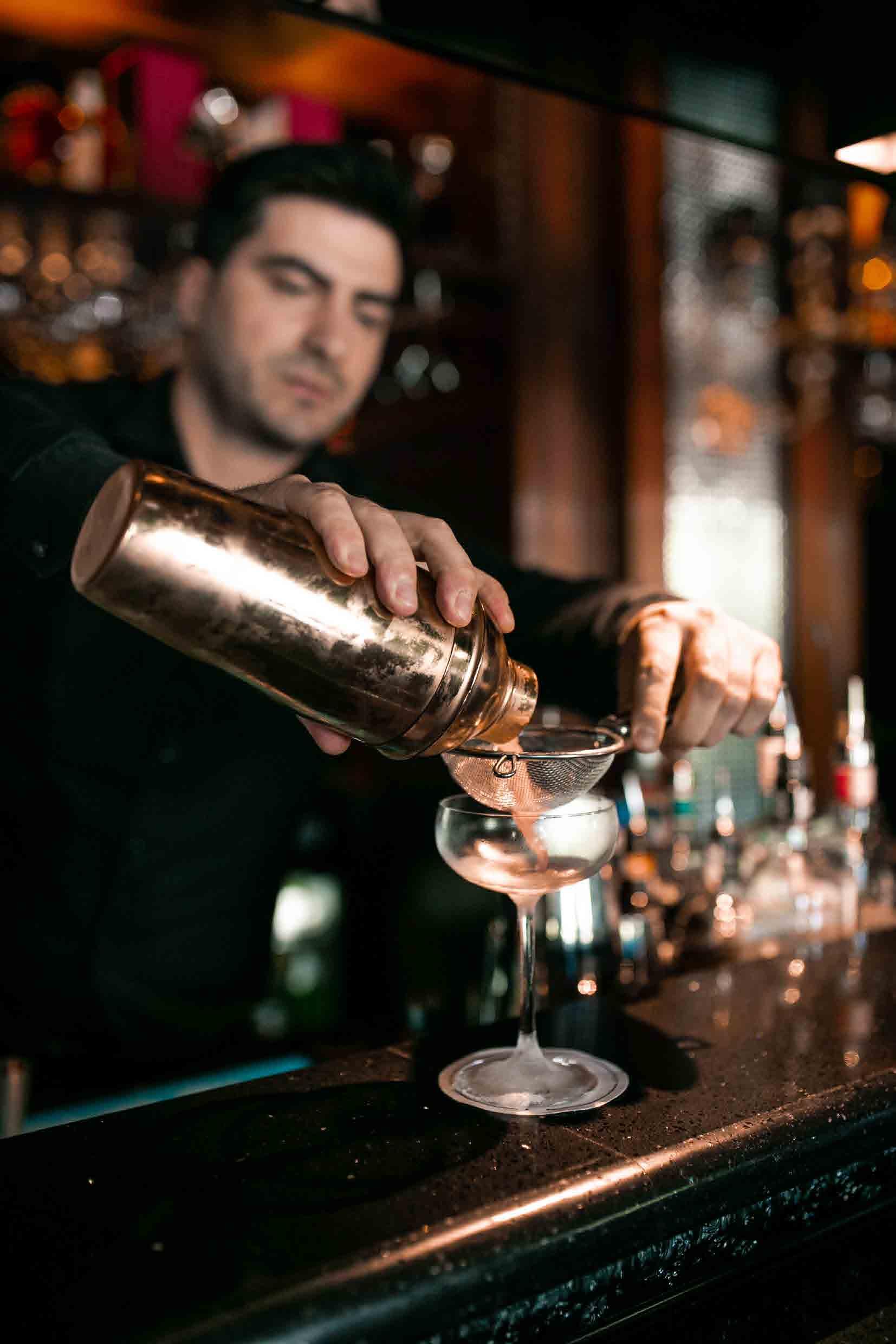


WHAT DEFINES NORWEGIAN HAPPINESS?
 UNA ABASHIDZE
UNA ABASHIDZE
“Change offered by the state is one thing, and what you do for this change is another. When was the last time you asked yourself: What matters to me, and what can I do to achieve it? You see what I mean, don’t you? I mean not going with the flow…” Norwegian psychologist, happiness researcher and Professor at the Arctic University of Norway Joar Vittersø says. “People in Norway live in equal conditions, and that increases trust. Trust is what matters most, because it is then that people feel most comfortable.” This interview was recorded by a Deutsche Welle journalist after Norway reclaimed its leading position in the UN World Happiness report.
KINGDOM OF NORWAY
TOTAL AREA: 285,252 M2
CURRENCY:
NORWEGIAN KRONE (NOK)
OFFICIAL LANGUAGE: NORWEGIAN (BOKMÅL AND NYNORSK)
POPULATION: 5 434 799


OSLO CAPITAL MEN WOMEN 50.1% 49.9% COUNTRY 50 VOYAGER 13/2018
While topping the list in 2017, Norway took a back seat to Finland by a narrow margin in 2018. So it’s official – unlike the citizens of many other countries, the Norwegians start looking for their homeland from top to bottom, because they know well that the word NORWAY is surely second, if not first, on the list.

I have always thought that a happy country is one where the sun always shines with a warm breeze blowing and the sound of splashing waves waking the city. Yet the UN report, launched in 2012, has consistently proved otherwise. As a rule, the top five are Norway, Denmark, Iceland, Finland, and Switzerland, that is, countries where it snows and cold nights drag out infinitely for a good portion of the year.
How does one measure happiness, anyway? How do you objectively measure people’s happiness, an infinitely intimate experience that encompasses, among many other things, a person’s cultural values, worldview, and upbringing?
The UN index is based on a survey of six variables of happiness: GDP per capita (one of the indicators of standard of living), social support, healthy life expectancy, freedom to make life choices, generosity, and perceptions of corruption. These categories are followed by what we may perceive as indicators of happiness: beautiful landscapes and a pollutionfree environment, well-organized and stress-free everyday life, high incomes, access to education, effective healthcare insurance, and frequent travel opportunities.
Norway’s population exceeds five million, though, importantly, these five million live across 385,252 square kilometers, which is an enormous territory for so few people. Here you do not find booming cities or impoverished villages because the state budget is allocated equally among all regions, so they are developing at a more or less even pace. And although only 10% of the population live in Northern Norway, things are just as streamlined as in the other, far more densely populated areas.
Norway pays a great deal of attention to and invests heavily in education and science. For example, education is free for both Norwegian and foreign students. Economic equality (more or less equal incomes) in real life is evident primarily in the example of Norway. Those under 16, along with pregnant women and mothers with infants, enjoy free medical services. Although some amounts are automatically deducted every year from their incomes as mandatory taxes, some of the medical expenses are still covered by the state. Tens of thousands of dollars are spent annually on each citizen, the highest number
in the world. The state covers medical treatment abroad, parental leave, medications for chronic diseases, and many others.
For several years now, the United Nations has been conducting surveys to identify countries that take better care of their citizens. The 2018 list ranks Norway second judging by the criteria mentioned earlier: GDP per capita, social support programs, healthy life expectancy, freedom to make life choices, generosity, and perceptions of corruption.
84% OF NORWAY’S POPULATION AGED BETWEEN 25 AND 64 HAVE ATTAINED HIGHER EDUCATION, AND MORE THAN 75% ARE EMPLOYED. A VARIETY OF PROGRAMS IN NORWAY, AND ACROSS SCANDINAVIA IN GENERAL, ARE DESIGNED TO ASSIST THOSE UNEMPLOYED.
The issue of gender-based discrimination is not at all problematic in Norway, as evidenced by the World Economic Forum’s Global Gender Gap Index. In Norway, men and women enjoy equal conditions in education, politics, and even in terms of life expectancy. All right, it makes sense. It makes sense that taking good care of one’s environment and people’s education and health does bring about positive results. However, all these dry statistics, notions, terms, and rankings aside, is that enough to have the happiest citizens in the world? It is true that the richest countries are not on the list, which means that a lot of money does not guarantee happiness. “No, it can’t possibly be because of the weather, because it’s always so terribly cold here,” a Norwegian woman says in an interview, adding, “Then... maybe nature, nature and people are the reason?”
“It is common knowledge that people are happier where the sun shines longer. Yet, as we see, it is not so, as evidenced by Norway’s example,” happiness researcher Joar Vittersø comments. One may say that people have learned how to adapt here and how to make full use of their country’s greatest treasure, nature. Norway is one of the first places where human beings learned skiing and husky or reindeer sledding. It is part of life more than it is a gimmick to attract tourists. It is a place where, for six months, you can contemplate the northern lights in the sky, a most mesmerizing sight, whales have jumping season, and where glacier-formed fjords offer an unforgettable attraction.
51 VOYAGER 13/2018
Many simply refer to Norway, with its 450,000 lakes, almost 50,000 islands, and territories under UNESCO protection, as nature’s masterpiece.
The state spares no effort to make that its citizens spend quality time vacationing, which is why the Norwegians know that, whenever they decide to go camping and light a bonfire together with their families, they are free in their choice of destination, be it a national park or private territory. All they need to do is observe the rules. In other words, it is all about two key factors, responsibility and trust.
“Generally, the Scandinavian countries are very big on social support,” Jan-Emmanuel De Neve, one of the happiness study’s associate editors, says. “For example, the Scandinavians are more likely to return a stranger’s wallet than those lower in the ranking, which is an indicator of what we call social support. And as you know…


The governments in these countries are constantly looking to make room for local initiatives to encourage their citizens, and that creates a sense of communal unity.” “What matters is keeping them outdoors no matter what the weather,” a kindergarten director from Tromsø says in a Deutsche Welle video interview.
Two year-olds are dressed just like our children on their way to Bakuriani for winter: one-piece snowsuits, warm footwear, and reliable knit hats pulled down. Norwegians believe that
COUNTRY 52 VOYAGER 13/2018

KEEPING CLOSER TO NATURE

FJORDS
Hardangerfjord
KVINIKADZE 54 VOYAGER 13/2018
TAMAR
Fjord is a familiar Norwegian word. You may not know exactly what it means, but once you hear it, you are sure to imagine impressive views of endless gorges and ocean channels zigzagging through them. These landscapes, for the most part, are imagined from a bird’s eye view, far far away, and that is the way to do it.
In times past, the Vikings used this word to refer to both “where one fares through” and a small ship most likely used to “fare through.” The fjords, as we know them today, perfectly match both meanings. A fjord is a deep, narrow, long inlet surrounded by cliffs on three sides. If the geological formation is larger in width than in length, then it is called a bay, not a fjord.
The process of fjord formation, which started 2.5 million years ago, took several ice ages to complete. The fjords were carved by a massive sheet of ice up to three kilometers thick that covered Northern Europe in a succession of ice ages. This process in times immemorial gradually shaped these spellbinding landscapes. The mesmerizing silence of nature is felt here even more intensely than in open waters, which is why the fjords are often referred to as natural harbors.
Besides Norway, fjords are also found in other countries. For example, the longest fjord (350 km) is located in Greenland. On the other hand, Western Norway, because of the multitude of fjords here, is known as Fjord Norway, and it is here that the second and third longest fjords in the world are found: Sognefjord (203 km) and Hardanger Fjord (179 km). You can visit either at any time of year, and go both cruising on the waters and camping in the mountains. And it does not matter what path or season you choose to experience the unique character of the fjords – the magical powers of nature are there to surprise you.
The narrowest fjord in the world, Nærøyfjord, with cliffs towering over it, is a likely candidate to make the most vivid impression, and so is Hjørundfjord, an unsullied pearl among Norway’s fjords, some of which are protected by UNESCO as monuments of heritage, such as Geirangerfjord, for instance.
Norway’s fjords feature everything from uninhabited islands to large cities. Straight from an urban setting, you may wind up in a quaint village or totally deserted fairytale-like virgin landscape. You will find small communities and villages, each with their own traditions and customs reflected in Norway’s culture today.

55 VOYAGER 13/2018
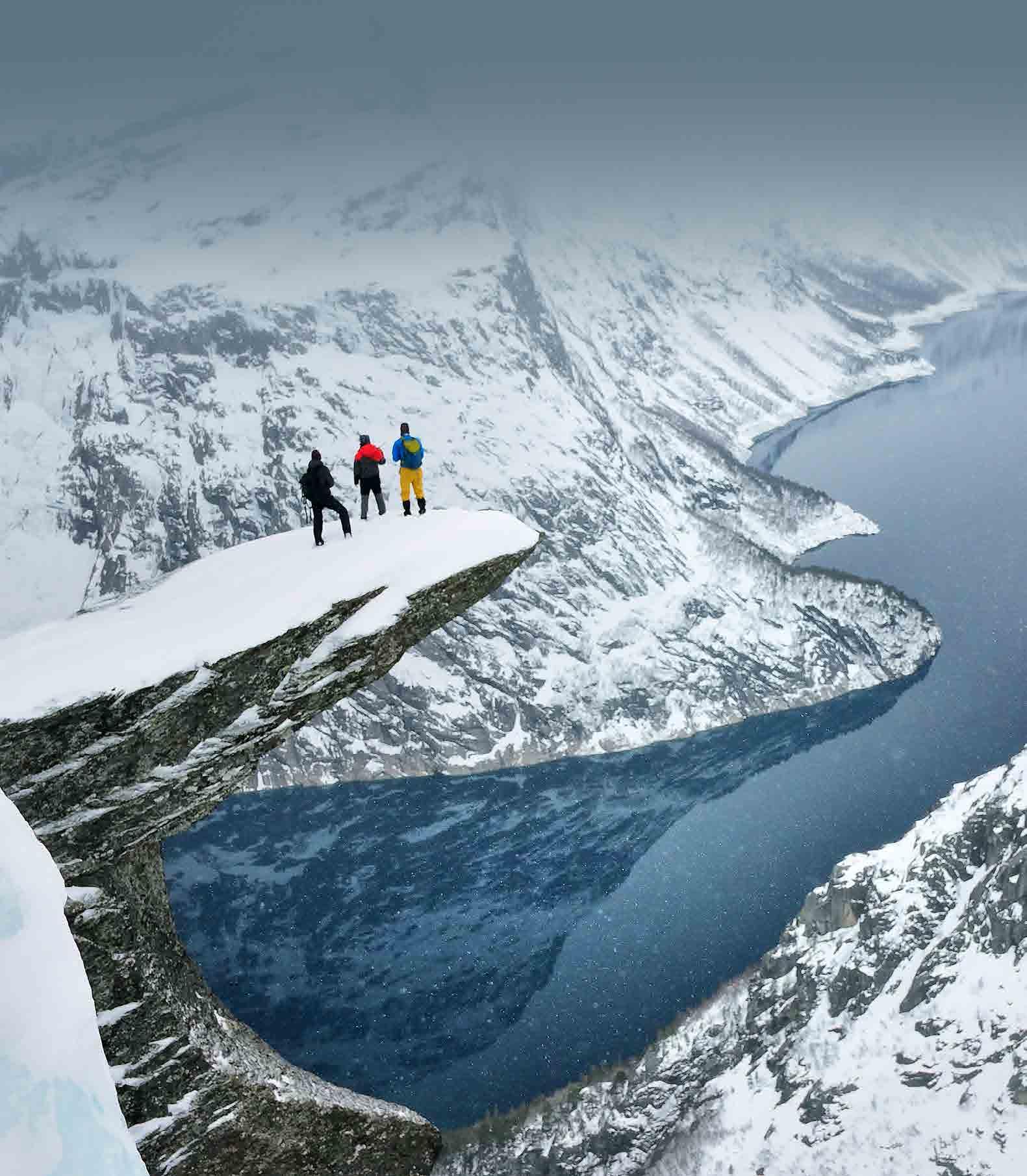
FJORDS 56 VOYAGER 13/2018
HARDANGERFJORD
The length of Hardangerfjord, the second longest fjord in Norway and third in the world, is 179 kilometers. Its maximum depth is over 800 meters.

This fjord is famous for its impressive blooming fruit trees. Near the Folgefonni glacier, you will find Trolltunga, a spectacular scenic cliff which is quite difficult to conquer and yet so enticing. There are many salmon farms in this region, making the Hardangerfjord one of the four largest fish-farming regions in the world.
NORWAY’S OFFICIAL TOURISM WEBSITE LISTS THE TOP 10 NORWEGIAN FJORDS TO TRAVEL: THE HARDANGERFJORD REGION, BERGEN, THE GEIRANGERFJORD AREA, FLÅM, THE STAVANGER REGION, AND RYFYLKE, THE SOGNEFJORD AREA, NORTHWEST, THE ÅLESUND AND SUNNMØRE AREA, VOSS, AND NORDFJORD.


57 VOYAGER 13/2018

58 VOYAGER 13/2018 FJORDS
THE HJØRUNDFJORD
The Hjørundfjord, 33 kilometers in length, is believed by many to be one of the most beautiful fjords in the world, largely due to the peaks of the Sunnmøre mountain range rising straight from the fjord. Slightly to the north, the fjord stretches 2.5 kilometers in width and grows narrower in its lower section. The name of the fjord is likely to derive from the word hjorr, which means sword, because the shape of the fjord can be compared with that of a sword. This fjord is also remarkable in that it is surrounded by 70 smaller lakes, one of which is Tusse Lake, which has given name to a prominent brand.

59 VOYAGER 13/2018
THE SOGNEFJORD
The Sognefjord extends 204 kilometers inland to the foot of the Jotunheimen and Jostedalsbreen National Parks. Its maximum depth reaches 1,308 meters. In ancient times, this fjord was an important transit point facilitating transportation of agricultural goods between Sogn and Bergen.



Each fjord, those listed here and others alike, are perfect for unity with wild, primeval nature, for encountering face to face the landscapes we know only from epic and fantasy movies or books, also for hiking, cruising, and other land or sea athletics, tourism, or entertainment activities year-round.

FJORDS 60 VOYAGER 13/2018
THE LYSEFJORD
Make note of this fjord extending 42 kilometers in length and 500 meters in depth, because it is here that you find Preikestolen, a cliff 604 meters in height offering a view that, they say, is sure to make you feel free as a bird. Also the famous 5m3 Kjeragbolten boulder sandwiched in midair between two cliffs, with 984 meters of void below. That boulder is the one from that familiar photo that has always made you wish you were there instead of the tourist in the picture. But make sure you get the season right, because, naturally, you cannot always ascend the place, even though it is not difficult at all. Also keep in mind that long lines of tourists often form by the boulder, because everyone wants to take a picture on this unforgettable monument of nature.

On the other hand, there is always something fun to do in Stavanger, the region’s largest city famed for its world-class restaurants and artistic life. The region also features Sokndal, the first municipality in the Nordic countries to have joined
the Cittaslow international movement, thanks to which it now lives a peaceful, quality, slow-paced life. In other words, the local legislation is tailored to suit the pleasures sought by the local residents. If you think it is a figment of my imagination, see it for yourself – it is nothing short of an earthly paradise.

61 VOYAGER 13/2018
Stavanger
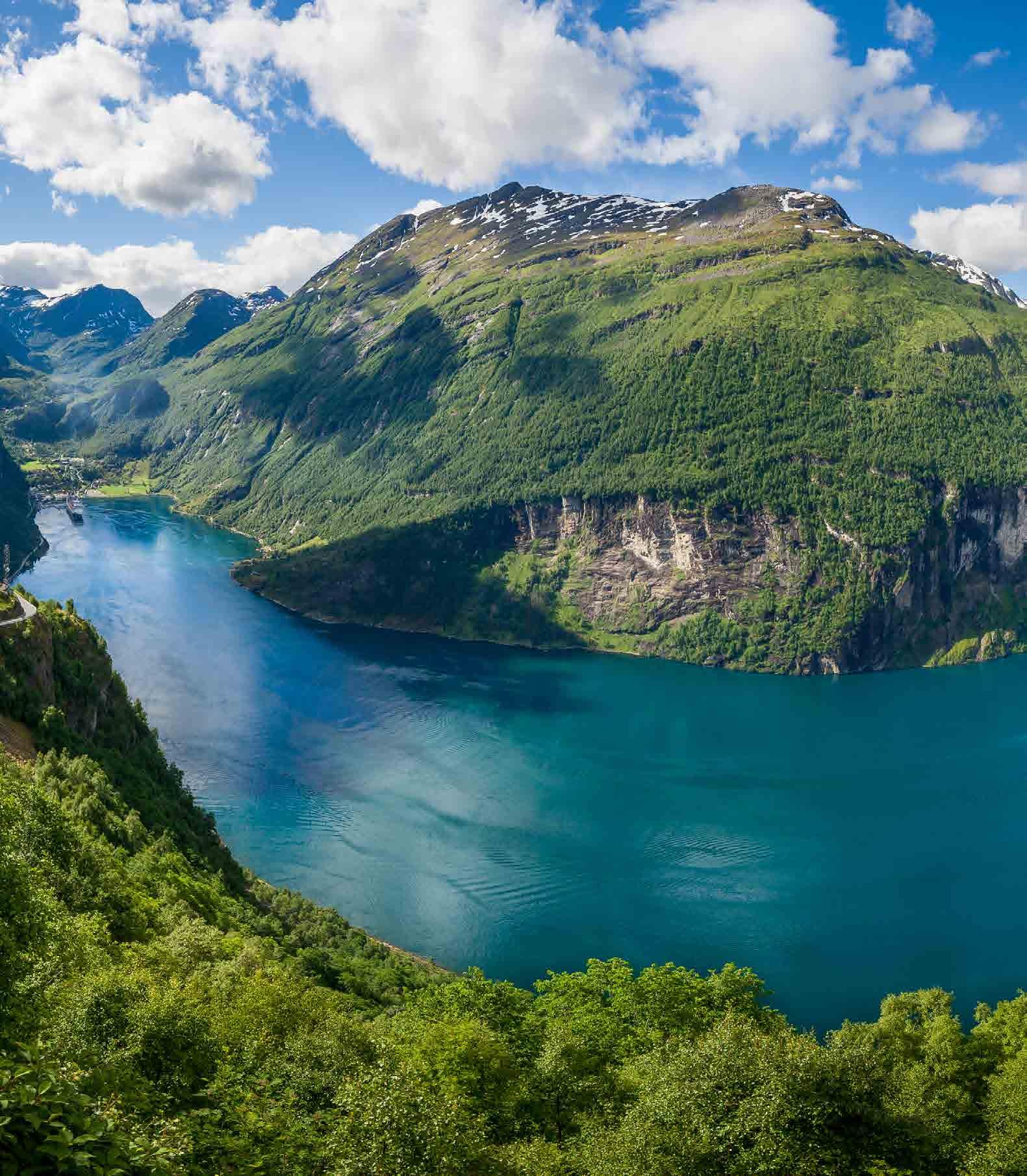
FJORDS 62 VOYAGER 13/2018
THE GEIRANGERFJORD Sunnmøre Area
The Geirangerfjord, which stretches 15 kilometers, has been under UNESCO protection since 2005. Most impressively, it’s shaped like the Latin letter S and its primeval beauty attracts travelers from around the world. Way up in the mountains, where human settlements seem impossible, you may notice farms, most of which are abandoned, though you can make the trail on foot to visit them.
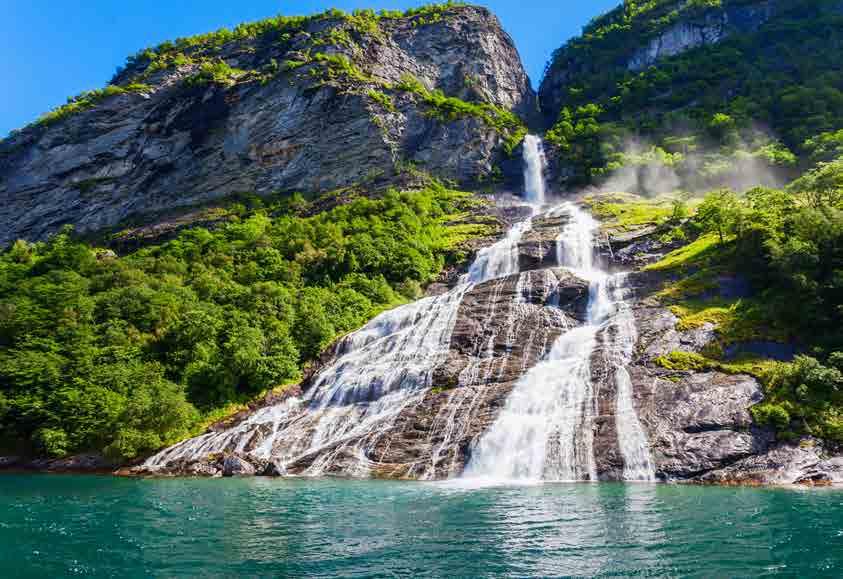
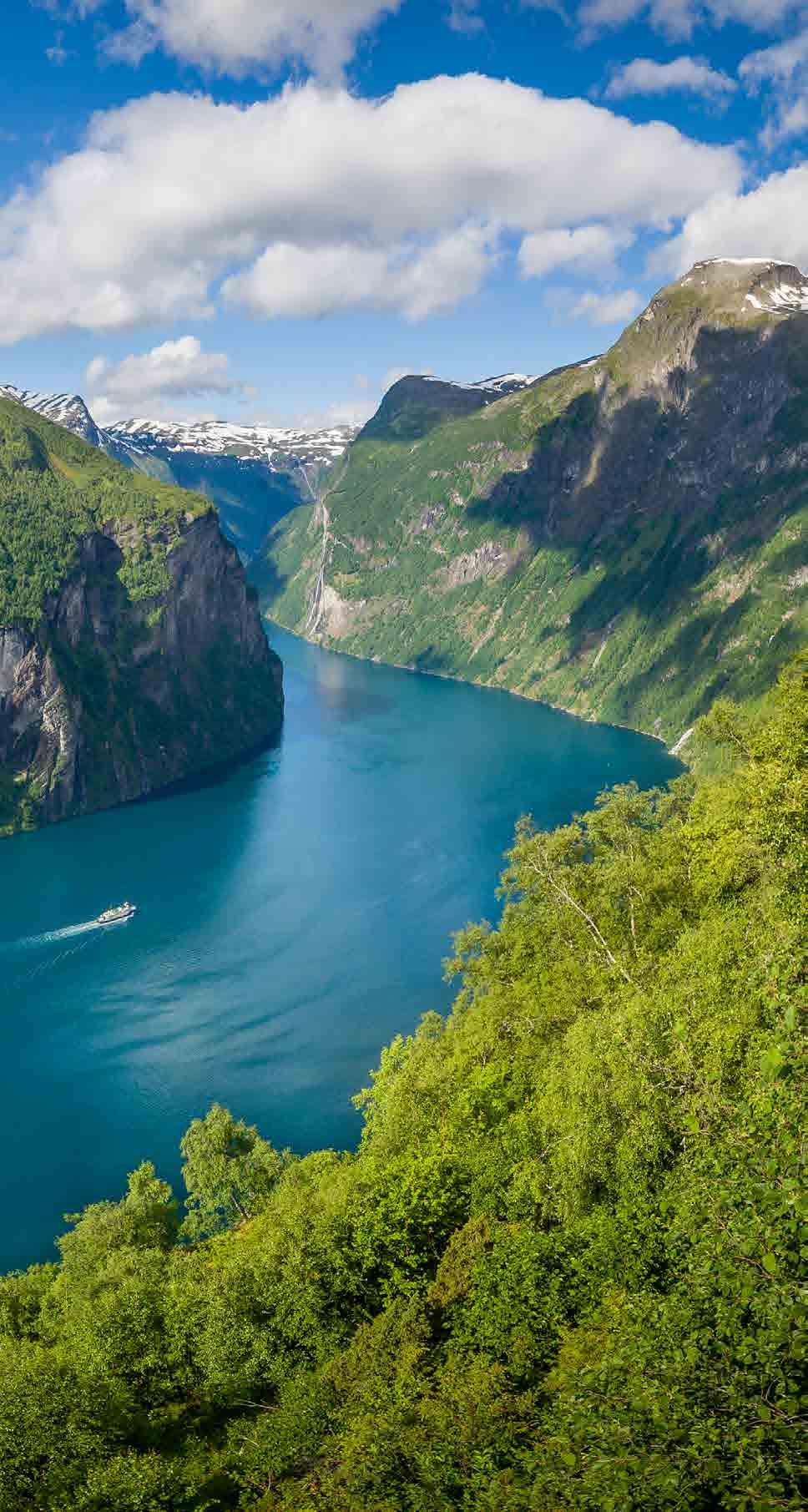
On the very top of the fjord, you will find a gorgeous small settlement. On your way back, you will pass the Seven Sisters Waterfall with an average fall of 300 meters. Seen from a distance the waterfalls can resemble the hair of seven women. On the opposite side of the fjord, you can see Friaren, a waterfall shaped like a bottle. Legends has it this waterfall proposed to the Seven Sisters several times and was continuously rebuffed, eventually taking to the bottle.
FOR MORE INFORMATION, PLEASE VISIT WWW.FJORDNORWAY.COM. WE HOPE YOU ARE CONVINCED NOW THAT TRAVELING TO THESE PLACES IS NEITHER A DISTANT PROSPECT NOR SOMETHING UNATTAINABLE OR IMPOSSIBLE. NEXT, LET’S FIND OUT MORE ABOUT THE CITY WHERE NEARLY ALL NORWEGIAN FJORD-BOUND TOURS BEGIN, FROM DOG-SLEDDING TO CRUISING OR SAFARI-WANDERING. WWW.FJORDTOURS.COM
63 VOYAGER 13/2018
BETWEEN SEVEN MOUNTAINS
This is the city of Bergen.

In 2017, Condé Nast Traveler readers cast hundreds of thousands of votes for Bergen as their favorite European city.
It is the second largest city in Norway.
At times, it comes across as a city of northern lights, with gigantic colorful shapes swaying and rocking over the water and houses at night.
The city’s UNESCO-listed old wharf and colorful wooden houses are in the Bryggen District, which currently facilitates museums, restaurants, pubs, and artistic workshops.
In a nutshell, Bergen is one of those cities we see on postcards and in pictures on the internet, those that nonetheless seem unreal, like a fairytale. The only way to appreciate Bergen is to visit it. Though it is a big city, it exudes the charm and enticing atmosphere of a small town.
If you are into socializing and blending in, you should forget about museums and head straight to the fish market, a truly unique place. In the same vein, you can continue your tour by dropping by the local aquarium to watch Bergen’s own fish, penguins, seals, and spiders in their natural habitat.
Architecturally, the old wharf is unique, and so are the yellow, red, blue, and green houses lined up along the shore, and
BERGEN
64 VOYAGER 13/2018
NATIA AKHALASHVILI
this neighborhood should be your next stop. On the other hand, many tourists, in search of their own favorite spots, ascend one of the seven mountains surrounding the city. The panoramic views of the city, the fjords, and the ocean that are offered by any of the seven peaks, be it Fløyen or Ulriken, are simply captivating. It takes just 10 minutes by cable car to reach the top from downtown Bergen. Fløyen at 399 meters above sea level is the most crowded attraction, so make sure you leave early enough to avoid the crowd and enjoy better views. If you feel like walking, from Fløyen you can continue up toward a higher peak of Blåmann (551 m). The views up there are worth the effort.
Bergen’s residents take special pride in the history and cultural traditions of their city which hosts, among other things, the largest annual musical and cultural festival in Norway, which lasts 15 days. Next year, the festival takes place from May 22 to June 5 and includes concerts, theatrical and opera performances, exhibitions, discussions, and literary gatherings. Beyond the festival, cultural life is brimming in Bergen all year-round. So you may want to check the calendar before heading to the city of seven mountains and fjords.
Also make sure you visit the open-air Old Bergen Museum to find yourself in the city’s life in the 19th century. Other must-see places include the 13th century Håkonshallen royal residence, the city’s cathedrals, and the Bergenhus Fortress.
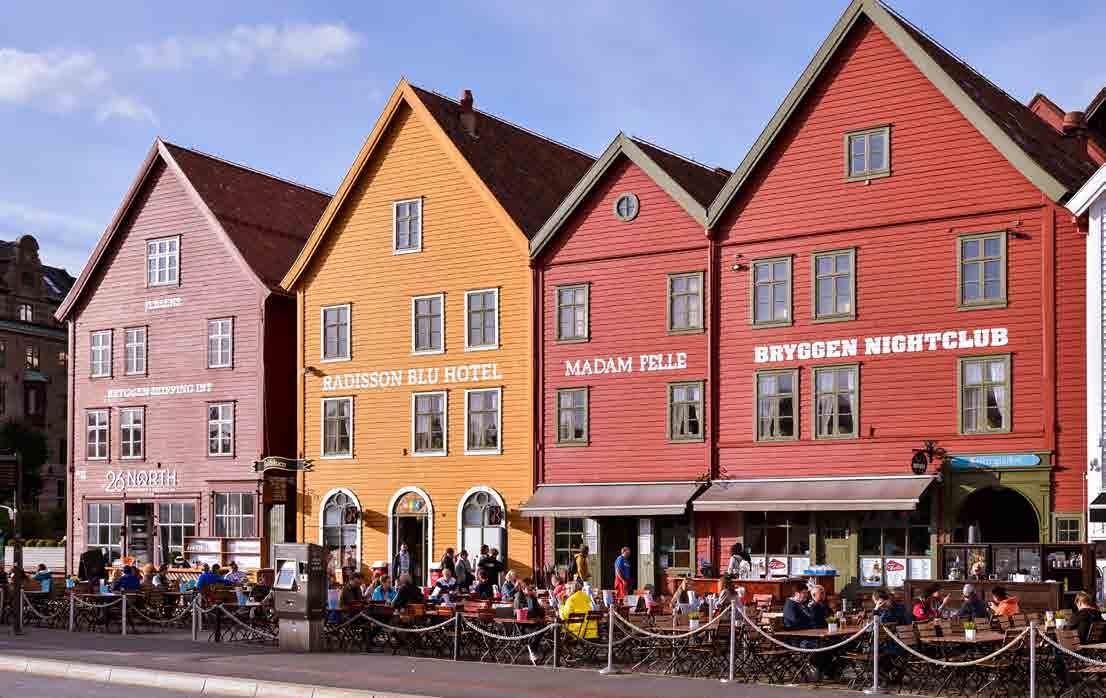
With more than 900 years of continuous history, Bergen’s roots are sought in the ear of the Vikings and their ancestors. Bergen, as the country’s royal residence established in 1070, turned into the first actual capital of Norway in the 13th century. Moreover, until the 1830s, it was the largest city in the country, also enjoying this status throughout Scandinavia in the Middle Ages.

65 VOYAGER 13/2018
The city’s importance rested on its port and trade experience. Bergen was one of the four main trading centers of the Hanseatic League. Naturally, to build on this experience further, the city continued to develop different branches of industry, trade, and tourism, also fish production, and oil and natural gas extraction. Bergen features all kinds of trade outlets, from small salon-type and thematic boutiques to enormous malls and markets. Somehow, it seems that you are about to give in to the temptation and go on a shopping spree in the streets of Bergen.
Bergen is also an important university town, with about 10% of its residents being students who moderately enliven and invigorate the city’s paradise-like peace and quiet.

Did you know that Norwegian shrimp have the sweetest flavor? Chefs just love Bergen, which is probably because of the city’s best fish and seafood and closeness to unique nature. The local restaurants build their menus around the ingredients their providers have on a given day. “What do you have for me today?” is the opening question in every conversation between chefs and providers.
Nearly all means of transportation will take you to Bergen, be it by plane, rain, bus, or car. You should know by now that Norway’s public transport is very flexible, comfortable, and omnipresent.
In conclusion, Bergen is known as the Gateway to the Fjords. Indeed, it is the most cultural, most urban, and most artistic gateway to a place where man-made culture no longer applies, and where everything reminds us of the time when the universe ran its course independently from us.
PS If you are interested in fjord-bound cruises departing from Bergen, make sure you familiarize yourself with what the Rødne Fjord Cruise agency has to offer (www.rodne.
CHEFS JUST LOVE BERGEN, WHICH IS PROBABLY BECAUSE OF THE CITY’S BEST FISH AND SEAFOOD AND CLOSENESS TO UNIQUE NATURE. THE LOCAL RESTAURANTS BUILD THEIR MENUS AROUND THE INGREDIENTS THEIR PROVIDERS HAVE ON A GIVEN DAY. “WHAT DO YOU HAVE FOR ME TODAY?” IS THE OPENING QUESTION IN EVERY CONVERSATION BETWEEN CHEFS AND PROVIDERS.
no). According to their website, one of the trips takes as little as three hours aboard a comfortable catamaran with a sundeck, which takes you to Osterfjord and the picturesque Mostraumen, where regular boats are barely able to pass through. The cruise starts from the Fish Market in Bergen. As you embark, you will enjoy some of the finest views of the city. Next, the cruise leads through wild landscapes and some of the most unique places. Most importantly, the tour operators are not afraid of winter. The three-hour journey from the city into the wild is available through December 31.
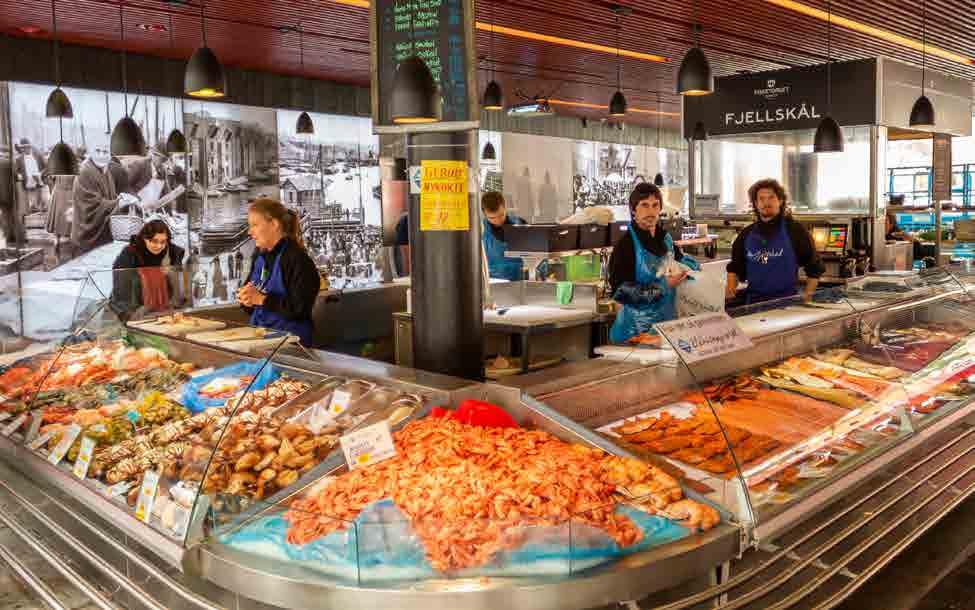
BERGEN
66 VOYAGER 13/2018
CORNELIUS
Holmen, a neighborhood just outside Bergen, offers the most exotic attraction in Western Norway. Cornelius is one of Norway’s best seafood restaurants situated right by the sea on a small island, where you can enjoy both local cuisine and spectacular views of the fjords, mountains, riffs, and passing ships and boats. Cornelius serves its famous five-course Meteorological Menu of exquisite seasonal seafood and trimmings prepared using innovative culinary techniques.
Cornelius is open all year. On beautiful summer days, the restaurants sliding doors open and lighter dishes are served on the pier. When the weather is less favorable, a cozy atmosphere is created indoors by serving food with stronger flavors and lighting up candles and a fireplace. Regular boats depart at 6 pm from Dreggekaien on Bryggen (shed #8) opposite Radisson Blu Royal Hotel and Clarion Collection Hotel Havnekontoret, returning from Holmen at 10:30 pm. The boat trip takes 25 minutes. Private charters are also available. Online booking is recommended.

Holmen v/Bjoroy, Fjell / www.corneliusrestaurant.no
STORM KJØKKEN & BAR
Storm Kjøkken & Bar is one of Bergen's best restaurants, offering lunches and dinners in a casual and friendly atmosphere. It is located right in the heart of Bergen, just a 5 minute walk from the wharf and the Fish Market. This place suits all occasions, whether you want a quick snack, or a pleasant evening with a substantial meal.
The restaurant’s three-course dinner served any day of the week is extremely popular. Needless to say, the dishes here are made from local products. In the Storm Bar on the second floor, you will be greeted by menus from the best bartenders in town.
Øvre Ole Bullsplass 3 / www.olebullhuset.no
LYSVERKET
Lysverket is a restaurant and bar at the beautiful art museum KODE 4 in the heart of Bergen. The establishment offers unique views of the picturesque museum and gallery avenue, a lake, the city’s central square, and the mountains. The restaurant serves both lunch and dinner, consisting of modern Norwegian dishes using local ingredients, with special emphasis on fish and seafood, of course, though meat and vegetables are found as well.
You can order a longer a la carte menu or a shorter prix fixe menu, which enables you to grab a snack and enjoy a glass of alcohol in the bar or dedicate all evening to dining. Traditional Norwegian dishes are also served.
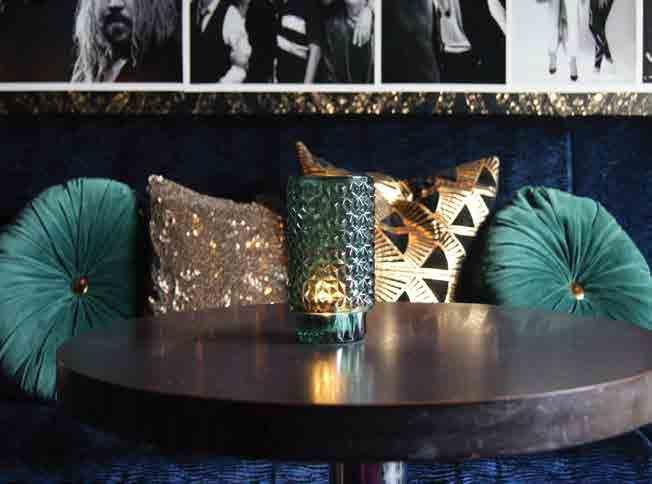
Lysverket’s bar serves some of the most popular cocktails in town and a variety of draft beers. The bar’s cocktails use different house mixes of juices, syrups, and liqueurs. Fans of nonalcoholic beverages can enjoy local fruit juices.
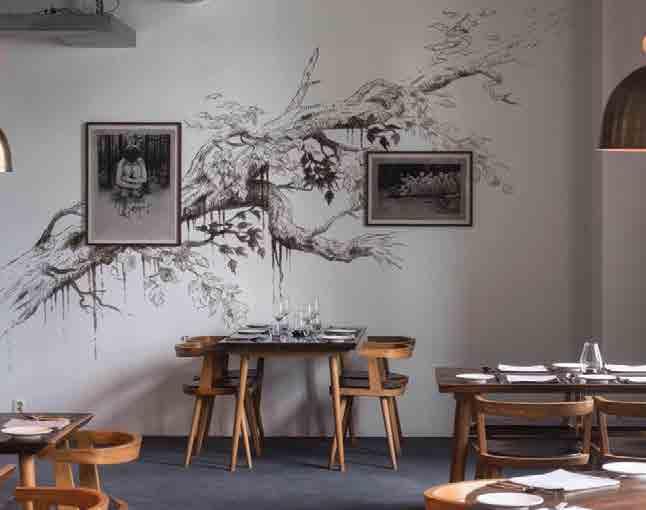 Rasmus Meyers allé 9, Inngang gjennom KODE 4 www.lysverket.no
Rasmus Meyers allé 9, Inngang gjennom KODE 4 www.lysverket.no
67 VOYAGER 13/2018
KODE MUSEUMS OF BERGEN
Click the exhibition tab at kodebergen.no/en/exhibitions/ ongoing to find an event or an artist of your liking.

By the way, KODE is one of the largest art museum centers not only in Norway but throughout Scandinavia, as it
brings together all branches of art from the Renaissance to modern. This precious collection is exhibited in four different facilities spread around Bergen’s beautiful Lille Lungegard Lake. Each KODE facility has a different address. Do not let that throw you off the track because KODE also owns other houses and exhibition spaces besides the four.
This facility displays fine craft and design pieces and incorporates Sølvskatten (The Silver Treasure), the museum’s permanent exhibition of silver and gold objects, and the Singer Collection, which consists of European and Asiatic antiques, paintings and works by Old Masters. KODE 1 also presents a new museum shop focusing on design and interior architecture.
The museum also has a new restaurant, Bien Centro, and a new educational space for kids.
Nordahl Bruns gate 9
This is KODE's main venue for temporary exhibitions, where an exhibition of contemporary Norwegian artist Vanessa Baird opened in November. Her works focus on sex, passion, and the human body. At the ground floor, you will find Bergen’s largest art bookstore with a large selection of books on the visual arts, photography and design, and architecture. The shop sells a wide selection of posters, children’s books, and thematic souvenirs. Café Smakverket is found in the same building.
KunstLab – the Children’s Art Museum is a must-see regardless of your age, because it is the first art museum in Norway designed especially for kids.
It also includes an elaborately designed laboratory where children are free to explore the world of art through play and fun experimentation. For example, the ongoing Dream Dust exhibition invites visitors to the world of dreams through a selection of illustrations from contemporary Norwegian picture books.
This facility exhibits the artworks from the collection of Bergen-based businessman and art collector Rasmus Meyers, which he donated to the city in 1916. KODE 3 also preserves one of the largest Edvard Munch collections in Norway. A special exhibition is dedicated to the Golden Age of Norwegian art and historical interiors from the Bergen area.
Rasmus Meyers allé 7
The same facility displays an exhibition of Nikolai Astrup, one of Norway’s most beloved artists, also an exposition of 14th century icons, and a large-scale show dedicated to the topic of European Modernism in the 20th Century.

KODE 4 also incorporates Lysverket, a restaurant with an artist’s touch on seafood.
Rasmus Meyers allé 9
KODE 1
KODE 2
Rasmus Meyers allé 3
KODE 3
KODE 4
MUSEUMS
68 VOYAGER 13/2018
SØSTRENE HAGELIN
The best pastries in Bergen are fish pastries and the recipe has been the same since 1929, when two sisters, residents of Bergen, treated the café’s first patrons to these

yummies. The establishment’s fish soup, along with fish burgers and wraps, are also praised by all. Strandgaten 3
TREKRONEREN
Trekroneren is often referred to as Bergen’s legendary sausage stand, and it is frequented by both locals and visitors. Sauces and garnishes are prepared on the spot.

VILLA TERMINUS
Villa Terminus, formerly a retirement home, now houses a hotel. Built in the 18th century, it is a monument of cultural heritage. As you enter, you can’t help but to feel at home. Everything is so natural, plain, and slightly chaotic. For example, the shelves here, just like at home, contain numerous miscellaneous items besides books. The lighting is cozy and warm.
Because of the exceptional qualities of Norwegian sheep, we are advised to try lamb sausage with homemade sauce.

Kong Oscars gate 1
COLONIALEN LITTERATURHUSET
This Bergen version of the literary café is the House of Literature and enchants visitors with its direct, friendly, and yet aesthetically enticing interior. The place serves both lunch and dinner.

The menu consists, for the most part, of Norwegian classics, such as lobster, mollusks, fish, and meat, using traditional Norwegian and Nordic recipes.
Østre Skostredet 5-7
The hotel’s interior design was inspired by the neutral colors characteristic of Vilhelm Hammershøi, a famous 19th century Danish artist. The rooms celebrate Norwegian literature, with each featuring one particular author. Excellent coffee and bakers’ confections create a perfect environment for making new friends and appreciating Bergen’s culture
MAGIC ICE

This bar resembles a winter wonderland. It consists of several tons of ice upgraded by world-famous ice sculptors several times a year. If a genuine Arctic experience is what you’re after, then you are guaranteed to find it at Magic Ice. Before entering, you will be given a warm poncho and a pair of gloves because even the glasses served here are made from ice. And pretty much everything here is cut from ice as well: tables, royal armchairs, and even iceart copies of works by famous artists. Magic Ice has been around to surprise visitors for 11 years now.
C. Sundtsgate 50 / www.magicice.no
and history. Several restaurants and a café on the veranda operate here, also Kalfaret brygghus (www. kalfaretbrygghus.no), an industrial style brewery and restaurant.
www.villaterminus.no
Gate 6, Zander Kaaes
69 VOYAGER 13/2018
A CITY FROM A POSTCARD
Ålesund is praised by many as the most beautiful city in Norway. It is also true that Ålesund is a dream city for anyone in any part of the world who is overworked and fettered by a hectic schedule. Why would anyone not want to visit this city resembling a crystal necklace with its brilliant beads scattered across zigzagging narrow fjords and reflecting in their brightly lit waters? Ålesund is built right at the gateway to the fjords and marks a unique place where urban lights meet the beauty of primeval nature.
Here is what visiting Ålesund promises: enjoying the city’s Art Nouveau architecture – rebuilt after a devastating fire in 1904 never to change its appearance again – wandering through the fjords and camping, year-round skiing, and a range of athletic endeavors.

Still wondering why tourists flock to Ålesund and Sunnmøre? Many visitors stop in this city on their way to the Geirangerfjord, a UNESCO-protected fjord, or to the
Runde Island, also known as the Bird Island, or to the snowcovered peaks of the Hjørundfjord and Sunnmørsalpene. From the sapphire-blue fjords, these peaks reach almost 2,000 meters in height, once again creating an illusion of being at the filming set of some Norwegian fairytale. National Geographic praises Ålesund as a perfect backdrop for a Nordic fairytale.
Today, however, Ålesund comes across more as one of the region’s cultural hubs. Those specific about their hobbies and interests are advised to check the calendar for the list of festivals held here throughout the year. The city’s cultural life may appear as something even more impressive than the northern lights.
THE REGULAR EVENTS HELD IN ÅLESUND INCLUDE THEATER, NORWEGIAN LITERATURE, NORWEGIAN CUISINE, MUSIC, AND THE ART FESTIVALS
JUGENDFEST AND TRANDAL COUNTRY FESTIVAL, AMONG OTHERS.
ÅLESUND
70 VOYAGER 13/2018
THE ROYAL FJORD ROUTE
www.visitnorway.com
Ålesund-Hjørundfjord-NorangsdalenGeirangerfjord-Ålesund: this route is known as the Royal Fjord Route because it was enormously popular among kings and queens in the 19th century. But now it is your turn to enjoy this magical beauty, tour operators say, and offer us adventures in Geirangerfjord and Hjørundfjord.
418 STEPS TO UNFORGETTABLE VIEWPOINTS - try these keywords to see for yourself that Aksla offers the most unforgettable views of the city, ocean coastline, and mountains. Taking 418 steps is certainly worth it. Just make an effort, reach the viewpoint, and remember what you will see next. On your way, make sure to stop by Byrampen, a concrete and glass structure believed to be the perfect spot for selfies.
FOR MORE DETAILED, RICHER, AND INSTRUCTIVE INFORMATION, PLEASE VISIT THE CITY’S WEBSITE AT WWW.VISITALESUND.COM.


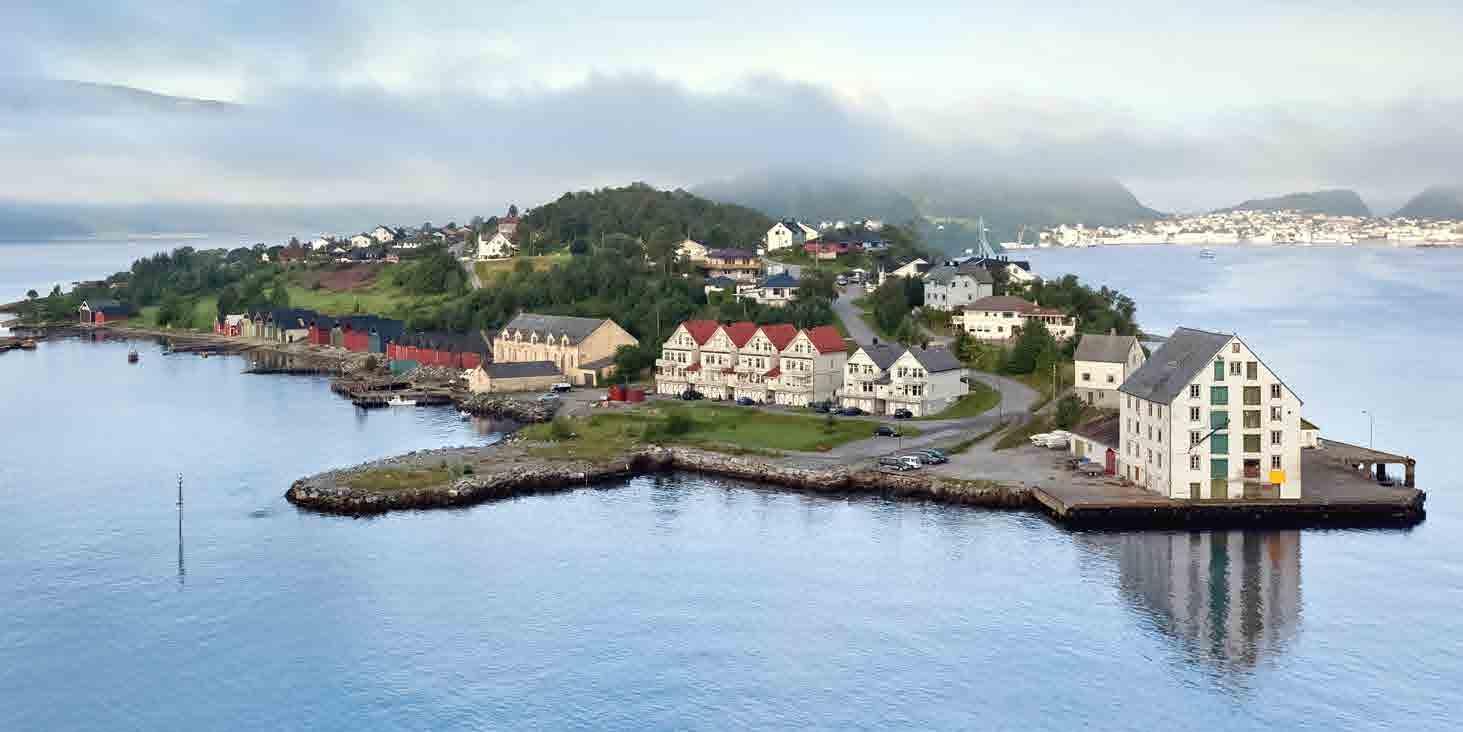
71 VOYAGER 13/2018
ÅLESUND—PATHWAY TO THE ATLANTIC—ÅLESUND
This route guarantees the experience you have probably seen only in videos on numerous occasions. You will stroll down a path with the waves of the ocean crashing against it and even splashing over to cover it. The path is winding at times and slanted or level at others, often enveloped in mist, with a big wave lying in ambush somewhere ahead. The scenery is equally impressive on sunny and warm days and on rainy and cold ones. This path, consisting of eight bridges extending a total of 8,274 meters, connects the smaller Averøy Islands to the mainland and other islands.
As part of the tour, the bus stops at the Eldhusøya rest area where you can stretch your legs. The area includes a café and restrooms. On your way back, you can stop at a quaint small settlement called Molde with beautiful views, cafes, and streets.
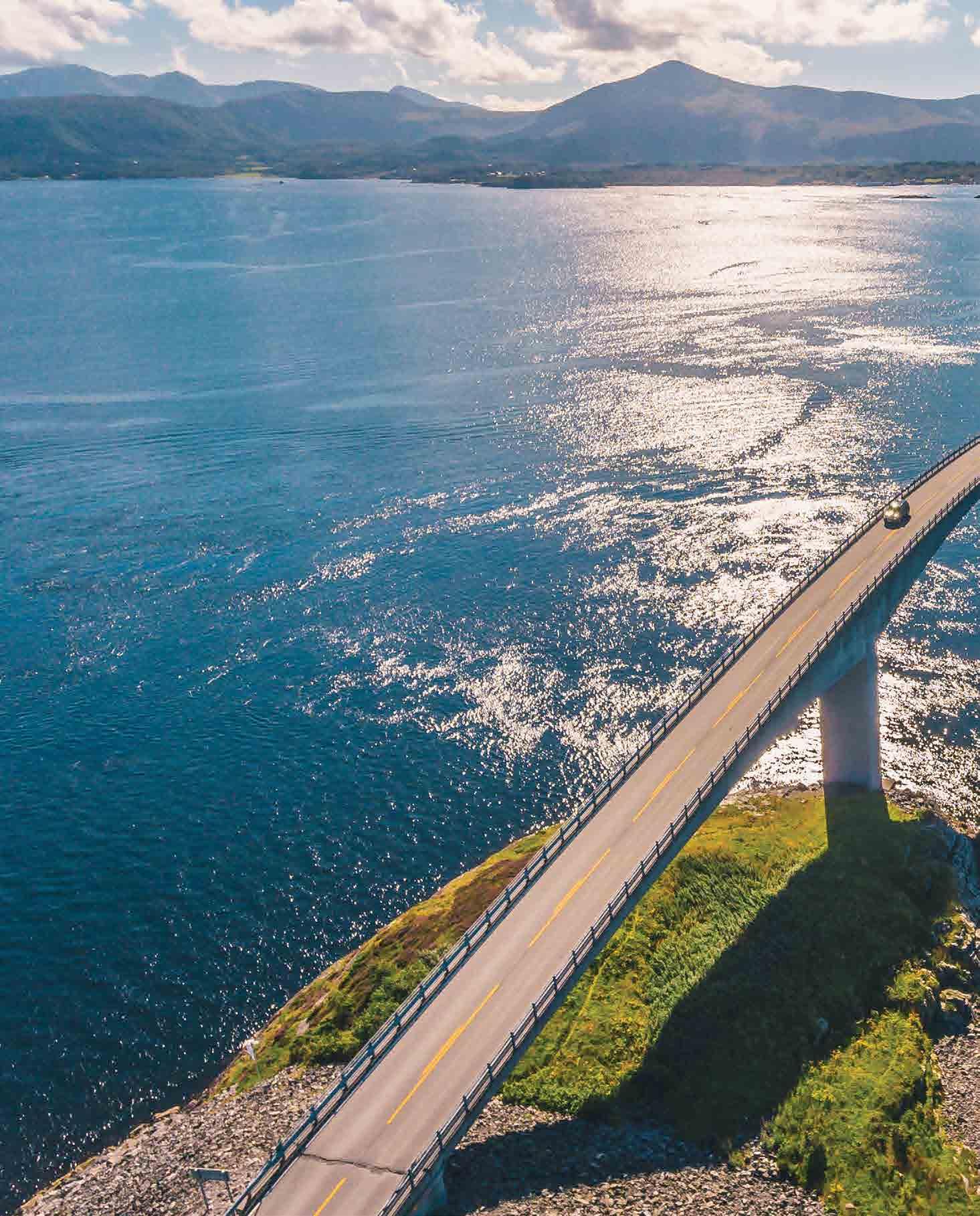
ÅLESUND
72 VOYAGER 13/2018


73 VOYAGER 13/2018
SOLAR WIND HUNTERS

NORTHERN LIGHTS
SALOME KIKALEISHVILI
74 VOYAGER 13/2018
Northern Lights in the Tromsø Area
I cannot speak for everyone, but every time I manage to get away from the brightly lit big city and find refuge somewhere far away, in a mountainous area for instance, I do the same thing – I observe the night sky hoping to be lucky enough to catch a glimpse of the star-studded Milky Way. No, I do not aspire to see gigantic, colorful, bright vertical polar lights. I can easily settle for a shooting star and a wish I can make while it is burning in the sky.
Apparently, I am not the only one. An active hunting season for stargazers like me is in full swing from September through March. Every year during this period, northern countries and regions like Norway, Sweden, Finland, Iceland, Canada, and Alaska swarm with northern lights chasers. Word has it that Norway is an exceptionally favorable place to contemplate this spectacular sight, with the country’s numerous travel agencies offering a Golconda of both land and sea tours. Thus, if stargazing is your childhood pastime, why don’t you up the ante and go straight for enjoying the northern lights in Norway? The more videos or photos I see, the more I become convinced that this show is out of sight, literally! The aurora borealis, they say, is something you absolutely must see before you finish your journey on this earth.
As a term, the northern lights, the same as the Aurora Borealis, was coined by Galileo Galilei who, in 1619, used the name of the Roman goddess of the dawn and the Greek name for the north wind to describe this natural and yet otherworldly phenomenon. It was believed in the ancient past that these magical colors appearing in the sky were
the traces of the chariot of the goddess Aurora, marking the dawn of a new day. In China, on the other hand, it was believed that these bright lights appeared every time the evil and good dragon engaged in combat, while, in Japanese culture, this sight was considered a good omen ensuring success. In ancient Finnish folk tales, the shimmer of the northern lights appears when the mythological fox sweeps a mountain with its tail, sending sparks into the sky. But that was a long time ago, and along with civilizations’ advancement, a spade is now called a spade.
The sun produces innumerable charged particles that multiply when the luminary is especially active. The resulting excitation of atmospheric constituents emits light of varying color and complexity like an explosion, spreading fast-moving charged particles thousands of kilometers from the sun.
As they enter the atmospheric layer of the earth, they interact with atoms and transmit their energy. As a result, the galvanized atoms emit what we perceive as visible radiance in the form of the northern lights. Most of these lights are concentrated in areas known as lighting zones, which are best visible at night, in the night sky.

75 VOYAGER 13/2018
THE NORTHERN LIGHTS, THOUGH BEING RIGHT ABOVE, MAY APPEAR AS FADING GREEN OR RED LIGHTS, AS THOUGH DISTORTED SUNRAYS.
As a rule, solar wind hunters encounter pink, green, yellow, blue, and violet shining lights, even sometimes carrotorange and white. As a rule, solar particles and oxygen produce a yellow or green lighting, while interaction with azote produces a violet or blue effect.
Now imagine being part of the swarm of solar wind hunters about to witness the play of light offered by the northern lights. A period until April is the best time when Norway is your finest hunting venue. Importantly, at the very outset of my northern lights study, I realized that it was not the only gripping pastime for winter visitors in Norway.
Husky or reindeer sledding, spending a night in the Ice Palace, enjoying hot meals by a fireplace in a Sami tent, and contemplating whales make up an incomplete list which can go on and on, but let’s be consistent.
Yes, you can avoid travel agencies, heading instead straight into one of the Northern Norwegian towns, and go northern lights chasing by car at night, but I believe that professional assistance will make things much easier for you, because nearly all travel agencies promise to accompany you in your wandering until you find a show of your liking.
Obviously, they are better in making their way through the mazes of trails at night, and to find the most mesmerizing attraction, you need to get away as far as possible from the city and its lights.
მIF YOU STILL DECIDE TO GO SOLO, YOU SHOULD CONSIDER SEVERAL FACTORS IN ADVANCE, PLAN YOUR ROUTE AND MAKE SURE YOUR PHYSIQUE IS UP TO IT.
BY ALL MEANS, CONSTANTLY CHECK THE WEATHER FORECAST TO AVOID STANDING IN THE DARK AND IN THE FREEZING COLD WITH YOUR CAMERA IDLE.
ALSO MAKE SURE YOU HAVE A THERMOS WITH ENOUGH TEA OR COFFEE, OR EVEN HOT CHOCOLATE.
And now a few words about the most common mistakes made by travelers seeking the sky show in Norway.
STOPPING IN THE COUNTRY’S SOUTH - Yes, Norway’s population is not large at all. On the other hand, the country occupies an enormous territory of 385,252 square kilometers. Remember that those photos of people enchanted by this spectacular sight can be taken anywhere in Norway. On the contrary, the closer to the Arctic circle you are, the better shot you have, which is why it is better to start your journey from Oslo, especially if you plan to stay for just a few days, and then head to the north. The best
spots to observe the northern lights include Tromsø, Alta, Vesterålen, the Lofoten Islands, the Svalbard Archipelago, Narvik, Varanger, and Bodø.

SHORT VISITS may prove to be another obstacle. Remember that you may very well return to your hotel empty-handed after a hunting session, because the cloudy weather and thick mist enveloping the sky may obscure the sight. So block at least four days for your hunting adventure.
I certainly hope that you will never share the sad fate of one chaser whose 7-day northern lights chasing tour on the Lofoten Island produced nothing more than a No Images inscription.
INADEQUATE CLOTHING – imagine departing in the company of your guide at 8 pm, with 8-10 hours of wandering in the wilderness and peering into the sky, and the temperature outdoors way below 0. You absolutely need thermal wear, light, and the ideal clothes for protecting from cold and winds. And, of course, nothing will work without insulated footwear.
NORTHERN LIGHTS
76 VOYAGER 13/2018
CHOOSING SUMMER TO WITNESS THE NORTHERN LIGHTS – it is beyond my comprehension why anyone would make that mistake, but there have been instances of tourists arriving in the summer expecting to enjoy the sight of the northern lights and completely missing out. Still, if you happen to be in Norway on warm days, you do have another spectacular sight to anticipate, the night sun. This miracle in Tromsø starts in mid-May and lasts until July 22, but the longest show takes place in Svalbard, the same as the Spitsbergen Archipelago, from April 20 through August 22.
TOURING AT RANDOM
There are many travel agencies in Norway offering all kinds of tours for different prices. It would be prudent to browse through the websites of tripadvisor, Frommers, or visitnorway at least once to schedule a journey in advance to suit your preferences. It is also advisable to keep your passport on you, because you never know where tour operators may lead you – they themselves cannot know everything in advance. Let’s start with www.visitnorway. com, the best website to consult if you are planning to visit Norway, as it answers pretty much every question,
from accommodation and sightseeing to offering the most suitable activities. Although the site offers a wide choice, still we can single out a couple of offers. Ready?
VARANGER – if you are really eager to experience what the real Arctic frost feels like, you can go husky-sledding for 20-30 kilometers and enjoy the amazing landscapes of this region, or you can go for a night tour and kill two birds with one stone by contemplating the northern lights while enjoying a sledding tour. Later, as you start feeling chilled to the bone, you will be invited to a Sami triangular tent and treated to a hot meal.
ALTA – a journey to Alta will cost you 3,490 NOK (approximately 1,000 GEL), where you will spend two nights on the fjord, in a wooden complex sandwiched between two mountains. The price includes breakfast, an airport shuttle, and one night of chasing the northern lights. By the way, Alta is famous for its Rock Carvings enshrined on the UNESCO World Heritage List. Just four kilometers from Alta, you can contemplate these rock carvings dated 4200 BC and depicting religious rituals and hunting scenes.
NARVIK is another excellent mountainous area for Arctic pastime. For 1,495 NOK (500 GEL), you can take a trip to a small village, and while you are waiting for the northern lights to appear, you’ll meet some reindeer, whom you can hand-feed, and then you will be invited into a Sami tent to get warm by a bonfire and enjoy snacks. Throughout this journey, you will be accompanied by a guide to tell you all kinds of stories about Sami culture and traditional crafts. In Narvik, you can stay in the Scandic Narvik Hotel believed to be the tallest building in Northern Norway. One night in a double room cost 1,008 NOK (300 GEL).
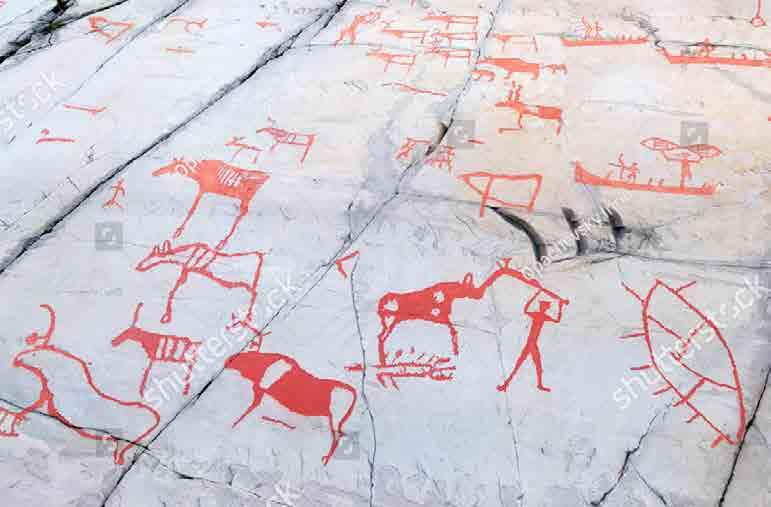
A piece of advice: Visit the hotel’s bar on the 15th floor to sip your favorite cocktail and enjoy the sight of fjords and mountains.

77 VOYAGER 13/2018
HELGELAND is Norway’s region in the south of the Arctic Circle, one of the least populated and is ideal for those fond of skiing, fishing, and canoeing in the sea. Visitnorway.com offers a 7-day tour including accommodation and food. Tourists are greeted at the Bodø airport. Every day here starts with skiing.

Skiing, boating in search of the northern lights, and a visit to the local Museum of Fishing will cost you 17,250 NOK (5,500 GEL) and up.

Finally, we reach TROMSØ where tourists are offered what the locals call the Aurora Program, which includes snow scooter skiing and an evening in a glass domed building. No, the building is not all transparent like the Snow Queen’s Palace. Every detail here is well-calculated. For example, this ball-shaped structure is partially clad in wood and has a flaming fireplace in the middle. The upper sections of its walls are all transparent to enable you to contemplate the star-studded sky by the fireplace. This 24-hour tours kick off at 9 am. For starters, you will be given special clothes, followed by a two hour snow scooter photo session. Next, you will be offered to go skiing or rest in the crystal ballshaped transparent house.
In the evening, photography workshop sessions are held along with dinner, during which you will learn photographic techniques suitable for shooting the northern lights. Finally, you will get a chance to go northern lights chasing. The tour costs 3,600 NOK (almost 1,200 GEL).
While in Tromsø, we advise you to stay at the SCANDIC ISHAVSHOTEL, the winner of the prize for the best breakfast in Norway in 2017. A standard room costs 1,970 NOK (600 GEL), which naturally includes “the country’s best breakfast.”

NORTHERN LIGHTS
Do you know that there are 98 airports in Norway, of which 24 are located in the country’s north?
Consequently, it makes perfect sense that covering long distances in Norway is as easy as pie, which gives you the luxury of planning tours in regions far away from one another. The Widerøe Norwegian airline offers northern lights fans trips to places quite close to the aurora borealis.
These special flights held by the company from November 20 through March 5 depart from the Tromsø Airport. In the course of one hour, experienced pilots will fly you close to the aurora borealis and offer you a glass of champagne to make your soaring experience even more unforgettable.
If you prefer to sit by the window with your nose pressed against the glass and enjoying the rainbow-colored sky though, you will have to pay an additional 600 NOK (200 GEL).
Earlier we mentioned Tromsø, one of the key destinations in our Arctic journey. The 7th largest city in Norway is part of Lapland. Tromsø, one of the largest cities in the region, is often referred to as the Paris of the North and the City of Polar Lights. Although only 350 kilometers separate it from the Arctic Circle, it’s characterized by a mild climate.
Most importantly, it used to be the starting point for Arctic expeditions, which is why it is also known as the Gateway to the Arctic.
If you plan to familiarize yourself with Norway via the Gateway to the Arctic, you can book a room in one of Tromsø’s hotels and join a single one-night northern lights hunting tour.
 Northern Soul Adventures northernsouladventures.com
Northern Soul Adventures northernsouladventures.com
Established in 2016, this company is believed to be one of the best on tripadvisor. “We spent years travelling the world and living abroad, seeking inspiration for what we do today,” the company’s website reads. They promise to take us places with less traveled roads to immortalize on photo film some of the best moments in our life along with colors dancing in the sky.
For 1,550 NOK (500 GEL), you will become a member of a team of seven. The company’s vehicles are fully equipped with everything you may need in the Arctic. As part of the tour, you will be treated to seasonal vegetable soup and all kinds of snacks. There is no way in the world you can get bored on this trip because the company promises a rich storytelling atmosphere. They also take pride in their homemade cookies and their ability to welcome vegans with love and happily meet their preferences. Next, they will take pictures of your elated and slightly frozen faces against the backdrop of the northern lights and present you with “your happy moments caught on camera.” They will also light a bonfire for you and, if necessary, provide thermal clothing. This pleasure lasts 6-9 hours. Frankly, I have read so many loving comments from tourists about their guides Jeff and Hanna that I would readily go out with them, without even seeing the northern lights.
If you prefer to stay away from a crowd of strangers and make discoveries in solitude, you can always pick a personal tour by paying 9,850 NOK (slightly over 3,000 GEL) for this pleasant experience.
79 VOYAGER 13/2018
Arctic Guide Service
arcticguideservice.com
Established in 2006, this travel agency offers several versions of rest in the Arctic. They claim to be experts in northern lights tours and guarantee impressive attractions from October 17 through March 31. Their northern lights chasing starts in Tromsø at 6:30 pm and lasts until 1:30 am. Their bus or minibus tour is accompanied by a professional guide whose mission is to find the best spot for you.
On average, adults pay 980 NOK (slightly over 300 GEL), and children aged 3-12 pay 500 NOK (160 GEL). The prices include hot chocolate, cookies, and photos taken during the expedition.

If you go for the northern lights photo tour, you will spend some quality time with professional photographers to assist you in capturing the best moments on film. In this case, the fee is just over 500 GEL, but capturing a show in the sky is said to be no easy task for amateur photographers, and the price also includes hot chocolate and a modest supper with cookies.
Chasing Lights chasinglights.com
If you are a true fan of the northern lights, and know that one night is not nearly enough, this company gives you a chance to go lights chasing for a favorable price. A onenight tour costs about 950 NOK (300 GEL), but seven nights will cost you as low as 2,500 NOK (800 GEL).
Please keep in mind that the price includes travel by bus, so there is a big chance of finding yourself in the company of 50 other chasers. If you choose a smaller group, you will
end up paying 1,800 NOK (600 GEL). The company promises to select a destination depending on the weather, so you may end up on an island near Tromsø or on the way to Finland. The company promises to go the extra mile for you, and that is why they claim to be better than anyone else in the business.
Every tour is crowned with hot chocolate and cookies, and fresh photos are guaranteed to be waiting in your inbox even before you get back to the hotel. In addition, the company promises to provide you with special clothing in case you are missing any.
Arctic Adventure Tours Arcticadventuretours.no
This company has a gripping offer. Besides the northern lights, it invites you to whale chasing and husky sledding. The whale chasing season – or whale watching season, to be precise – lasts from November to January and promises 2.5 hours of an unforgettable experience for 2,500 NOK (800 GEL). And if you prefer dog sledding, keep in mind that this journey lasts four hours, 90 minutes of which you spend snuggled in the sled, and for as low as 1,750 NOK (600 GEL), at least for a while, fancy yourself Robert Flaherty’s character, Nanook of the North.

NORTHERN LIGHTS
80 VOYAGER 13/2018
During the day, you can spend quality time familiarizing yourself with Tromsø’s cultural life and enjoy a nice meal at one of the places below.
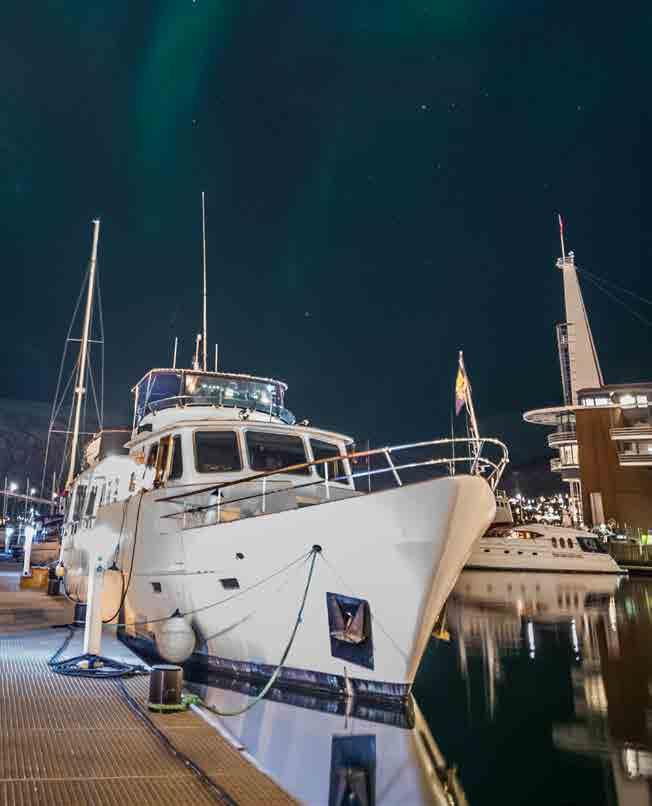
Hildr Gastro Bar
www.hildrgastrobar.com
Skippergata 11, 9008 Tromsø
Hildr Gastro Bar’s 1960s-style interior may remind you of a hunter’s hut. The place is always crowded. Besides traditional Norwegian dishes, you will come across many innovative culinary experiments. Thus, if you opt to dine here, my advice is to book a table in advance, or avoid visiting the joint in rush hour – you won’t get in anyway.
Aunegarden
www.aunegarden.com
Sjøgata 29, 9008 Tromsø
Hildr Gastro Bar’s 1960s-style interior may remind you of a hunter’s hut. The place is always crowded. Besides traditional Norwegian dishes, you will come across many innovative culinary experiments. Thus, if you opt to dine here, my advice is to book a table in advance, or avoid visiting the joint in rush hour – you won’t get in anyway.
Burgr Bar
www.burgr.no
Skippergata 6A, 9008 Tromsø
This place is worth visiting for both food and entertainment, especially if you are a gambler, or were one in a past life. Decorated with old posters, this bar serves the best burgers, after enjoying which you can try your luck with a 1970 arcade game and choose one or more from a selection of 2,000 games.
Raketten
fb: Raketten Bar & Pølse Storgata 94B, 9008 Tromsø
Arctic fast food? Why not? Raketten is a tiny booth built in 1911 where mouthwatering hotdogs with Norwegian sausages are served. After picking the hotdog that tickles your fancy, you can find a comfortable seat outside and enjoy your steamy sausages.
hotel, surrounded by white sculptures. Of course, your gastronomic preferences are met throughout the trip, and every evening you are treated to Arctic dinners at different restaurants.
On the fourth day, you fly to Tromsø where you spend two nights. At first, you enjoy local dishes at Emma’s Dream Kitchen, a restaurant favored by gourmet connoisseurs. Next, you travel to gorgeous valleys and go reindeer sledding through snow-covered Norway. Needless to say, a bonfire is included to accompany a show of colors dancing in the sky. On the six day, you fly back to Oslo.
We absolutely must mention Hurtigruten.no. Hurtigruten is the largest sea operator in Norway sailing boats, ferries, and smaller or larger ships since 1893. Fairly recently, it launched operations in Canada, Iceland, the Arctic. The company offers very exciting and expensive tours. Just imagine repeating the Viking Way today, starting in Norway, sailing to Scotland next, and eventually arriving in Reykjavik, in the cryptic land of Iceland.
This 11-day cruise will kick off on May 8, 2019 in Bergen, a city established in 1070, and will cost 39,229 NOK (about 13,000 GEL). Or, how about a 7-day Christmas tour starting in December in Bergen and covering the entire coastline of Norway? Late at night, you will look at the northern lights from the middle of the sea and watch whales jump during the day. The company also promises to teach you Norwegian Christmas carols so you can perform them together with your hosts. The cruise costs from 12,220 NOK (4,000 GEL) per
Next, let’s consider another alternative for those of you who prefer a completely planned tour and a busy schedule for every day of your stay in Norway defined in advance. In this case, you can just visit Oslo and use several-day tours offered by different companies, which include many other exciting sites besides polar lights.
Try Fjord Travel Norway / fjordtravel.no. These tours last several days and, as a rule, start in Oslo. The Northern Lights Break Tour lasts six days and costs accordingly: 19,900 NOK (6,000 GEL). You spend one night in Oslo, then fly to Kirkenes and enjoy an adventurous dog sledding trip in the evening. You spend the third night in a real snow
81 VOYAGER 13/2018
“Apparently, we are lucky to be able to observe the northern lights on an everyday basis, like on our way to school or work in the early morning,” famous musician Aggie Frost says.
“If you’re in Tromsø and want to escape the city lights and hubbub better to enjoy the beauty of the night sky, I recommend promenading to the beginning of Parkgata Street, a perfect place for you, or visiting Prestvannet Lake just a few kilometers from Tromsø. Besides being a wonderful place, contemplating the northern lights there is something else,” Aggie adds.
She often tours different Norwegian cities and has her own favorite spots in each. In Alta, for example, she frequents the newly opened public baths with outdoor pools. Just imagine, it is cold out there, freezing in fact, with hot vapors enveloping a blue pool. You dive for a second… and swim in warm water, very warm water, while snowflakes keep falling on your head. “That’s one of the most fashionable Arctic pastimes,” Aggie concludes.
Wiggo Antonsen is a cab driver from Svalbard who, after appearing in Life on the Edge, a BBC documentary, turned into an all-Norwegian celebrity.
“Some tourists believe they must travel to the end of the world to see the northern lights, but my motto is that there is no reason to go further than necessary. In the encompassing dark of Svalbard, the magic experience will be the same everywhere,” he says.
Wiggo recommends the northern lights mobile app Aurora Forecast 3D to avoid hits and misses and make sure you have a tripod to take quality pictures.
“Trying to capture the northern lights is like striving to take a portrait of hyperactive children. Try to stop them!” Wiggo, with his characteristic white beard, says.
YOU MAY HAVE NOTICED THAT WHEREVER YOU GO YOU FIND TWO CITIES: ONE SWARMING WITH TOURISTS, AND THE OTHER WHERE ONLY THE LOCAL SPEECH IS HEARD. THIS SECOND CITY IS USUALLY MORE EXCITING BECAUSE, BEYOND SHINY OFFERS, I ALWAYS SEEK WEBSITES WHERE LOCALS PROVIDE INSIGHTFUL RECOMMENDATIONS. AFTER HAVING LOOKED UP PRICES AND TOURS, I ONCE AGAIN GO FOR SOCIALIZING.
In the daytime, Anita Andresen has an ordinary administrative office job. But as soon as she is off duty, at least several times a week, she joins a group of her kayak-paddling friends to contemplate the aurora borealis near Lake Lofoten.
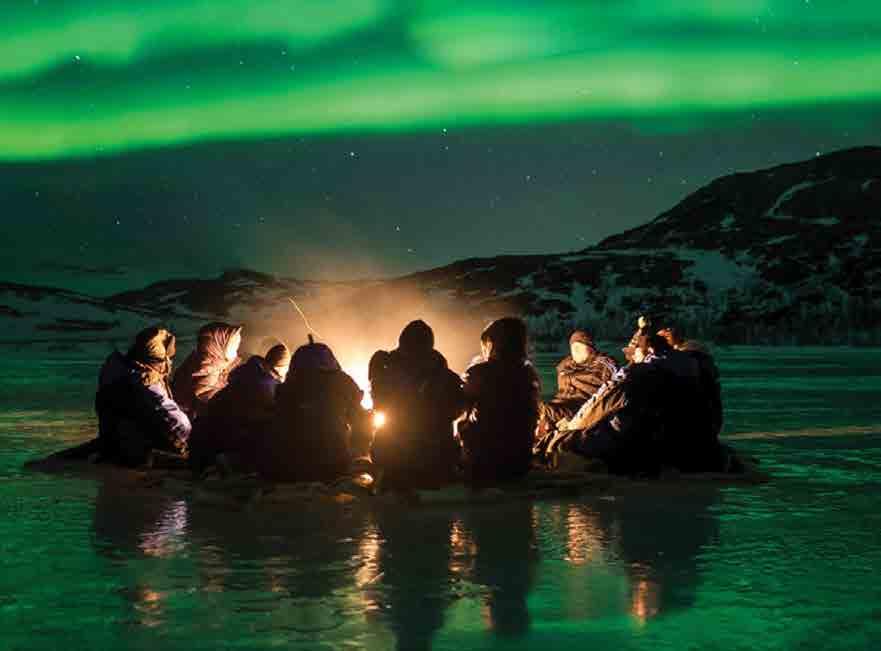
“But few things beat the sensation of kayaking whilst you see the northern lights above you and at the same time beneath you in the water, the luminous effect of what we in Norwegian call morild,” Anita explains.
“We have experienced being really close to whales. Is it dangerous? As far as I know, there has never been an accident.”
At the end of their evening journey, she and her friends ask the traditional question whether they should return home or spend the night outdoors in sleeping bags.
Frankly, after reading all this, I do not even need to close my eyes to imagine everything vividly enough. Moreover, I am a bit scared even, because I may come to believe, like the Finnish, that the shimmer of the northern lights appears when the mythological fox sweeps a mountain with its tail, sending sparks into the sky. Or maybe it is true? After all, Norway is partly Lapland, and we all know who lives in Lapland.
NORTHERN LIGHTS
82 VOYAGER 13/2018


LOFOTEN 84 VOYAGER 13/2018
You can wander through the abandoned fishing villages on the Lofoten Islands, contemplate the northern lights from September to midApril, or enjoy the sights of the midnight sun from May to July, go kayaking between islands or fishing, observe eagles soaring in the grey sky – one of the popular pastimes here. Because of the warm Gulf Stream, the climate on Lofoten is milder compared to the other settlements at this latitude, which is probably why artists are especially enamored by these islands. As a result, this area is famous for its numerous galleries, photo exhibitions, and refined culinary experimentations.
www. lofoten.info/lofoten
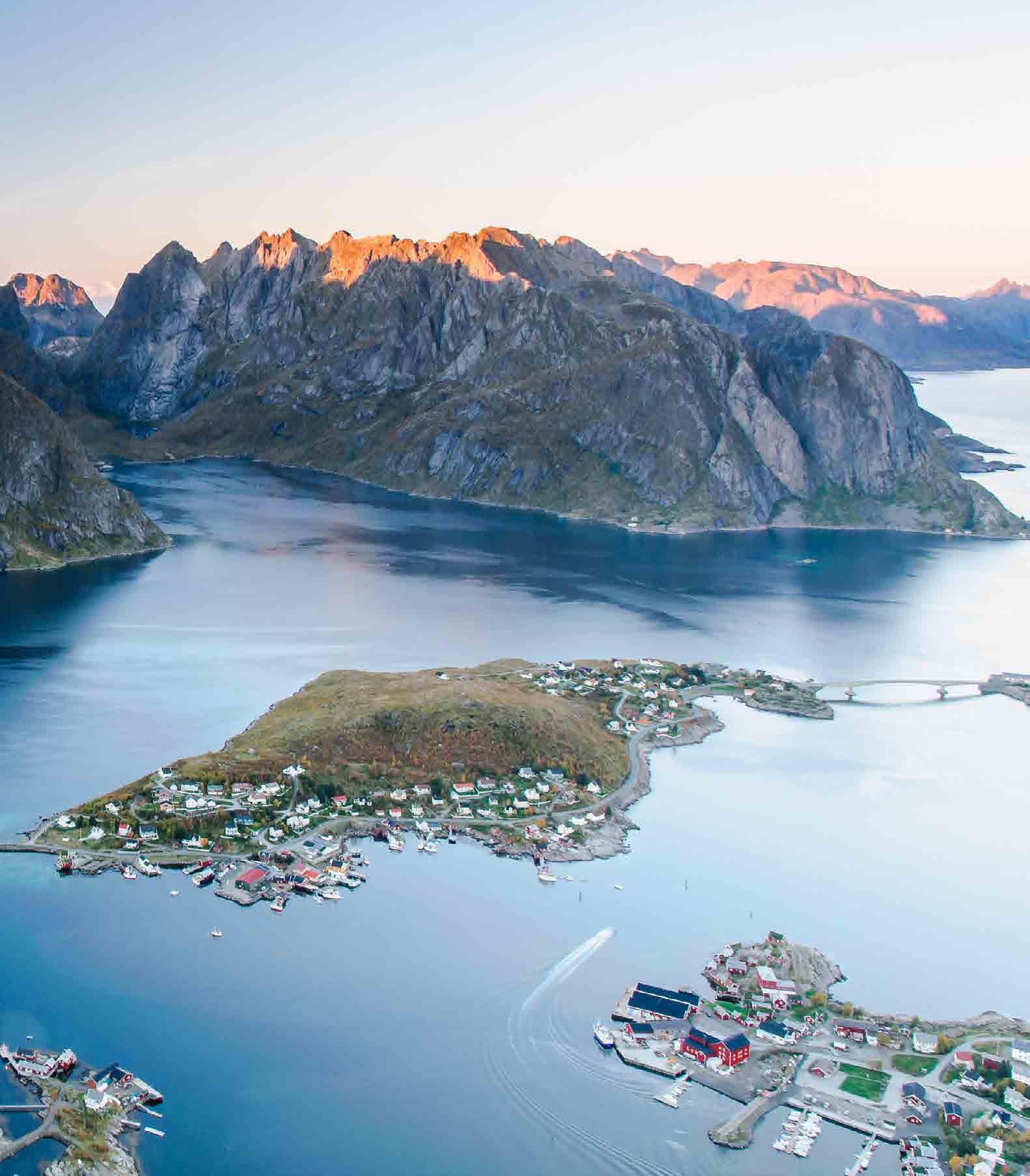
85 VOYAGER 13/2018
WAS, IS, AND WILL BE
In Norse mythology, the ash tree is the Tree of Life, with three women sitting at its foot, and their names are Was, Is, and Will Be, and together they weave the web of fate, and the present sitting in the middle connects the past to the future, and the tree under which they sit supports the earth with its roots….
I will never forget the moment when we, after ascending a winding trail up a forest strip, found ourselves on a plateau
carpeted with colorful mosses. In the light of the setting sun, the carpet cover under our feet seemed even more colorful. The breeze blowing over the small lakes scattered across the plateau created thousands of pearl-like ripples on the surface of the water. The carpet seemed to be alive. A red fox is hunting mice, and ptarmigans flushed from practically beneath our feet. At a distance, a hawk owl perched in a tree, and I had a feeling of seeing it all before. Tundra and the North: that was it, and that was where I was headed.

NORWEGIAN DIARY
86 VOYAGER 13/2018
ARCHIL KIKODZE Text/Photo
As a southerner, I have always been fascinated and enchanted by the North. Even before I had actually seen Norway, I had an absolutely special attitude toward its nature, literature, and people. And my journey, which I had been planning for years, could not be ordinary. I had to come to like this country, and after having been met at the Oslo Airport by my host, Eivin Furu, to take me to the tiny and absolutely unremarkable Langhus settlement, I could not help peering through the vehicle’s window and praising the country for its beauty. In response, my host only laughed: You ain’t seen nothing yet! And I really had not seen anything yet, but Eivin’s home – cold and packed with animal skins and stuffed animals – even that struck my

fancy. I loved the house which even its owner disliked; he could not wait to leave the place and go into the wild. Out of respect for me, he made the effort of staying one day to take me sightseeing. This is how we visited the home of polar explorer and conqueror of the South Pole Roald Amundsen, and Drøbak, a cute small town near the Oslo Fjord where Norwegians sank the German cruiser Blücher in April 1940.
That event marked both the beginning and the end of the war between Germany and Norway. As the cruiser entered the fjord and proceeded toward Oslo, Norwegian Commander Eriksen, without authorization from his
87 VOYAGER 13/2018
superiors, opened fire. Consequently, two coastal guns and two torpedoes hit the cruiser, sinking Blücher and its crew, which bought the King of Norway enough time to escape from Oslo to England. Next was long-standing guerilla warfare, but those two torpedoes and two cannon fires started and ended the war per se. It took me just an hour fully to appreciate the importance of the Blücher sinking to the Norwegians, and here is what happened. As my host and I were on our way, we dropped by at the studio of famous Norwegian artist Reidar Finsrud who had the whole place, along with the paradise-like backyard, packed with nude female sculptures. Eivin openly expressed his passion for one of the sculptures that reminded him of his sweetheart of old. Every time he happened to be passing by, he would stop there, undecided whether or not to buy it because of its high price. Inside, we were greeted by
Finsrud, a slim tall man in his 70s dressed in white coveralls. He welcomed us and disappeared. I went downstairs and bumped into the artist again, this time into his wax figure, though, one dressed just like the real artist a minute ago, with a brush in its hand, painting the Blücher sinking scene.

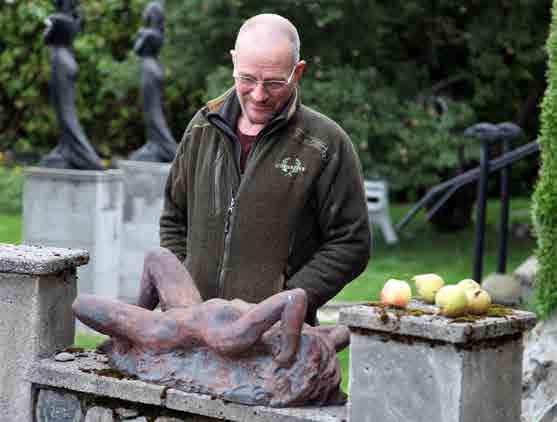

By the way, I liked this exhibit best. Next morning, Eivin reinforced his Volkswagen with winter tires. We loaded our belongings and embarked on a 200-kilometer trip to his hut at 1,000 meters above sea level. The place is called Limarka, and that is the real home of my host, a lone son of nature who just cannot wait to retire and move here, in the middle of the forest. Here he will find peace and quiet on the balcony where he can spend hours, even months watching birds and animals, watching seasons change, going hunting, fishing…

NORWEGIAN DIARY 88 VOYAGER 13/2018
The Norwegians and nature are as close as two coats of paint. There is nothing extraordinary about having a cottage outside the city, skiing, and sledding on a frozen lake, hunting, or fishing – still, Eivin seems special to me. He stood out among the large group of Norwegian naturalists I hosted and guided throughout Georgia four years ago. Reserved, short, and stocky, he turned out to be a master of all trades with a vast knowledge of nature. That week I spent in his hut was time away from everything, a lapse of time out of synch with my usual rhythm of life, from existence even, during which I did not think about anything, bad or good, oblivious nearly to everyone, and I felt good about being there, about wandering through the woods and treading on top colorful moss-covered plateaus, about being lost occasionally, then finding my way again, also about fishing, sipping whisky in the evening, and challenging my host to a dice game of Yahtzee.
Before hitting the sack, I would open Knut Hamsun’s book only to sink into sleep pretty much immediately. In the morning, I would light the stove, drink some coffee, and head back to the woods, sometimes together with Eivin and sometimes alone. By then, I had already learned where to find local birds or animals, how to tell their tracks and feces. Some I was able to find, others not. Early in the morning, I would find frozen puddles with pebbles visible under the thin ice and freshly fallen yellow birch leaves scattered on the surface. I embraced every moment of my stay there and now, looking back, I appreciate it even more. Three days after our arrival in Limarka, the trout fishing season ended and the huts around us became desolate, so I never encountered a single soul in my wanderings. Instead, I saw many birds and
animals I had never seen before… In the meantime, a full moon was on the rise. If it was too windy, we would place a small telescope on the balcony and observe the full moon. We were dressed warmly, and alcohol also kept us warm. In the morning, I would resume my wanderings.
I never had a chance to encounter an elk, but I would find its traces on a daily basis, in swamps and woods, and a sense of this giant animal, a true spirit of the forest, lurking somewhere nearby would fill me with a peculiar kind of reverence.

IF IT WAS TOO WINDY, WE WOULD PLACE A SMALL TELESCOPE ON THE BALCONY AND OBSERVE THE FULL MOON. WE WERE DRESSED WARMLY, AND ALCOHOL ALSO KEPT US WARM. IN THE MORNING, I WOULD RESUME MY WANDERINGS.
Generally, Norway’s nature has this ability of evoking reverence, making you feel small and yet important, making you see, imagine things, and scaring you at times. As I was fishing one late evening, the sights of a handful of leaves – barely hanging from a birch tree and swinging back and forth in the wind with a dark silhouette of a cliff in the backdrop – made me imagine unimaginable things…
The beds of the local rivers cut through granite cliffs, which is why their crystal-clear waters look black and menacing. These dark depths are as cryptic as the sky here,
89 VOYAGER 13/2018
as the northern lights. Cryptic seems to be the best word to describe Norway’s nature.
Next, we traveled further north, a trip we planned a year earlier to see the muskox, one of the most unusual creatures on our planet, in the Dovre National Park. Our 200-kilometer trip proved to be a special adventure in its own, with ascents to snow-covered passes and descents to green valleys. Norway has the best roads I’ve ever seen. Tunnels are cut under fjords, narrow bays, and to bypass small towns, which we took unless we had some errands to run. We would dive underground, and as we reemerged aboveground, whole cities would already be behind us.
We scheduled our trip so as to be able to visit as many landmarks as possible both to and from our destination. Still, we ended up passing by numerous beautiful spots. We would stop at Jatte Gritte, slot canyons cut through granite. Jatte Gritte means Giants’ Caves in Norwegian. Indeed, the water below seemed dark and boiling. One of the canyons is so narrow that Sigurd was said to have jumped across it carrying in his arms a woman he had kidnapped. Then he turned around to face the woman’s fiancé and his companions. For a moment, the two locked eyes with each other in silence. Next, Sigurd pushed one of his men into the chasm. The warrior vanished without a trace, telling the chasing party what awaited them if they decided to jump across the canyon. They turned around without uttering a word and left…


NORWEGIAN DIARY 90 VOYAGER 13/2018
This trip, among many other surprises, had one special treat for me up its sleeve. By sheer accident, we came across the birthplace of Knut Hamsun, a small farm once owned by the author’s parents. We untwisted the metal wire holding the gates closed and entered the farm to find a couple of wooden houses and a shed, a neatly mowed lawn, and a lifesized statue of my favorite author anathematized by his own people. I liked the statue because Hamsun looked stubborn and haughty. These characteristics must have defined his tragic fate, when the author in his advanced age tarnished his own reputation by collaborating with Nazi Germany.

It was cold as hell when we arrived in the Dovre National Park. Located at elevation, it consists of a plateau with occasional rounded mountains. We indulged ourselves by staying in a decent hotel for two days, and hired a guide to see muskoxen. To be precise, we joined his paid safari, the last one that year. The group had already come to Dovre, and tourist season was breathing its last.
The following day, after covering as little as four kilometers on foot, we saw muskoxen, an amazing sight, indeed. This odd creature, which is found only in the far north, is the product of an evolutionary misunderstanding, so to speak.


91 VOYAGER 13/2018
AND AS OUR GUIDE INFORMED US, RUNNING WOULD BE FUTILE BECAUSE THESE SEEMINGLY CLUMSY ANIMALS WITH THE THICKEST AND WARMEST FUR IN THE WORLD COULD RUN AT 60 KILOMETERS PER HOUR.
With its extremely small brain, this animal knows no fear whatsoever, and it is the only representative of Norwegian fauna encountering which may prove fatal for human beings. “But today no tragedy will take place. Why? Because I am here with you,” our young guide assures us with a touch of ambitiousness before embarking on our safari tour. Truth be told, he turned out to be a knowledgeable expert of these animals which, amid the whistling of northern winds in the middle of the colorfully dressed tundra, seemed to me to have time-traveled from the era of mammoths. Our guide knew exactly where to find them, when to draw closer to them, and when to back off.
The issue of muskoxen fleeing at our sight was not even a question. On the contrary, we had to make sure we would not end up fleeing from them. And as our guide informed us, running would be futile because these seemingly clumsy animals with the thickest and warmest fur in the world could run at 60 kilometers per hour.

A railroad line slices through the Dovre National Park. Male muskoxen, in their commitment to protecting their honor and harem, on top of being fearless to the point of stupidity, are willing to meet their death headlong if a train happens to be in their way along the rails…
After having given much thought to it, I could not help picturing a mammoth 300-kilogram bundle of muscles clad in long fur, an anachronistic survivor from the prehistoric
past, mounting a deadly attack on the Oslo-Trondheim high-speed train… There is something glorious about this scene I find absolutely touching. Next morning, we bid farewell to Dovre, and did an about-turn southward. Eivin’s vacation was about to be over.
We had a few hundred kilometers to cover to Eivin’s cold house, and the following morning I had to catch a plane from the Oslo Airport to Bergen, a most beautiful city built by German merchants on Norway’s west coast, where I would spend one rainy week.
Bergen turned out to be just as beautiful and rainy as described by many. At the airport, I got on the subway to the last station in the heart of the Old City, where I asked around for directions, walked to the House of Literature, and found myself in the middle of a conference celebrating the works of Norwegian female author Torborg Nedreaas. One of the speakers happened to be my host, poet Greta Fatima Saeed. Though I could not understand a word, I listened to this chirping-like language, which I soon missed so badly that, at the Frankfurt Book Fair, I would sneak into the Norwegian Pavilion to hear its sounds.
My friend and three other speakers were so attentive to one another’s speeches, and even held highly harmonious discussions, that they seemed to have conspired and agreed in advance who would say what after whom. Nedreaas’ picture on the wall portrayed a good-looking thin woman
NORWEGIAN
92 VOYAGER 13/2018
DIARY
with a big nose. She, a member of the underground resistance movement against Nazi Germany, a leader of the women’s movement, and a lady of a bohemian lifestyle with a long cigarette holder in her mouth, seemed to be looking down on us all, literally, as though knowing in advance how the conference would end. The topic of the conference, by the way, read: is there anyone in contemporary Norwegian literature and public life to assume the burden worthy of Nedreaas? The four moderators and the audience eventually agreed that there was no one of this kind.
The days spent in Greta’s home were full of small joys, dinners with impressive dishes, guests, warmth, chats about literature and Norwegian mythology, and concerts in the evening, a stark contrast to my stay in the hut, as though I had ended up in a different country. I promenaded through Bergen and its suburbs. Even though it kept raining nonstop, this city, scattered across steep slopes by the bay, still seemed very attractive. I would either walk or take a cable car to the mountaintop, and would return home soaking wet, invariably.
At night, I would open the window above my bed to let in the sounds of the rain and fresh air. Here and there, I would hear a forest owl hoot. Bergen is a tiny city, and the back of Greta’s house is bordered by forested slopes.

We would go on occasional car trips outside town. During one such trip, the police pulled us over and
asked Greta to take a breathalyzer test. It dawned on me that it was the first time I had seen a police officer in the course of three weeks. My hostess was very happy to have a chance to show her driver’s license, the second time in her life…
Bergen marked the last stop on my Norwegian journey, and I constantly felt it, also knowing that a new adventure awaited me next. But I also felt the strong ties from the past which bound me forever to Eivin’s hut and the trees around it, which must have dropped their last leaves by now, and might have even been covered in snow.
As we engaged in a dice game one evening, I asked him, “Are you, as a man of nature, not afraid of those long winter nights that throw all of Scandinavia into a state of depression?”
He thought for a second and then replied, “I am scared. I wasn’t in my youth, but as I grow older, the absence of the sun through long winter makes me weaker….”
So, while still in Bergen, I would imagine my friend returning to winter Limarka, lighting the stove, smoking a cigarette, feeding birds, and watching them for an infinitely long time. At night, he would play solitaire, a bachelor’s pastime. His solitude made me envy him and feel sorry for him at the same time… Even before I left Bergen, I knew I would return to Norway, and even now I know I will.
93 VOYAGER 13/2018
NORWEGIAN STORY
Few Georgians speak Norwegian, and they’re mostly those who have settled in Norway. For traveling purposes, though, English will do just perfectly. Only on the rarest of occasions will you come across a non-English speaking local resident. Learning the Norwegian language is quite an adventure of its own. It’s pretty difficult, especially writing.
The thing is that there are two kinds of written Norwegian language. Yes, the Kingdom of
Norway recognizes two official written forms: one is currently known as Bokmål and the other is Nynorsk.
These two written forms stem from Norway’s history and the story of the country’s independence. Because Denmark ruled Norway for almost 400 years, its language penetrated the various Norwegian dialects. In fact, Norwegian eventually became Danish, as it was. To be precise, the language in which
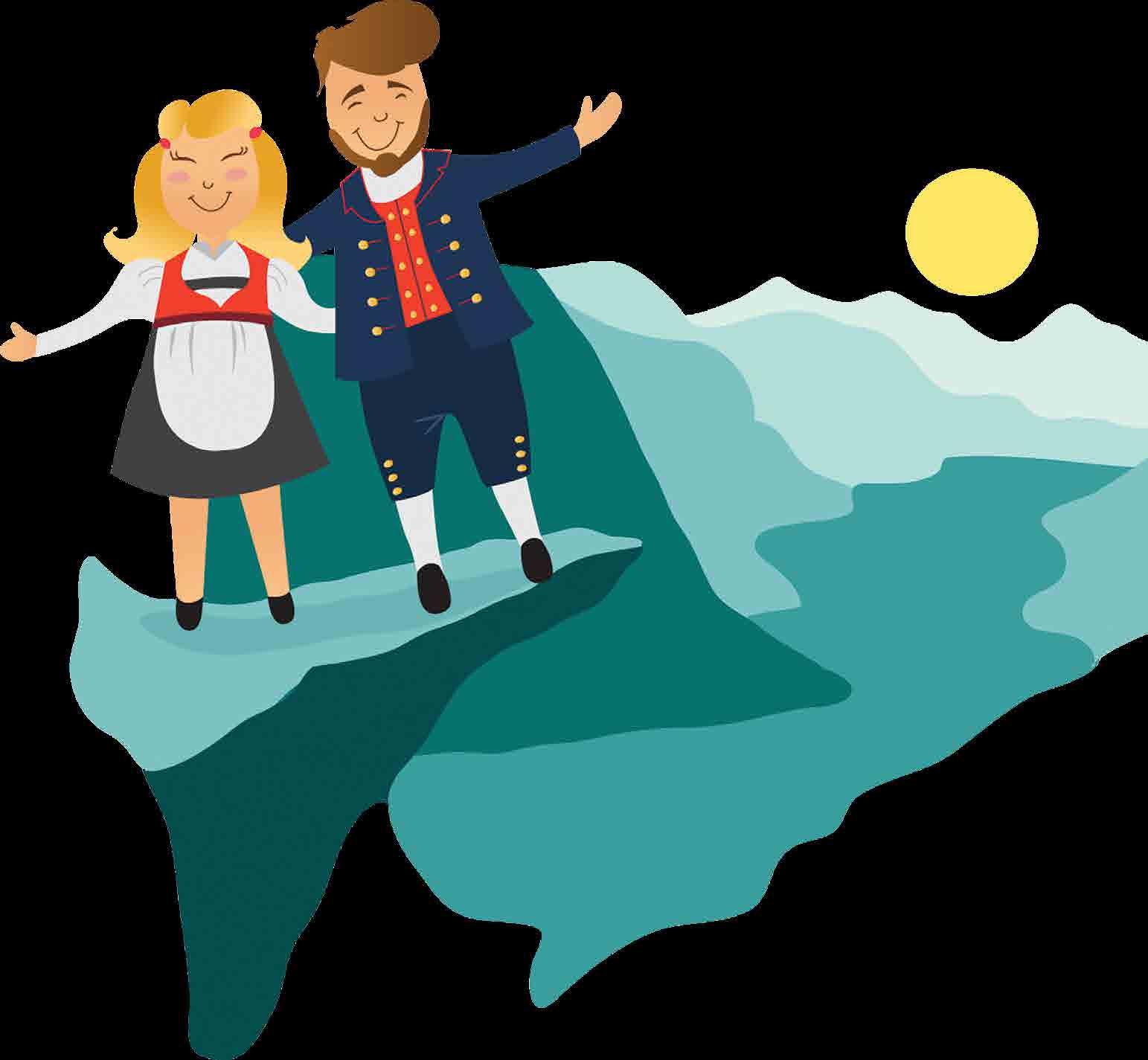
94 VOYAGER 13/2018
© forbrukerliv.no/happy-norway
AKA MORCHILADZE
LITERATURE
anything would be written in the country is actually Norwegian-style Danish with its alphabet stylized after Danish.
As the Norwegian language struggled to reclaim its place in the sun, this modified Danish language retaliated, and the Norwegian authors of that time continued to use it, though it accepted a myriad of all kinds of Norwegian dialects. At the end of the day, nobody had a clue what the right form or style of writing would be like.
Gradually, this Danish-gone-Norwegian written language developed into the country’s official language to be christened as Riksmål, meaning people’s or national language, at the turn of the 20th century. Over time, this written language developed its own standards and dropped some of its complexity. In about 30 years, this simplified Riksmål transformed into what is known today as Bokmål, literally book tongue. While Riksmål was being brushed up on, however, many Norwegians developed a different view on the essence of their state language, arguing that it was actually Danish, not Norwegian. Consequently, author Ivar Aasen commenced to develop a national tongue, Landsmål, based on the dialect of his native Western Norway. Over time, this Landsmål became known as Nynorsk, the same as New Norse or Norwegian, and gained a foothold as a written form. In all honesty, however, roughly every tenth Norwegian had already been familiar with its basic rules. Although Nynorsk grammar currently tends to follow the rules of Bokmål, it still observes a set of styles and norms that make up Høgnorsk, meaning High Norwegian, which is the primary, conservative Nynorsk written form.
Technically, these two languages are equal oral and written forms, and their norms are officially regulated by the unofficial Norwegian Academy. Along with Bokmål and Nynorsk, it is also perfectly acceptable to use the Riksmål and Høgnorsk forms, though they are not formally recognized. One way or another, switching from one form to another happens right and left in Norway.
The purviews of both Bokmål and Nynorsk cover only written aspects. As for speech, Norway is an epitome of freedom, as everyone is free to speak in their own dialect. Thus, while observing written language standards, no Norwegian will criticize someone for using “a poor, unacceptable dialect.” There are no
acceptable standards! He don’t know or you was is standard Norwegian, because there are no nationwide standards.

At some point, Norway tried to merge Bokmål and Nynorsk into one, with a lot of effort invested in grammatical issues to create Samnorsk, a hypothetical unified language. The idea failed because both languages seemed too precious to compromise. Still, this attempt gave rise to numerous innovations in both written forms.
Generally, both languages and their written forms are taught in Norway’s schools. A large section of the country continues to use Bokmål, Danish-gone-Norwegian, but the Nynorsk written form is invariably taught as a secondary subject, and vice versa. Each commune in Norway chooses by majority of adult voters which of the two must be taught as the primary language.
Every citizen is eligible to demand a referendum on this issue once every five years. In the past, that was the exclusive prerogative of schoolchildren’s parents, but later it was decided that language is a matter important to the whole community, so the number of voters expanded. One way or another, both languages are taught starting in the eighth grade.
Not all newspapers in Norway are published in Bokmål – some prefer Nynorsk, while others are bilingual, so to speak, publishing articles in both languages – but Western Norway, along with the mountainous areas in the south and some other sections, is certainly pro-Nynorsk because it is based on the local dialects.
Generally, the country’s map is said to have become more diverse and colorful. Even television stations broadcast in both languages, and official state documents are drawn up in both as well.
BOKMÅL AND NYNORSK ARE FREELY APPLIED AND USED LANGUAGES. THEIR DIFFERENCES, HOWEVER COMPLICATED, CONFUSING, AND COMPLEX AT FIRST SIGHT, ARE IN REALITY VERY SIMPLE AND EASY TO UNDERSTAND.
TECHNICALLY, THESE TWO LANGUAGES ARE EQUAL ORAL AND WRITTEN FORMS, AND THEIR NORMS ARE OFFICIALLY REGULATED BY THE UNOFFICIAL NORWEGIAN ACADEMY. ALONG WITH BOKMÅL AND NYNORSK, IT IS ALSO PERFECTLY ACCEPTABLE TO USE THE RIKSMÅL AND HØGNORSK FORMS, THOUGH THEY ARE NOT FORMALLY RECOGNIZED. ONE WAY OR ANOTHER, SWITCHING FROM ONE FORM TO ANOTHER HAPPENS RIGHT AND LEFT IN NORWAY.
95 VOYAGER 13/2018
INFILTRATOR FROM NORWAY
LASHA BUGHADZE
Fairly recently, some members of the Poti Municipal Assembly complained about a certain play staged in the local theater. Allegedly, the playwright had walked all over the performance of said elected governing body.
Some of the city’s bigwigs panned the play as slanderous, stating that the issues raised by it had nothing in common with reality – yes, there was a set of problems accumulating in Poti, but they were not nearly as pressing as the play portrayed them to be. Some even suspected the playwright of collecting material from opposition parties.
The theater’s manager could not believe his ears after hearing these accusations from the city’s authorities, especially those involving the author of the play. Yes, the play exposed problematic issues, but not necessarily those plaguing Poti because the text taken by the officials as their personal criticism was written a century earlier by the great Norwegian playwright Henrik Ibsen.
When Henrik Ibsen was writing his play An Enemy of the People, he was not very likely thinking of far-away Poti, though he was certainly thinking of a city where people’s interests, health, and welfare in general were countered by the interest of clans and “the high and mighty.” So it is more than plausible that someone like Herik Ibsen’s immortal and principled Doctor Stockmann could appear anywhere in the world, including in Poti, to oppose the majority and fall from grace with his friends and family on his way to becoming a hero, or, conversely, an enemy of the people.
That Henrik Ibsen’s literature is yet relevant has been reaffirmed, among other things, by the incident involving the Poti Theater, in which our less literate officials, to put it mildly, recognized themselves in this play hailed universally as a classic.

Such literary and social “misunderstandings” are, for the most part, related to authors who expose social and political issues in their works. For example, during the American witch-hunt for communists, dimwitted fanatics demanded the removal of “one communist Aristophanes” after viewing his 25 century-old play Lysistrata. Henrik Ibsen is one such author, always unbelievably relevant and understandably philosophical, exposing vices like a biblical prophet, and at the same time extremely attentive psychologically.
Ibsen’s topics remain just as dramatically relevant. Moreover, one may say that every decade in the 20th century finds new and shocking elements in his texts, be they A Doll’s House (a woman rebelling against her own role as a doll), An Enemy of the People mentioned above, Emperor and Galilean, an epic play about Julian the Apostate, and most importantly the most famous Norwegian play Peer Gynt which, on Ibsen’s personal request, was performed with original music composed by Norway’s most celebrated composer Edvard Grieg.
HENRIK IBSEN, BECAUSE OF HIS FARREACHING AND POWERFUL IDEAS, WAS NICKNAMED THE LION OF THE NORTH. OUTWARDLY, BY THE WAY, HE DID LOOK LIKE A LION WITH HIS IMPRESSIVE LION’S MANE-LIKE SIDE WHISKERS AND CHARISMATIC, EVEN INTIMIDATING GAZE. THUS, GIVEN THESE OR OTHER FEATURES CHARACTERISTIC OF IBSEN, REMEMBER THAT ONCE YOU ENTER HIS TERRITORY, REST ASSURED THAT YOU ARE UNLIKELY EVER TO BREAK LOOSE FROM HIS CHARM…
LITERATURE 96 VOYAGER 13/2018

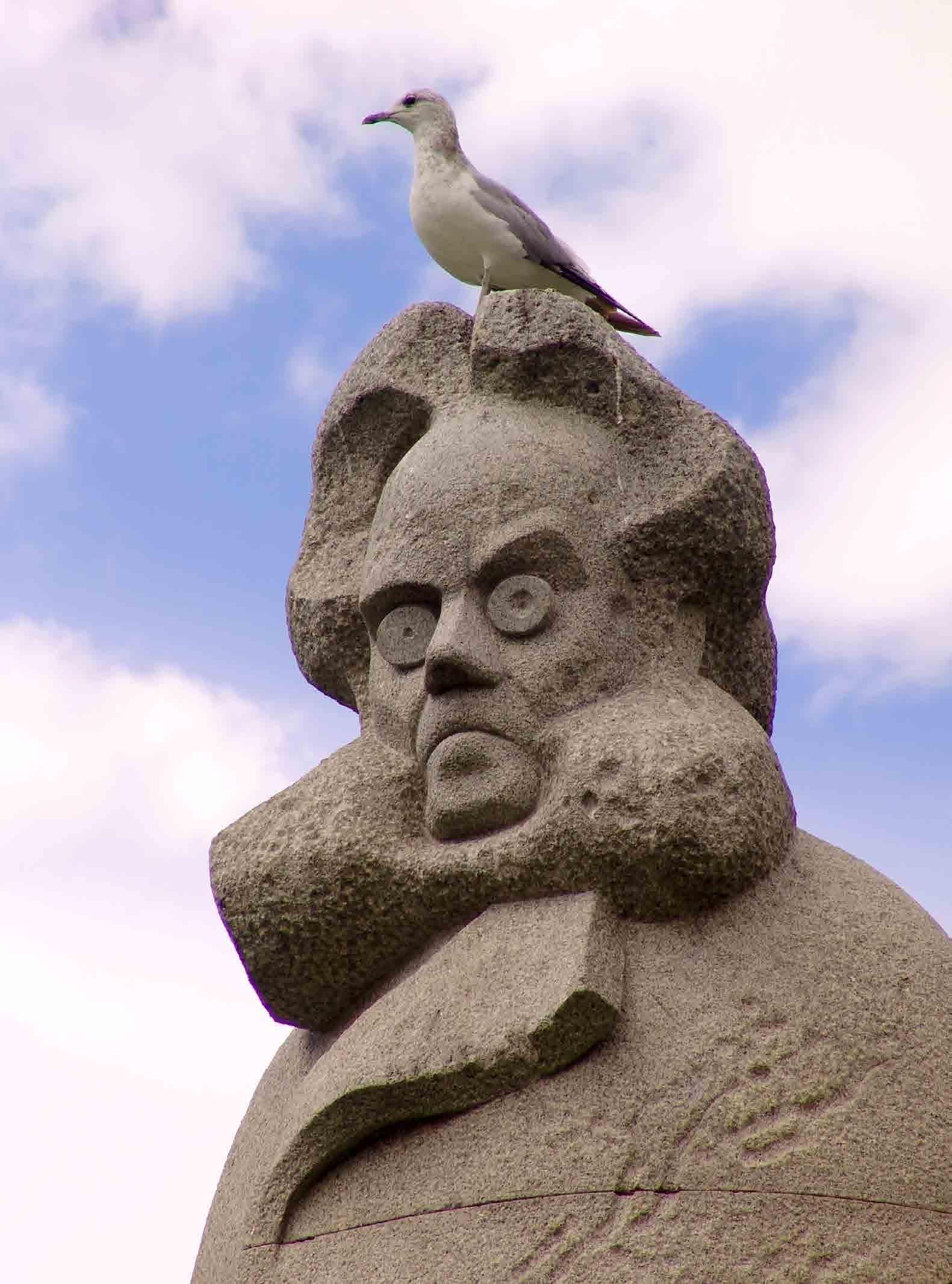
97 VOYAGER 13/2018
A GREAT AUTHOR SWEPT UNDER THE RUG
Knut Hamsun’s fate has been an odd one: he is praised as a great author and yet people are terribly ashamed of him.
Knut Hamsun is a classic author of Norwegian literature, one of the greatest and most multifaceted writers in the 20th century, a Nobel Prize winner, the father of modernism adored throughout the world, and yet not a single street in his homeland is named after him. Nor is his anniversary

duly celebrated, and no annual conferences are held to commemorate him, unlike what we see in the case of other writers, including Henrik Ibsen, another great Norwegian author.
Norwegians love Hamsun the writer, but feel infinitely embarrassed because of Hamsun the human being, because it is no easy task to justify how such cryptic,

LITERATURE 98 VOYAGER 13/2018
LASHA BUGHADZE
refined, and very humane literature could be written by a man who, even after the end of World War II, remained Hitler’s loyal admirer. In 1945, his family members nearly knelt to him and beseeched him not to say anything about the number one Nazi. Still, he dedicated a pompous eulogy to “the Last Teutonic Knight,” because Hamsun was a stubborn man, and this stubbornness cost his career a catastrophe.
Hamsun, brilliant in his novels, is just as banal and unbelievably shortsighted in his political antics. He seems to combine two persons: one is smart, kind, extremely insightful, with an underlying sense of humor and a touch of sadness, while the other is primitive, a demagogue poisoned by supremacist theories, someone who would be idolized only by some contemporary fascist like Anders Breivik, also a Norwegian.
The author of Pan, Hunger, and most importantly the immortal Mysteries has nothing in common with that other, boring, and shallow conservative.
Big literature has seen frequent cases of this bipolarity of values, as evidenced, besides Hamsun, by the brilliant poet Ezra Pound, or great and supposedly wise philosopher Martin Heidegger. The latter, for example, wrote a whole poetic and philosophical essay on Hitler’s deeply humane, extremely refined, and elegant hands.

Back then, other dictators also basked in the praises of their physical and intellectual characteristics. Stalin, for example, accepted laudations from a variety of writers and poets, from Boris Pasternak to Gigla Leonidze. But that was tribute, not sincere adoration, something designed to work their way into the graces of the great leader, which sometimes meant simply saving one’s own skin. Conversely, Heidegger, Pound, Hamsun, Bernard Shaw, and others – and André Gide, Jean-Paul Sartre, and the like in Stalin’s case – justified all kinds of demonstrations of tyranny without coercion, through their attitudes and goodwill….
Though not exactly racist theories, but certainly Slavophil views, were favored by Fyodor Dostoevsky whose doubleedged nature is brilliantly described by Sigmund Freud in his Dostoevsky and Patricide. In this work, the great psychiatrist links Dostoevsky’s father to the Russian emperor, which triggered in the author contradictory guiltrelated traumatic psychological processes which, at the same time, suppressed his will.
Hamsun did not have such problems. Hitler was not his father, and he did not have to forgive him his insults
and then come to love him (unlike Dostoevsky, according to Freud). Hamsun saw Hitler as an embodiment of North European glory who showed the whole world, especially “the Anglo-Saxons, the might of the Nordic spirit.” Despite his adoration, during his meeting with the Führer, Hamsun, with a surprising bluntness for a worshipper, complained about the Nazi civilian administrator in Norway and categorically demanded to put an end to the Gestapo’s brutal violence against the Norwegian people once and for all. Hitler must have laughed at Hamsun’s infantilism, but the stubborn author was being pushy enough to enrage the leader of the Third Reich to the point of foaming at the mouth. Naturally, this meeting did not end well, somewhat shaking Hamsun’s views, though not badly enough to make him realize, much less publicly recant, his fateful foolishness.
To this day, historians are puzzled why Hamsun, a tolerant man, sympathized with the Nazis, though in this particular case, psychoanalysis, not history, may be more helpful. Alas, Freud was too busy to analyze Hamsun; he had to save his own life – as the Nazis captured Vienna, he, as a Jew, could easily wind up in a concentration camp. One way or another, Freud’s elderly sisters, who stayed in Vienna, were soon sent to a gas chamber.
Reportedly, Hamsun did not believe that “the Teutonic Knights” would ever commit such atrocities and dismissed it all as propaganda. However, in his later years and, more importantly, writings were suffused with depression, regret, and disappointment, which is not surprising given that the author found his final refuge in a psychiatric ward and a nursing home.
It only makes sense that readers prefer “earlier Hamsun,” when he was not yet as zealously politicized and wrote his immortal masterpieces, not “later Hamsun.”
It was in his earlier years, in the 1900s, that he visited Tbilisi to collect materials for his play Dronning Tamara (Queen Tamar). He traveled in the company of his wife and settled in the London Hotel. Besides historical Tbilisi, Hamsun can be found in Aka Morchiladze’s Flight over Madatov Island and Back, in which this odd Hamsun-Pedersen makes an occasional appearance….
99 VOYAGER 13/2018
KNUT HAMSUN, ODD AND DUAL JUST LIKE HIS MAIN LITERARY CHARACTER, THE UNFORGETTABLE JOHAN NAGEL FROM MYSTERIES.
MYSTERIES
BAKUR SULAKAURI PUBLISHING
Celebrated Norwegian author and 1920 Nobel Prize Winner Knut Hamsun is well-known and loved by the Georgian reading community. As an author, Hamsun first received wide acclaim with his 1890 novel Hunger. In 1892, he published his second novel, Mysteries, hailed by many critics as the writer’s best work.
Published at the end of the 19th century, this psychological modernist novel contains numerous philosophical teachings popular in the 20th century. The novel describes an internal conflict, psychological struggle, and man’s place in the outside world. The main character Nagel, an extraordinary, dual, and lonely young man, is obsessed with constant, infinite mysteries.
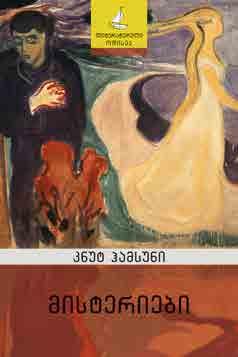
PAN, ANOTHER EQUALLY IMPORTANT WORK BY KNUT HAMSUN, HAS ALSO BEEN PUBLISHED IN GEORGIAN. EACH CHAPTER OF THE BOOK, WHICH HAS BEEN DUBBED AS THE GOSPEL OF NEO-ROMANTICISM, IS ACTUALLY POETRY SET IN PROSE (BAKUR SULAKAURI PUBLISHING).


ÅSNE SEIERSTAD ANGEL OF GROZNY
BAKUR SULAKAURI
PUBLISHING
Åsne Seierstad is a remarkable contemporary Norwegian author and journalist known for her accounts of the everyday lives of people in war and conflict zones. Her books Angel of Grozny and The Bookseller of Kabul were published in Georgian once, though no reprints have been issued yet. Seierstad’s latest bestseller, One of Us, describes the 2015 tragedy in Norway and its antihero, Anders Breivik.
JOHAN BORGEN LOVE STORIES
BAKUR SULAKAURI
PUBLISHING
Love Stories is a compilation of 14 novelettes by Johan Borgen.
Naturally, the compilation’s main focus is on love and living together. The novelettes’ heroes are extraordinary people with internal conflicts due to childhood or adolescent complexes.
KJELL ASKILDSEN A SUDDEN LIBERATING THOUGHT
GIA KARCHKHADZE
PUBLISHING
JOSTEIN GAARDER SOPHIE'S WORLD
BAKUR SULAKAURI PUBLISHING

Sophie's World is a thriller novel and a history textbook of philosophy in one. The book tells the story of 14-year-old Sophie who, one sunny day, receives a twosentence letter: “Who are you? How was the world created?” And that marks the beginning of Sophie’s adventures, her philosophical journey from Socrates to Sartre, an amazing mix of intellect and fantasy, enabling the reader to look at the universe through the eyes of a child.
AMALIE
SKRAM PROFESSOR HIERONIMUS
DRAMA PUBLISHING
Amalie Skram is a Norwegian feminist author who is reputed in Norway to be one of the most significant contemporary writers. Her literary career consists of three conventional periods: novels about marriage and family openly discussing feminine sexuality, a tabooed topic at that time; works about different generations, and novels featuring people with mental issues. Professor Hieronimus, a semiautobiographical work, is from the third category.
Kjell Askildsen is a prominent contemporary Norwegian author best known for his minimalistic short stories, in which characters struggle with loneliness at times or tackle existential problems at others. A Sudden Liberating Thought is a compilation of the author’s most famous and scandalous short stories.
HENRIK IBSEN ROSMERSHOLM
DRAMA PUBLISHING
Critics laud Rosmersholm as one of the best plays of Henrik Ibsen, a Norwegian theater critic, playwright, and poet. The play focuses on social and political changes when the traditional ruling classes stop pushing their ideals on the people.
OTHER BOOKS PUBLISHED IN GEORGIAN INCLUDE AMALIE SKRAM’S “CHRISTMAS SEASON”, HENRIK IBSEN’S “HEDDA GABLER”, JO NESBØ’S “HEADHUNTERS” AND “THE SNOWMAN”, AND ERLEND LOE’S “DOPPLER” AND “NAÏVE. SUPER.”

LITERATURE
KNUT HAMSUN
NORWEGIAN LITERATURE IN GEORGIAN 100 VOYAGER 13/2018
SIGRID UNDSET THE WREATH
MTP PUBLISHING
Sigrid Undset was a Nobel Prize-winning Norwegian author, primarily known for her trilogy Kristin Lavransdatter, a saga set in 14th-century Norway describing a woman’s life in the Middle Ages and her role from birth to death.
The Wreath, published in 1920, is the first installment of the trilogy.
ANNE-CATH.
PUBLISHING

Anne-Cath. Vestly, a Norwegian female author, created a series of fairytales about a poor but very kind and happy family, and Mother, Father, Eight Children, and a Truck is the first book in a series adored by children throughout the world.


“Mother, father, and their eight children lived in a limestone building, in the heart of one of the big Norwegian cities. This large family had a tiny apartment, just one room and a kitchen,” Vestly narrates.
Arne Svingen is a contemporary Norwegian author, a favorite younger writer whose works enjoy enormous popularity in Norway.

ASBJØRNSEN AND MOE NORWEGIAN FOLKTALES
MTP PUBLISHING
This book brings together classic folktales collected by Peter Christen Asbjørnsen and ethnographer and writer Bishop Jørgen Moe in 1840.
An elderly, wise, and wealthy grandmother invites her four granddaughters to spend a year with her.
A new school, new friends, chats about everyday matters – all this seems sometimes magical and sometimes scary.
The house is big, beautiful, and old, just like grandmother. The girls have different characters and temperaments. Under grandmother’s influence, they transform and develop.
ANNE-CATH. VESTLY’S “GRANDMOTHER AND EIGHT CHILDREN IN THE FOREST” AND OTHER BOOKS FROM THIS SERIES HAVE ALSO BEEN PUBLISHED.
The Ballad of a Broken Nose is a story about courage, fear, sports, and music, but firstly it is about one of those days when you suddenly realize that your life will never be the same. 13-year-old Bart has a tough life, but he remains optimistic, and knows that despair and despondency will change nothing. His mother pushes him into boxing to protect himself, but the boy has his own defense mechanisms, his positive attitude and… opera.
These two inspired the Brothers Grimm to collect fairytales, who, for their part, held Norwegian folklore in high esteem.
Some of the folktale characters from this compilation may seem familiar to Georgian readers, notably the younger brother Askeladden, the same as the Ash Lad, who resembles Georgian Natsarkekia in both name and character.

Maria Parr, the author of Waffle Hearts, is often likened to Astrid Lindgren, and rightly so: the entertaining, adventurous stories from her book will surely
remind you of the great Swedish children’s author, though the young Norwegian writer creates a totally different world full of kindness, loyalty, love, and sadness, a combination that binds the characters of Waffle Hearts, children and adults alike.
 DIKKEN ZWILGMEYER FOUR COUSINS
MTP PUBLISHING
VESTLY MOTHER, FATHER, EIGHT CHILDREN, AND A TRUCK BAKUR SULAKAURI
ARNE SVINGEN THE BALLAD OF A BROKEN NOSE BAKUR SULAKAURI PUBLISHING
MARIA PARR WAFFLE HEARTS BAKUR SULAKAURI PUBLISHING
DIKKEN ZWILGMEYER FOUR COUSINS
MTP PUBLISHING
VESTLY MOTHER, FATHER, EIGHT CHILDREN, AND A TRUCK BAKUR SULAKAURI
ARNE SVINGEN THE BALLAD OF A BROKEN NOSE BAKUR SULAKAURI PUBLISHING
MARIA PARR WAFFLE HEARTS BAKUR SULAKAURI PUBLISHING
101 VOYAGER 13/2018
NORWAY AS SEEN FROM A SMALL VILLAGE
Imagine yourself a Norwegian working as a TV screenwriter, eager to introduce your contemporary culture to the world and crazy about The Sopranos series and winter sports. So the boss of your TV station approaches you and says that you must write a screenplay for a new series for the upcoming television season. I can only speak for myself, so what I would do first is look around, find someone sharing my aspirations, and offer to team up for the project, which is actually how Anne Bjørnstad and Eilif Skodvin created a new series set in Lilyhammer, Norway’s most celebrated village.
Arguably, The Sopranos is the greatest TV series of all. And I’m not talking about visual storytelling or genius editing. I am talking about how it created a brand-new vision of television, imbuing the audience with sympathy for a depressed mobster antihero, along with complementary quintessential New Jersey-style gallows humor. It proved to be refreshing even for the Americans. In a nutshell, The Sopranos revolutionized the attitude toward television serials. Unsurprisingly, then, many of its characters have built a cult following.

SERIES
102 VOYAGER 13/2018
SANDRO
NAVERIANI LILYHAMMER A NORWEGIANAMERICAN TV SERIES (2012-2014), IS THE FIRST EUROPEAN PROGRAM FROM NETFLIX.
One such character is Silvio Dante, also known as Sil, played by Steve van Zandt. Van Zandt is not a professional actor. He is a musician, and I emphasize his musical background because his portrayal of Sil is brilliant, and obviously his artistry is just as striking in Norway as it is in Georgia or Denmark. And that is exactly why Anne Bjørnstad and Eilif Skodvin decided to create a sequel to The Sopranos about Sil’s personage, though under a different name, Frank Tagliano.
Frank’s new boss orders a hit on him, accidentally whacking Tagliano’s dog instead, at which point Frank feels that he has had enough and snitches on the boss to the feds. In return, he requests a new identity in Norway and asylum in Lillehammer which he calls Lilyhammer. Clean air, fresh white snow, gorgeous broads, and best of all, nobody but nobody's gonna be looking for him there – at least, that’s how Frank pictures his Lilyhammer and heads to Norway as one Johnny Henriksen.
That must have been the toughest part in the dramatic structure composed by Anne and Eilif. The rest was probably as easy as shooting fish in a barrel. Imagine an overzealous politically correct society, in which the biggest problem lies within integrating immigrants into Norway’s context and their assimilation into the Euro-Nordic cultural environment, and all that in a village of not more than 30,000 that once hosted the Olympic Games. Now imagine one of the most influential New York mobsters arriving in this village in an attempt to start off with a clean slate.
The initial narrative thread is so gripping that any screenwriter would give their right arm to work on it.
The series is flawless in describing Norwegian society and the cultural differences that set the Norwegians apart from the rest of the world. In Norway, you may be a hopeless junkie in the gutter, living off state welfare and using it up to get a hit, yet you may also file a grievance and have child custody taken away from some exemplary father, a genuine family man. Given Johnny Henriksen’s stature, no one can take anything away from him, but in real life outside the series, it is very much possible.
The discovery of oil deposits catapulted Norway into the small group of the world’s richest countries. Wealth, in turn, inspired the Norwegians to protect the rights of everyone and everything, giving rise to a society politically correct to the bone, all of which forced Norway to sacrifice on the altar of political correctness many of the traditions that used to define its identity in the common European family.
With the exception of a handful of scenes here and there, the New Jersey mobster’s integration into this society proceeds smoothly and painlessly enough to stun the Norwegians themselves. Johnny organizes reindeer races, leaving the locals wondering why it never occurred to them to do the same.

In one episode, Johnny Henriksen wins a Businessman of the Year Award. In his speech, he tells the locals that they have everything, but they have no clue how to have fun, that the Norwegians have forgotten what makes them happy, and what they really like, and how they used to have the time of their lives before a life of ease changed their way of living. When Johnny gives a Mac Book Pro for a birthday, for instance, another guest ironically presents a tree branch and explains it’s used to scratch backs.
Mutual respect is one of the greatest achievements of mankind. It sounds very philosophical, but it is true. Norway’s new society is grounded in mutual respect. Nonetheless, Lilyhammer occasionally demonstrates that this friendly and highly humane society requires change to enable it to express its emotions freely and to establish moral and socially acceptable behavioral filters.
Lilyhammer shows how badly Norwegian society needs novelties, and how eager and happy it is to embrace them. At the same time, this society is very rigid and jealous of any novelty emerging within its bosom, and that side of the story is described by the authors with equal brilliance. After moving to Lillehammer, Johnny Henriksen buys a club and fires its musician, Elvis, who is a police detective. Elvis probes into Johnny’s past and claims that he is a former mobster lying about
103 VOYAGER 13/2018
THE FIRST SEASON PREMIERED IN NORWAY WITH A RECORD AUDIENCE OF 998,000 VIEWERS (ONE FIFTH OF NORWAY'S POPULATION).
his background. Elvis shares this discovery with his colleagues, but no one believes him. They decide that he has lost his marbles. So they decide to send him on a relaxing vacation to Memphis, the hometown of the real Elvis. The pseudo-Elvis, however, keeps digging into Johnny Henriksen’s case. Eventually, he is murdered in New York.
This way, the authors expose one problem facing the Norwegians – what sounds ridiculous in Norway can get you killed in America.
If Lilyhammer teaches us anything, it’s the impact Norwegian society has on representatives of other cultures. It’s in this tiny village we see that the Norwegians have this distinct ability to take a vivid interest in new people, new cultures, and to try their best to give everyone a second chance.

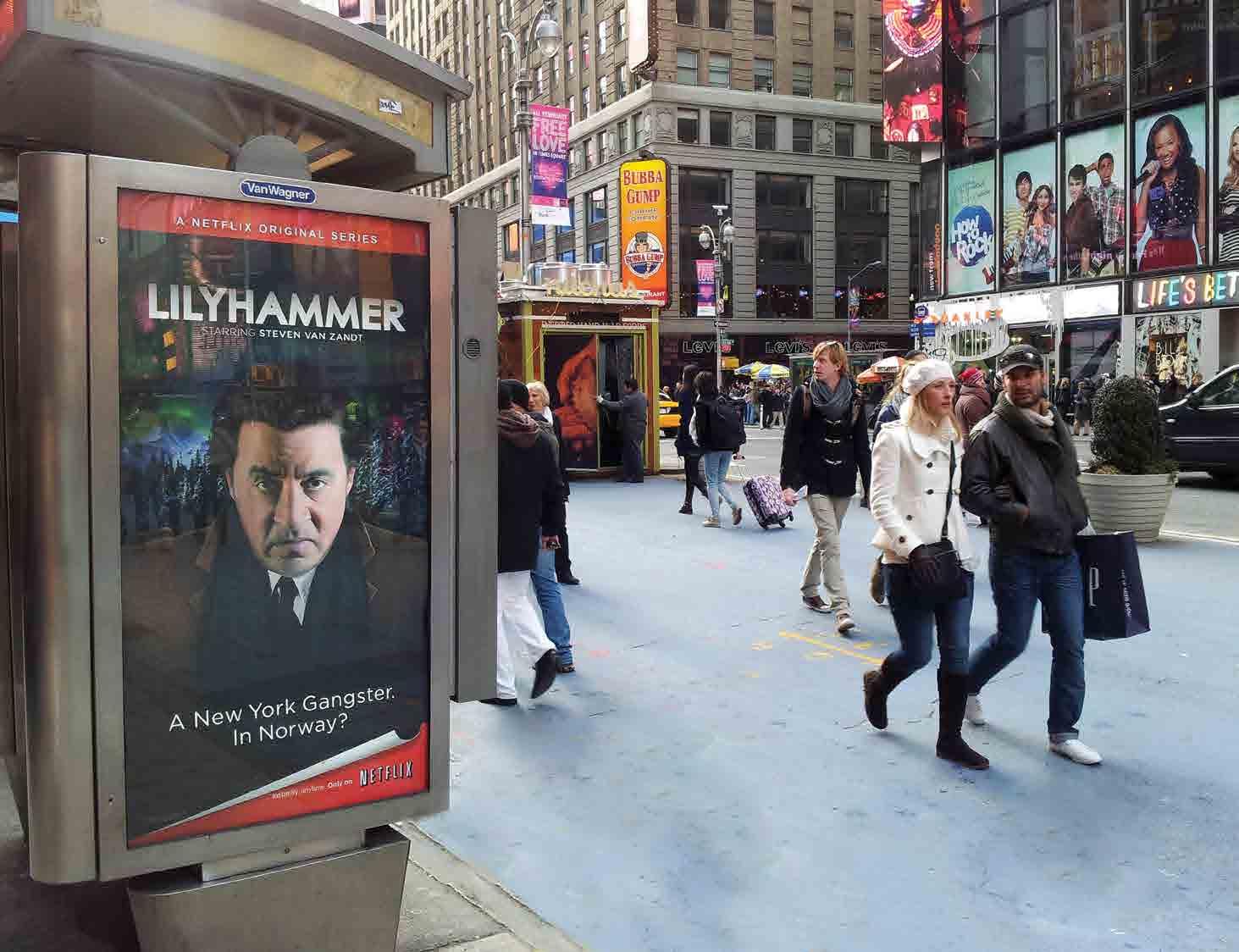
And Johnny Henriksen, who at first absorbs himself in pursuing his mercantile interests,
gradually transforms into a man who, together with Lillehammer’s residents, spares no effort to make the village a better place for himself and his fellow villagers.
SERIES
Lilyhammer poster in Times Square, New York
The event celebrating the second season’s American premier on November 19 in New York is attended by the show’s creators and actors.
©
104 VOYAGER 13/2018
Photo by Laura Cavanaugh
SKAM (SHAME)

This online series from Norwegian broadcaster NRK shows the everyday lives of different teenagers. Each season follows one particular character in real time. In other words, it airs as it happens. The series heavily relies on social media sites, with the characters running their own Instagram accounts, texting, and Skyping. Eva, Noora, Isak, and Sana are teenagers whose popularity instantaneously transcended Norway’s borders. A special website, visitoslo.com, features the characters’ routes and locations and provides some insightful information about them.
VALKYRIEN
Season 1 (2017)
One of the reviewers claims that a TV drama that has a doctor and a cop as its central characters is not giving itself much chance for originality. However, it seems that the medic and the investigator are reckless and paranoid enough to end up running a secret hospital in an old bomb shelter to treat those whose treatment the state won’t fund, or those who cannot seek treatment because of problems with the system.

NOBEL
Season 1 (2016)
This series, originally created by NRK and subsequently obtained by Netflix, describes Norway’s military involvement in Afghanistan by telling the story of a Norwegian service member who finds himself drawn into international political games. What is the price of peace? Answers to these questions are sought in this series filmed in Oslo, Prague, and Morocco.
OCCUPIED
Season 1 (2015)
The plot takes place in the near future and focuses on political and environmental issues especially relevant to Scandinavia. In this ten-episode drama, problems start when the government, under the pretense of environmental concerns, decides to stop the extraction of oil and natural gas in the North Sea. A crisis ensues. Russia becomes involved and invades Norway to take total control of its oil deposits. Needless to say, Russia was not happy about its image as depicted in the series, which had a lot in common with reality. Some have panned it as a film “in the worst traditions of the Cold War.” On the other hand, the series may seem overly realistic. The series is based on the book by Jo Nesbø, a bestselling Norwegian author and musician.
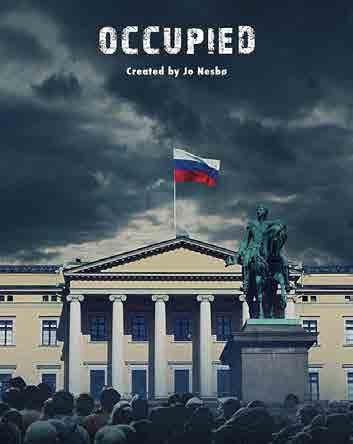

105 VOYAGER 13/2018
Norwegian actress Liv Ullmann was born in Tokyo, lived in New York and Canada, and starred in numerous plays by Ibsen, Strindberg, and Eugene O’Neal on the stage of the Oslo Theater. She was 25 when she met Ingmar Bergman, the main director in her life. Ullmann played the lead roles in Bergman’s films Persona, Cries and Whispers, Autumn Sonata, and others. As a wife, she was with him briefly, but as a muse and friend, she was always by his side.

The year 2003 saw the premier of Saraband, the last film by famous Swedish director Ingmar Bergman, starring his muse, ex-wife, and friend Liv Ullmann and Erland Josephson. The film’s opening scene depicts a meeting of a long-divorced elderly couple. “Why did you come
SO ANGRY, LIV!”
here?” the aged man asks his ex. “Because you called me,” the woman replies.
“I was in Norway, and I just had a feeling something was going on,” Liv said four years later, “so I took a private plane – I had never done that before – I went to Fårö. I went in and he was lying there in bed and I took his hand and he died that night. I don't know that he knew I was there – he was already on his way. But I said to him, ‘You called me.’ And strangely enough, that night he died.”
It is a black-and-white photo. Two are sitting on a rocky beach with the sea in the backdrop. The young woman
NOVEL
SALOME KIKALEISHVILI
* * *
“I
AM
106 VOYAGER 13/2018
must be in her mid-20s. She is dressed in a sweater and tight pants and wears a thick headband. She is looking down and seems… shy, even embarrassed. He is older than she is, twice as old. He is dressed casually, with a cap covering his head. With his legs and arms crossed, he is leaning toward the woman, looking at her closely. “I had a dream that we would be painfully connected,” he told Liv back then. “I?” Liv tells a journalist, “I just always believed him.”
Bergman first saw Norwegian Liv Ullmann, who was a 25-yearold up-and-coming theater actress at the time, in a picture next to her colleague and Bergman’s actress Bibi Andersson, both standing with a red wall in the backdrop. Behind her round face and long light hair, it was impossible to miss her big blue eyes radiating peculiar sadness and sorrow. It was
then that Bergman decided to cast Liv Ullmann in a part in his future film Persona. By that time, he had been married four times and had seven children. Between shootings, Ingmar would engage her in spiritual séances and watch her with adoration as she, in her childlike exultation, stared at plates clattering on the table. “Liv, you know it’s Ingmar,” Bibi Andersson would tell her repeatedly. “Ingmar? Really? What difference does that make?” As she later recalled in the Liv and Ingmar documentary, after every filming session, Ingmar would tell all their mutual friends, “Tell Liv that she must be with me, with me alone!”
They eventually moved to Bergman’s mansion on Fårö, spending as little as five years together, making several movies and parenting a daughter, Linn.

107 VOYAGER 13/2018
WHAT IS LIV’S BIGGEST REGRET IN LIFE? WITHOUT HESITATION, SHE WILL ANSWER, “MY BIGGEST MISTAKE IN MY LIFE WAS TURNING DOWN BERGMAN’S FANNY AND ALEXANDER.”
That was a curious period in her life, very curious. She often says that those years and her meeting with Bergman turned her life around, transforming her, once a shy, modest girl into a mature woman under his guidance. Though sometimes she felt isolated, not even isolated but locked up, literally. There were only three of them: Liv, Ingmar, and Linn in that Fårö mansion with a gigantic defense wall. “I remember that horrible feeling when our daughter would cry in one end of the house, and Ingmar would ask me to go check on her. So I had a choice to make. You have no idea how happy Wednesdays made me. It was the only day I was allowed outside the house and its wall to visit with our film crew who would camp right there. Wednesday was the day when I laughed, drank, sang, and danced. On Fårö, I danced to his tune, and he was all I had, because that, too, was something he wanted.”
Her profession helped her let go of and transfer onto film all the anger and anxiety welling up inside her and choking her. That island was Ingmar’s comfort zone, but not hers. On the other hand, she, too, had her magical moments of feeling safer than ever, when they held each other, for example, or when Ingmar would walk up to her dozing off in a chair and lightly tap her on the shoulder. “I remember it all,” Liv says.
“What is your favorite Bergman film?” someone asked her. “Of course, Scenes from a Marriage,” the actress replied, “because my heroine is so much like those women who… No, they’re not neurotic; they’re just maturing and growing independent.”
The first thing she did after leaving him was visit her friends, actors and actresses, in Sweden. Bibi Andersson stood at the head of the welcoming party in the airport waiting area. Some of the group held placards with humorous captions. The old friends spent all night sprawled across the floor, drinking and chatting about love. That was one of Liv’s most precious memories linking her again back to Ingmar.

108 VOYAGER 13/2018
NOVEL TELL LIV
THAT SHE MUST BE WITH ME, WITH ME ALONE!
After their separation, they became good friends. She can hardly remember a single day in their 50 years of relations when she did not call him. Calling and exchanging letters was part of their routine. “One evening, as we were doing another film – and we had been long separated – the girls and I had a drink or two. Actually, we got pretty drunk. So suddenly I jumped to my feet and ran toward Ingmar’s room and started pounding on his door to tell him that we were through, even though he had already remarried, which I remembered very well, of course… Yes, I left Ingmar long ago, but sometimes I get this feeling that… I never really left him.” “Yes, it was you knocking on my door last night,” Ingmar cast her doubts next morning. “But I got scared and escaped through the window.”
“Aren’t you tired of talking about Ingmar?” one of the interviewers asked her. “I really don’t mind,” she replied honestly, “because sometimes you do hear new things. It helps me to continue to understand what wonderful luggage he gave me, especially now that I’m starting to look more at his writing. He believed that writing was about projecting your soul on paper. I’m finding this new Bergman
who shouldn’t be new for me, but still is. Even when I’m being interviewed about something that has nothing to do with Bergman, it always seems to come back to him. I did complain about that to him, and he said those famous words, ‘You are my Stradivarius!’”

Liv has starred in several Hollywood movies and even directed a couple based on Ingmar’s screenplays. After leaving Fårö, Liv and her daughter Linn traveled a lot. Linn ended up changing schools 13 times before they ultimately settled in Manhattan. She was 15 at the time. She would see her father only in summer when she would visit him on Fårö. Liv has often said, “My daughter and I are very close.” Linn, however, disagrees.
In 1999, when Linn Ullmann, now a famous Norwegian journalist and author, arrived in New York to promote her novel Before You Sleep, in every one of her interviews she strongly denied having any ties to the great filmmaker Bergman and actress Liv Ullmann. Still, in one of the novel’s characters, Anni, whom the author calls “the sincerest hypocrite”, many critics recognized Liv Ullmann.
109 VOYAGER 13/2018
“Honestly, I feel guilty because I never had time for her. I had my life, my career, and my love,” Liv Ullmann wrote in her book Changing. In one of her interviews, Liv said, “I’m not a character actress. I can’t just put on a nose or be Richard III. I’m still using Liv and my experiences, allowing them to come out through me. Somehow. I can’t explain it. Other actors have methods. I had an interviewer years ago who seemed to like me as an actress, but he said I wasn’t an actress but just this human emotion walking around. Maybe I am, I don’t know, but that’s also what being an actor is. It’s the only place where I feel safe and good.”

What is Liv’s biggest regret in life? Without hesitation, she will answer, “My biggest mistake in my life was turning down Fanny and Alexander. Surely, it would have been the best part I could have had from him.” At first, he told her it would be a comedy. After she said no, he rewrote her part and, for almost a year while he was shooting and editing the movie, he wrote her letters calling her “Miss Ullmann.” “It was terrible. It was the first and only time we were not friends,” Liv recalls. He asked her to come and see it when it was finished, and she sat at his side crying and crying. She heard from the Stockholm Archive that in his manuscript from that time, he’d written in several places, “I’m so angry at you Liv!”

110 VOYAGER 13/2018
NOVEL
DEAREST PINGMAR [THAT’S HOW SHE USED TO ADDRESS HIM], NOT MANY PEOPLE CAN EXPERIENCE WHAT MY MEETING WITH YOU GAVE ME HERE IN LIFE. IT IS YEARS SINCE WE SAT HEREAND YOU SAID TO ME, “WE ARE PAINFULLY CONNECTED.”
“Who? Me and Woody Allen? No, we never actually dated,” Liv laughs. “He only dated me to get to Ingmar, to hear about Ingmar Bergman. We didn’t date, we just went for dinner. To him, everything Ingmar was Ingmar. I was Ingmar! It was always, ‘Ingmar, Ingmar, Ingmar.’ I said, ‘Ingmar wants to come and see me in A Doll’s House,’ and he was all, ‘Oh my god, do you think I can meet him?’ So I phoned Ingmar on his island and said, ‘Woody Allen would like to meet you, do you want me to arrange it?’ He came to see the matinee of A Doll’s House and was leaving the next day. He was staying at the Pierre Hotel and came with his wife and agreed to the meeting. So my next dinner with Woody, I said, ‘Oh, Ingmar would really like to meet you.’ So after the play, Woody waited outside the theatre and took me in his limousine to the hotel. He was so nervous he was shaking. This was his idol, really his idol. Woody was probably Ingmar’s idol too, but Ingmar would never say that out loud,” Liv reminisces.
They knocked on Ingmar’s door and he silently invited them in. “Bergman’s wife and I didn’t have much in common, so we spoke about food, while the men just stared at each other. At the end of the meal, Woody says, ‘Thank you Mr. Bergman,’ and we left. Outside, Woody says to me, ‘Thank you Liv, what an honor!’ When I got home, I called Ingmar, who said, ‘Thank you Liv, what an honor!’ As far as I know, they never spoke again. Geniuses are very careful around each other.”

Dheeraj Akolkar’s documentary Liv and Ingmar hits the screen in 2012. In this film, Liv is featured in their home on Fårö describing her love affair and cooperation with the Swedish filmmaker and talking about his movies. Between Liv’s interviews, photos, and scenes from Bergman’s films, we see a recurring shot of a hand touching a calendar on the wall. This calendar, which reflects their life together in 1965-1970, contains handwritten notes, question marks, hearts painted with a red marker…
“You see this place? It’s full of sunshine all day, especially in summer, so the inscriptions are gradually fading away. At least once a year, Ingmar would check the whole calendar and write over the texts in bold to keep them from fading, from disappearing.”
Today, the Bergman Estate on Fårö serves as an open residence inviting artists, actors, journalists, and directors to seek inspiration within its walls. High ceilings, woodclad walls, and enormous bookshelves define the house where we find Liv. It must be the study, I think. She is


standing there holding a small plush stuffed teddy bear in blue overalls. While filming the documentary, she finds a piece of paper squeezed carefully into the toy’s pocket.
It turns out to be a note she wrote to him years ago: “Dearest Pingmar [that’s how she used to address him], Not many people can experience what my meeting with you gave me here in life. It is 35 years since we sat here – and you said to me, ‘We are painfully connected.’ Yes… such a connection is full of grace. Thank you. Your Liv. I am so enormously… fond of you,” she reads the note and adds, “And then a little heart.”
111 VOYAGER 13/2018
* * *
A DOUBLEEDGED SWORD
DESI DASHKOVA
My first conscious encounter with Norway took place through Sigrid Undset’s Kristin Lavransdatter. Back then, it was about a young woman’s infatuation with sagas and Vestly, Ibsen, and Knut Hamsun. It felt gratifying to know that Swedes like Astrid Lindgren and Ingmar Bergman or Danes like Hans Christian Andersen historically descended from the Vikings. And the resulting peace of imaginative mind follows me to this day with child-like excitement. It also makes me happy when popular quizzes tell me that I was born in Norway, Sweden, or Denmark in a past life.
In our contemporary mass culture, a Viking is one of the most recognizable iconic images. As a rule, this image in popular literature, cinema, or videogames is a far cry from historical reality. We see a formidable bearded savage with a
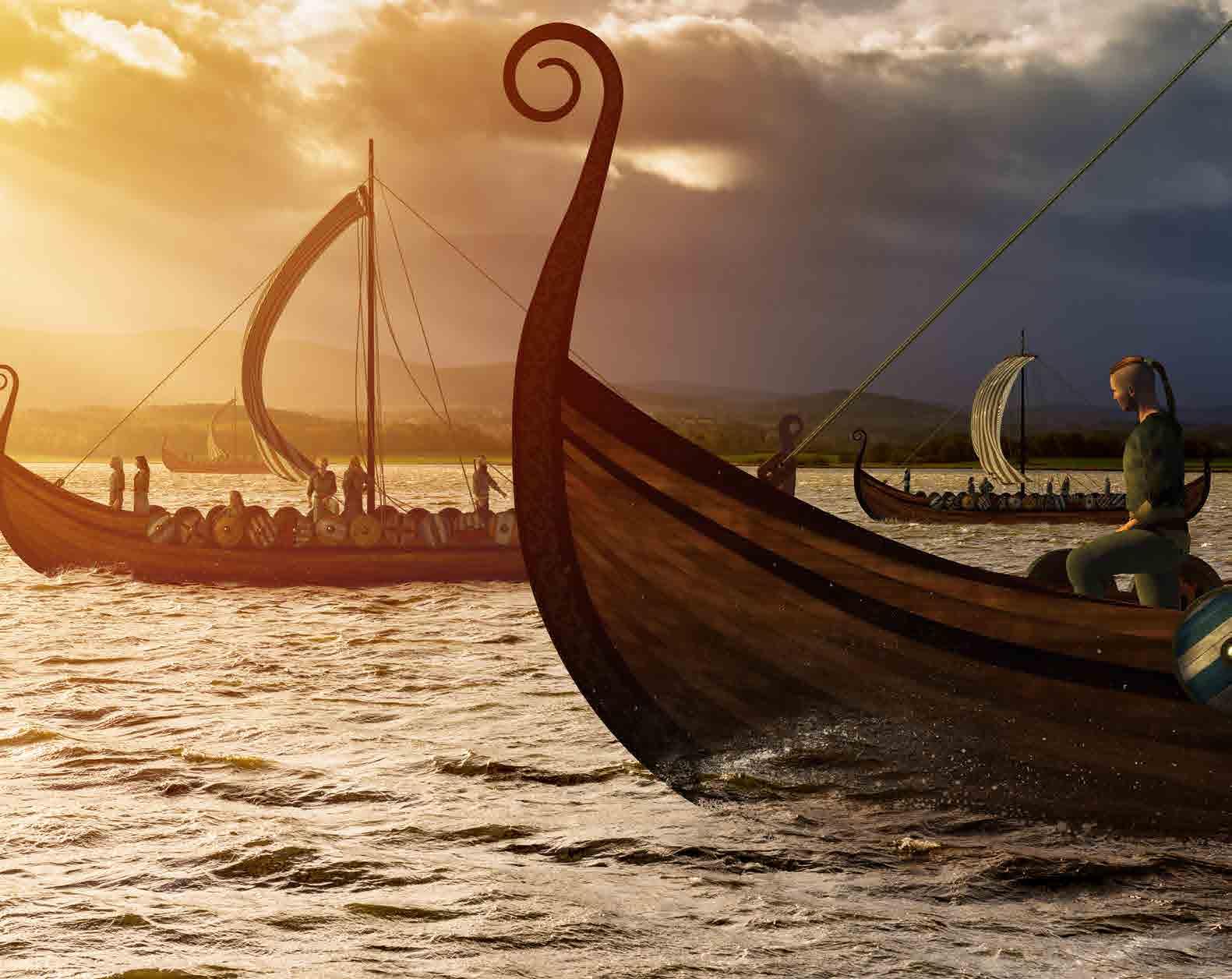
horned helmet whose only interest consists of plundering and brutal combat. However, the real context of the Viking Age is far more complex and significant. Historically, Scandinavian-Viking sagas are much more exciting than many examples of fiction. Still, who were the Vikings, and what role have they played in the forging of not only Scandinavia but all of Europe, from Albion to Old Russia?
Geographically, Scandinavia is the northernmost populated region linked to Continental Europe by only a thin chain of islands. Historically, it took centuries for the continental way of life to penetrate and take root. The population of Scandinavia consisted of farmers and fishermen. From the 8th century AD, however, their active involvement stepped up and quickly finalized the continent’s social and economic formation.
THE OLD ENGLISH WORD WIC, WHICH MEANS “A FORTIFIED PLACE”, IS FERTILE GROUND FOR ALL KINDS OF HISTORICAL AND LINGUISTIC CONJECTURES. I PERSONALLY ADVOCATE THE HYPOTHESIS THAT THIS TERM IS RELATED TO THE VERB “RETURN”, MAKING WIKJA A MAN WHO LEAVES HOME FOR A SEA RAID, WHO IS A SEA RAIDER OR A PIRATE, BOUND TO RETURN HOME.
112 VOYAGER 13/2018 VIKINGS
Three centuries is a very short period for such achievements as the completion of the emergence of European states and the development of a new centralized system known as feudalism.
Because the process of dizzyingly rapid Viking expansion in Scandinavia started after the death of Jarl Guthric, and their first raids had targeted England and France, it would be interesting how the Vikings were known in the languages of these countries.
In modern-day France, they were known as Norsemen, while in England they were called Ash People because of the ash wood used to build their boats. As for the Irish, they referred to the Vikings according to the territories they were from. The Norwegians and the Danes were known as “dark foreigners”, or the Dubgail, and the Finnish were known as the Finngail, or “fair foreigners”. In Byzantium and Russia they were referred to as Varangians and Varyags, respectively. In Muslim Spain, they were disdainfully dubbed as Madjus, that is, “pagan scarecrows”.
The Old English word wic, which means “a fortified place”, is fertile ground for all kinds of historical and linguistic conjectures. I personally advocate the hypothesis that this term is related to the verb “return”, making wikja a man who leaves home for a sea raid, such as a sea raider or a pirate, a man who is bound to return home.
For Scandinavians themselves, the term Viking has a slightly pejorative meaning. The 13th century Icelandic sagas use it to denote illintentioned, piratical predators. According to another possible version though, the term Viking is related to a Norse verb meaning crossing the sea in search of fame and glory. One way or another, the diverse talents of the Vikings never ceased to amaze Continental Europe –the plundering Vikings could instantaneously transform into merchants, colonists, ingenious farmers, or travelers.

Their advanced command of shipbuilding and navigation enabled the Vikings to attack from the sea and rapidly sail through any body of water. Sailing and the sea defined their unbeatable military strategy in which they competed fiercely. The Franks and Anglo-Saxons, weakened by internal struggles, could not retaliate at sea.
The initial scheme of Viking raids and piracy was quite simple. They would launch a surprise attack from the sea, with small groups making landfall
in various places. Before the victims knew what hit them, they plundered everything they could carry and burned everything they couldn’t, and then disappeared again into the sea. Gradually, their fleet grew larger and the scope of their raids expanded. For example, more than 600 ships of so-called Danish Vikings attacked and ravaged Hamburg. The damage was so devastating that the Hamburg Episcopal See had to be moved to Bremen.
In 866 AD, 20,000 Vikings invaded Britain via Scotland, merrily wintered there, and then established a state of their own, the Danelaw, in which they had incorporating several independent entities. It took the Anglo-Saxons 12 years to liberate themselves from Viking rule. In 880, a 40,000-strong Viking army targeted France, sacking Rouen and threatening Paris, which they had previously raided and robbed three times. Eventually, Paris paid them off, and the Vikings headed northwest, where most of them settled for good. Next, King Charles III, not to add insult to injury, ceded these territories to the Norwegian Rollo to rule what became known as Normandy (named for the Norsemen), presently France’s northwestern region and, if anything, the homeland of the famed camembert cheese.
In the 10th century AD, a large state emerged in the territory of modern-day Denmark. At the same time, a centralized government was growing stronger in Norway. A part of Norway’s population migrated to the mainland, while the Danes continued their Viking-style invasive state policy for quite some time. They were repeatedly defeated and annihilated, but they would not stop and kept organizing expeditions on end.
In the 11th century AD, William the Conqueror, a Norman descendent of Vikings, rallied 3,000 newly built ships, 30,000 troops, and 2,000 horses, crossed the English Channel, and conquered the Kingdom of England. In line with the historical norm of social development, the 300-year history of the Vikings, which started as minor raids by small groups, ended with the conquest of an entire state.
To summarize, a brief period from the 9th through 11th centuries marked the dominance of the Scandinavians in the architecture of European history. The first stage of the Viking Age until the mid-9th century was characterized by the rapid expansion of raids, the growing geographic scope of targeted areas, and significant improvements in shipbuilding. The stage of colonization started in the late 9th century when the Vikings conquered, split,
113 VOYAGER 13/2018
ACCORDING TO ONE OF THE POSSIBLE VERSIONS, THE TERM VIKING IS RELATED TO A NORSE VERB MEANING “CROSSING THE SEA IN SEARCH OF FAME AND GLORY.”
SUCH DOUBLEEDGED SWORDS HAVE BEEN FOUND IN ABUNDANCE DURING ARCHEOLOGICAL DIGS IN NORWAY. IT IS SCIENTIFICALLY PLAUSIBLE THAT THIS METHOD OF WELDING WAS INITIALLY INVENTED IN SCANDINAVIA.



continued conquering, established, and then split again. The final third stage, which marked Scandinavian expansion and centralization, lasted from the late 10th century to the end of the 11th century. The campaigns of this period drastically differ from what we saw before. Danish Kings conquered England and practically took over Northwestern Europe. Later, Norway laid claims to Sweden, triggering the formation of the Sweden-Norway union.
The Viking Era is suffused with romanticism and adventures. They passed through every strait and channel wide enough for their ships and left their mark everywhere. It is common knowledge that the Vikings are credited with the establishment of a few larger Irish cities. Through their exploits, they introduced a myriad of Scandinavian loan words into the English language and gave their name to numerous places in Normandy and Normandy itself. The Vikings were the first explorers to discover and settle in Iceland. Many books, films, museums, and exhibitions are dedicated to the Viking Era. Viking symbols are often used in the souvenir and advertising industries – the Vikings are Scandinavia’s trademark brand of sorts.
As I was writing this essay, my mind kept wandering more or less extensively – like Thor Heyerdahl sailing all over the globe on his Kon-Tiki raft – and here is what it discovered. In Georgian literature, the word French is often used as a synonym of sword: “Aluda Ketelauri tries the cutting edge of his French.”
This term gained a foothold thanks to the special razor-sharp edge of this type of sword using a special French method of welding. European culture offers information about Ulfberth, a French clan of blade smiths whose double-edged Carolingian-era Viking swords were highly valued at the time. Such double-edged swords have been found in abundance during archeological digs in Norway. It is scientifically plausible that this method of welding was initially invented in Scandinavia. My point is that I really, really wanted to establish some links between Georgia and Scandinavia.
The Viking Age is a dizzying yet brutal reality, which ultimately advanced the world’s historical development to a new level.

114 VOYAGER 13/2018
VIKINGS
©
© www.fjordnorway.com
Photo by Spot Studio, Spot Studio
The green-covered Vestvågøya Island is part of the Lofoten Archipelago. You can get there by bus, ship, or car. It features one magical place, a place where the Vikings have been waiting a thousand years to meet you.
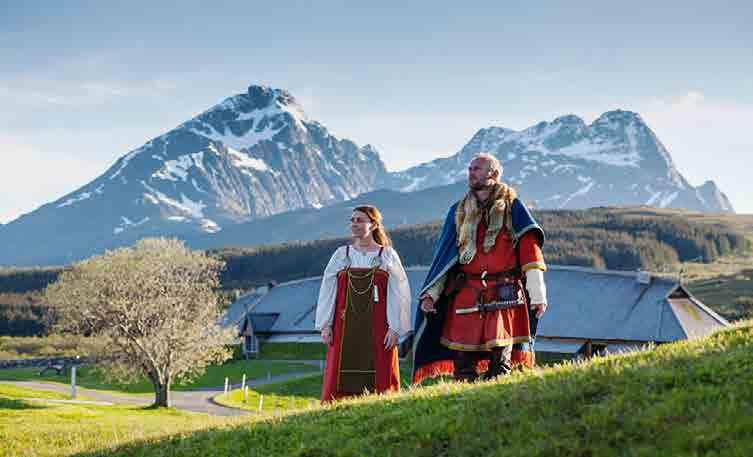
This excavation site, which is packed with archeological exhibits, reenacts the life and environment of the Vikings and displays imported glass, gold, and ceramics, that is, artifacts suggesting that a rich Viking clan may have lived here long ago. It is the house of a Viking chieftain where you can see all there is to see, including a reception area, permanent exhibitions, a museum shop, and a café. If you end up sightseeing after sunset, you can always find a place to stay overnight on the island.
Lofotr Viking Museum is a member of Museum Nord, the union in charge of the museums on the Lofoten Islands.
Prestegårdsveien 59 / www.lofotr.no
FRAMMUSEET
Fram is the sturdiest wooden ship ever built and a long-standing record-breaker when it comes to traveling the Arctic and Antarctic. This ship symbolizes discoveries and exploration and the Norwegians’ contribution to exploring the earth in general.
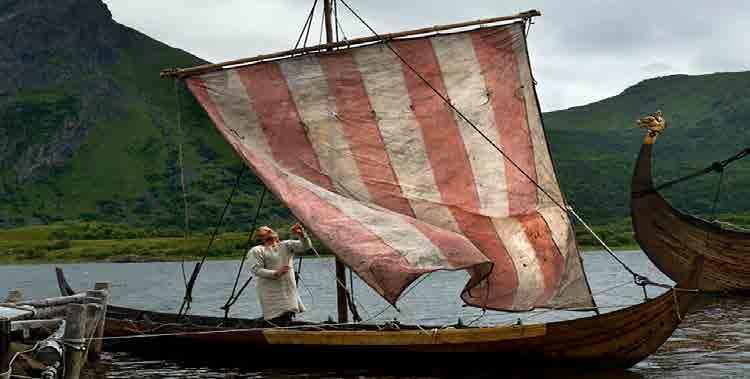
Fridtjof Nansen, Otto Sverdrup, and Roald Amundsen took turns exploring the Arctic and Antarctic aboard this ship. After the completion of their expeditions, and as a result of many years of hard work, the Fram Museum was built to open its door to the public in 1936.
Today, you are welcome to board the ship to find out how its crew and their dogs survived in the coldest and most dangerous places in the world.
VIKINGSKIPSHUSET
Found on Oslo’s Museum Island, the Viking Ship Museum displays some of the best-preserved Viking vessels in the world, including the Gokstad, Oseberg, and Tune Ships. It also hosts historical artifacts and wooden exhibits from the Viking Age. Each ship tells its own story of some of the most far-reaching Viking journeys, while the artifacts introduce us to the everyday life and environment of the Vikings in ages past. The museum shop invites us to travel in time through its exciting books, souvenirs, and gifts. At different times during the day, the museum screens Vikings Alive, an adventure movie.
Huk Aveny 35 / www.khm.uio.no
The Fram Museum also has a polar simulator where you can experience the cold and the dangers of polar expeditions more than 100 years ago. The main building is connected to the Gjøa facility through an underground tunnel. Here you can visit Gjøa, the first ship to sail through the Northwest Passage, a sea route through the Arctic Ocean, along the northern coast of North America.

To cut it short, the museum has everything about great discoveries, equally great journeys and information about them, and the miracle of exploration – everything that keeps us standing in awe of the earth.
Bygdøynesveien 39 0286, Oslo www.frammuseum.no
115 VOYAGER 13/2018
LOFOTR VIKING MUSEUM
© Lofotr Vikingmuseum foto Ruben Schipper
© Lofotr Vikingmuseum-Foto-Kjell Ove Storvikper
THE UNBEARABLE NORWEGIANNESS OF JAZZ


 KAKHA TOLORDAVA
KAKHA TOLORDAVA
It is clear as day that, until the 1960s, very little was known in the rest of the world about Norwegian music in general, probably with the exception of those few involved in the realm of academic music. As for popular music and culture, its representatives, and especially the growing numbers of young listeners throughout the world, weren’t very likely to even know anything about Edvard Grieg, for example. Those youth had music idols of their own and their powerful acoustic accompaniment to the messed-up and constantly changing reality left no room for caring about Norwegian musicians or Norwegian music.
On the other hand, Norway, as part of Europe, never was in acoustic isolation, and its musical culture developed steadily and quite interestingly. Jazz, for example, was first introduced to this country in 1919. And for decades thereafter, Norwegian jazz musicians consistently and diligently imbibed this new, unknown language of musical idioms. The effort was worth it. In the late 1950s and early 1960s, local musicians perfected their command of different instruments, which is why some American jazz players consciously hired Norwegian instrumentalists. The cooperation between George Russell and Jan Garbarek is a good, albeit rare, example. Still, Norwegian musicians had a long way to cover in their development to turn the term Norwegian Jazz into another catchy
slogan attracting tourists. To this end, however, they were aided by the local musical forms, Norway’s severe climate and landscapes, and the openness of Norwegian musicians themselves.
116 VOYAGER 13/2018
MUSIC
As a term, Norwegian Jazz continues to grate on many jazz experts and connoisseurs who often find it preposterous, and they have a point. After all, what can Norway possibly have in common with musical forms imported from Africa to America where they were subsequently doctored up by Creole Blacks to their liking? Or with syncopation, blues, swing, Charlie Parker, Thelonious Monk, and Dizzy Gillespie? All in all, what possible links can there be between this rich and flexible musical form—the leitmotif and chronicler of the modern history of the United States, which can be defined as something inherent only to this country—and Norwegian mentality? Providing eloquent and articulated answers to these and similar questions is no easy task. On the other hand, one reasonable answer is already present in the questions themselves.
Jazz has this amazing ability to embrace musical ideas and forms originating in different countries. Whether or not it remains a uniquely Afro-American musical form is a different question. Numerous books and works are dedicated to this dilemma. Nowadays, however, the gap between theory and practice – which favors the opinion that it does remain an Afro-American musical form – is so deep that billions of jazz fans do not even bother with theoretical arguments. To them, what matters is music, and nothing can stand in its way as long as it is powerful and deep enough. This is why people are not embarrassed by terms like Ethiopian jazz, Indian jazz, Polish jazz, Norwegian jazz…

In every country listed above, musical forms stemming from jazz have their own history. In Norway, the Norwegization of jazz, the taming of jazz Norwegian-style, certainly was not planned in advance. It happened naturally, thanks to those Norwegian musicians who felt overly limited by the Afro-American state of jazz. They perceived this music from a vast territory of interests and opportunities and, more
importantly, their own territory. The musical reality of this territory and their different vision of it compelled them to try things outside the purview of the laws of jazz. They realized that liberation from the hegemony of Afro-American jazz would first of all benefit music itself, not because there was anything wrong with the Afro-American version of jazz, but because distancing oneself from it would offer prospective ways to discovering new sounds, a new vision, and a new acoustic reality.
This new sound and reality turned out to be so valuable that some, after listening to an album or performance by one Norwegian jazz musician or another, started to talk about “the smell of a breeze from the North Sea.” However surprising it may sound to those uninitiated into Norwegian jazz, this music is distinctly “visual”, and the phrase “the smell of a breeze from the North Sea” carries a lot of weight among those versed in Norwegian jazz.
English musicologist Daniel M. Grimley, in his book Grieg: Music, Landscape and Norwegian Identity, describes this characteristic of the music by the most famous Norwegian composer: “In Grieg’s music, landscape is not merely concerned with pictorial evocation, but is a more broadly environmental discourse, a representation of the sense of being within a particular time and space. Grieg’s musical landscapes are also associated with feelings of nostalgia, nihilism, and enchantment.” This quote by Grimley so perfectly describes the most famous representatives of Norwegian jazz, such as Jan Garbarek, Terje Rypdal, Arve Henriksen, Nils Petter Molvær, or Tord Gustavsen, that even

117 VOYAGER 13/2018
novices armed with this quote alone will find it easy to appreciate their music adequately. That, of course, does not mean that these musicians blindly rely on Grieg or any other Norwegian classical composer.
It means that these musicians, similar to Grieg, did their homework scrutinizing the roots of Norwegian music in general, its oddly quiet and brittle folk forms, and matched this music with the Afro-American forms of jazz. To this process of merging, jazz responded in its typical manner by going Norwegian.
Saturated with chiaroscuro effects and silence, Norwegian jazz gained a massive following and hence turned into



a good marketable product. To cap it all off, it was lucky enough to hook up with German ECM, arguably the most solid record label in the world. The meeting between the label’s founder Manfred Eicher and Norwegian saxophone player Jan Garbarek in Bologna in the late 1960s may be considered the informal starting point of the rise of Norwegian jazz. The motto of Eicher’s label, The Most Beautiful Sound Next to Silence, is directly tied to the notion of silence. He must have been enchanted by the Norwegian ability to use silence in music, in which the Norwegian environment is reflected literally, almost tangibly, and not just figuratively.
When Norwegian jazz musicians perform, coldness sometimes blows from the stage, but this coldness somehow feels warm, not chilly, because one can discern in it that territory, that firm ground, on which these musicians decided to build on after delving into their own music with the help of jazz. All this can be compared to a warmly dressed man contemplating fjords or traversing snowcovered forests alone. This kind of musical state keeps the listener and music at a distance which, in turn, gives rise to a meditative state and invites the listener to dig deeper into their innermost being.
Silence and music full of meaningful pauses is not an exclusively Norwegian, or Scandinavian, phenomenon or property. But the notion of silence in Norwegian music, notably jazz, is perceived absolutely differently from the meaning prevalent in Europe in general or in the United States. And although Norwegian musicians were undoubtedly familiar with and, most likely, even used ways of exploring acoustic space by alternating sounds
118 VOYAGER 13/2018
MUSIC
and pauses – something characteristic of John Cage, Gerry Mulligan, Ahmad Jamal, Miles Davis, Keith Jarrett, and others – a combination of the music of their own territory and these ideas enriched their music with unique overtones, simplicity of thought, and emotional intensity.
Norwegian jazz musicians do not prioritize making an impression. They seek to achieve maximal expressiveness using as few sounds as possible. And when they do, their music is absolutely unique, extremely poetic, almost exotic, stemming from multiple roots and yet universal.
The world has duly appreciated the efforts of Norwegian jazz musicians and Norwegian music in general, mainly because this music is about Norwegian identity and a Norwegian vision. It’s a viewpoint enabling one to contemplate their own reality and space, and this is why today the world raves about the Norwegian scene, not just Norwegian jazz. Other musical idioms emerging in the bosom of this scene are rich in diverse ideas. Consequently, one may listen to Norwegian music and learn more about Norwegians than from the must-see attractions offered by the tourism industry. And that is pretty good for a country of only five million.
INTRODUCTION TO NORWEGIAN JAZZ
FOR STARTERS:
Afric Pepperbird – Jan Garbarek Quartet
Khmer – Nils Petter Molvaer
Fairytales – Radka Toneff Steve Dobrogosz
Masqualero – Masqualero
Some Other Spring – Karin Krog & Dexter
Gordon
Plastic Sun – Svein Finnerud Trio
Witchi-Tai-To Jan Garbarek
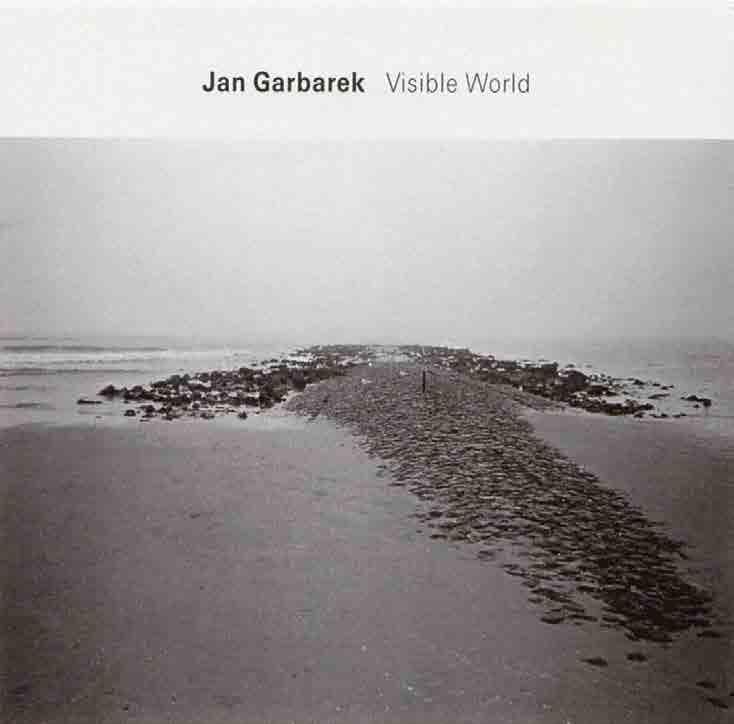
Bobo Stenson Quartet
Winter Poem – Radka Toneff
Chaser – Terje Rypdal
Duplex Ride – Sidsel Endresen, Bugge
Wesseltoft
Arve Henriksen – Cartography
Eivind Aarset – Light Extracts

119 VOYAGER 13/2018
WAYWARD TEENAGERS’ OPERA
Time and history prove that black metal was born in Norway. This new chapter in music was written by a bunch of wayward teenagers coming of age. In 1984, Jørn Stubberud, 15 years of age at the time, and his friends, inspired by Black Metal, an album by English band Venom, put together a band of their own, called it Mayhem, and picked stage names: Jørn became Necrobutcher (one who butchers dead bodies), and Øystein Aarseth turned into Euronymous, the ancient Greek prince of rotting corpses.
The boys took great pleasure in exploring darkness, fear, and mysticism. Still, Jørn realized that his music was, for the most part, created under acoustic influences, and the blame for the label coined for this genre in the early 1990s should have been shared equally by wayward adolescents, the media, the state, and the church. And generally, historically, something
is always bound to explode the wrong way when it seems quieter than ever.
After a series of rehearsals, Mayhem taped their songs on 100 cassettes, labeled the demo as Pure Fucking Armageddon, and disseminated it among Oslo’s underground community. In 1986, the band recruited vocalist Maniac and performed onstage for the first time, followed by the release of their first album, Deathcrush (1,000 copies). Though very primitive and unpolished, the album was full of individualism and expressiveness. Next, Mayhem replaced both the drummer and the vocalist, and continued its journey together with Swede Per “Pelle” Yngve Ohlin, known under his stage name Dead.
Pelle abstained from food. He wanted to look like a skeleton. He had animal corpses scattered all over his bedroom to be
 MIKHEIL TSIKHELASHVILI
MIKHEIL TSIKHELASHVILI
MUSIC
120 VOYAGER 13/2018
MAYHEM, CLASSIC LINEUP
able to smell death, always. A few hours before performing, the boy would bury his clothes in the ground to smell like dirt and decay. Right before going onstage, he would inhale the air remaining in the lungs of dead animals. When performing, he would wear makeup that made him look like a dead man. It was not the comical KISS makeup or King Diamond’s evil makeup. Pelle only wanted to look dead. Later, his style became both iconic and mandatory for the genre’s musicians.
Pelle brought more darkness and death into Mayhem’s lyrics, making the band’s music far more impressive and cryptic. Pelle was the first to link black metal to the cult of death from the very outset. Pelle was adored and appreciated. He was held in high esteem for his sense of humor, ideas, and character. Under his and Jørn’s leadership, Mayhem matured into a solid force. Rumors were circulating in Oslo about “some youth” full of blood and darkness holding concerts with audiences sometimes leaving in the middle of the performance, puking.
These four are Mayhem’s classic lineup that held the band’s first solo concert and toured Europe. Alas, this adventure was short-lived. Would it surprise you to hear that Pelle committed suicide? Well, he did, in April 1991, at the age of 22. With his wrists slit, he left a suicide note apologizing for the bloody mess in the room, and then shot himself in the forehead with a shotgun. The band’s guitarist Euronymous discovered Pelle’s body, but before calling the police, he took pictures of his dead bandmate. Jørn was devastated by Pelle’s death, and Euronymous’s behavior did not much help alleviate the grief, so Jørn instructed him against developing the photos. Eventually, Jørn left the band.
As for Euronymous, he seemed unaffected by the death of Pelle. He assumed Mayhem’s leadership, opened a record shop named Hell, and then started the record label Deathlike Silence. Soon, the band replenished its ranks by recruiting Hungarian vocalist Attila and bassist Varg Vikernes from Bergen. That marked a turning point in the history of black metal which would never be the same.
In January 1993, Finn Bjørn Tønder, an editor for Bergens Tidende newspaper, noticed an article by interns, in which they interviewed 19 year-old Varg Vikernes, the founder of a one-man band called Burzum. The final section of the article mentioned a tragic incident a few weeks previous, when the 12th century Åsane Church caught fire on Christmas Eve. 18 hours later, another fire consumed another church. There were victims. A youth gang called “the Satanists” claimed responsibility for the incidents. Other groups followed suit and started burning churches across Europe.
In the interview, Vikernes claimed to have burnt the churches and killed a man. The editor visited him at his home and convinced him to quit beating around the bush and come
forward, which would “promote his band tremendously.” Vikernes took the bait.
The next day, a few hours before the interview’s publication, nine police officers visited his small apartment. In the evening, he was all over the news on TV, radio, and print outlets. The media jokingly referred to him as Count Grishnackh. Norway would soon experience firsthand the bitter outcomes of this joke. The Count emerged as a popular character with an army of followers.
“Norway is full of Christian morality, and we abide by these rules, and that’s our tragedy,” Vikernes claims. “The ground where they built the Åsane Church used to be a Viking burial mound. I didn’t commit a crime; I just restored justice.”
Many shared his sentiments. Soon after his arrest, five more churches were burned down in the country. The puzzled media kept pointing the finger at Vikernes’s one-man black metal project, accusing in reality the new experimental genre of music leading youth obsessed with neo-Nazi ideology. These were young men and women, infantile at first glance, who delved into pseudo-Viking morality and found refuge in black metal. This was their comfort zone because they could remain anonymous. Moreover, band names transforming into ambiguous logos was subconsciously tied to their desire to hold back their real “selves.” Thus, in mere six months, black metal was labeled as Satanism and Nazism, a bad reputation that remains hard to shake off even today, 25 years later.
Around that time, other black metal bands emerged under the influence of Mayhem both in Norway and abroad, though most of them copied Vikernes’s attitude toward music, and Vikernes believed that one should not think about music when creating music; instead, one should express their position. This attitude was adopted by hundreds and thousands of musicians. Many had no idea how to play, but all they wanted was a piece of this Satanist media circus. As a result, ineptness and Nazism took over the genre which, just a couple of years earlier, seemed so fresh and full of inexplicable acoustic innovations. Black metal turned into the main weapon against Christianity in Scandinavia at first and then elsewhere, while none of the three pioneers of the genre ever prioritized fighting against religion.
In that period, Vikernes, who had been released due to lack of evidence, was back in Mayhem together with Euronymous. By summer 1993, they recorded their first full studio album, De Mysteriis Dom Sathanas, but before the product actually rolled out, in August 1993, Euronymous and Vikernes parted ways. Vikernes walked out on the band from the recording studio, for which he received a death threat from Euronymous.
121 VOYAGER 13/2018
Vikernes, however, beat the prince of rotting corpses to the punch by butchering him in his apartment hall early in the morning, August 10. The news made the headlines that day. The very existence of black metal was now anathematized as a national tragedy. Vikernes, 20 years of age at the time, was sentenced to 21 years in prison, a maximum penalty.
Mayhem had been orphaned, as none of the founders were around. At Euronymous’ funeral, Jørn offered the band’s drummer to start looking for a new guitarist and revive Mayhem only after finding the right candidate. The search took them a whole year. In the meantime, two of their earlier recordings were released: De Mysteriis Dom Sathanas in 1994, which is praised to this day as one of the iconic records in the genre, and 300 LP copies of Dawn of the Black Hearts in 1995, the band’s 1990 live performance. The cover of the latter is “adorned” with a photo of dead Pelle taken by Euronymous, no less.
Eventually, the old members of Mayhem recruited 19-yearold guitarist Rune Eriksen and revived the band to release the 25-minute-long Wolf’s Lair Abyss in 1997 and then, in 2000, their second studio album titled Grand Declaration of War. With the end of the millennium in 2000, black metal died in Norway, or its initial wave, to be precise. The release of
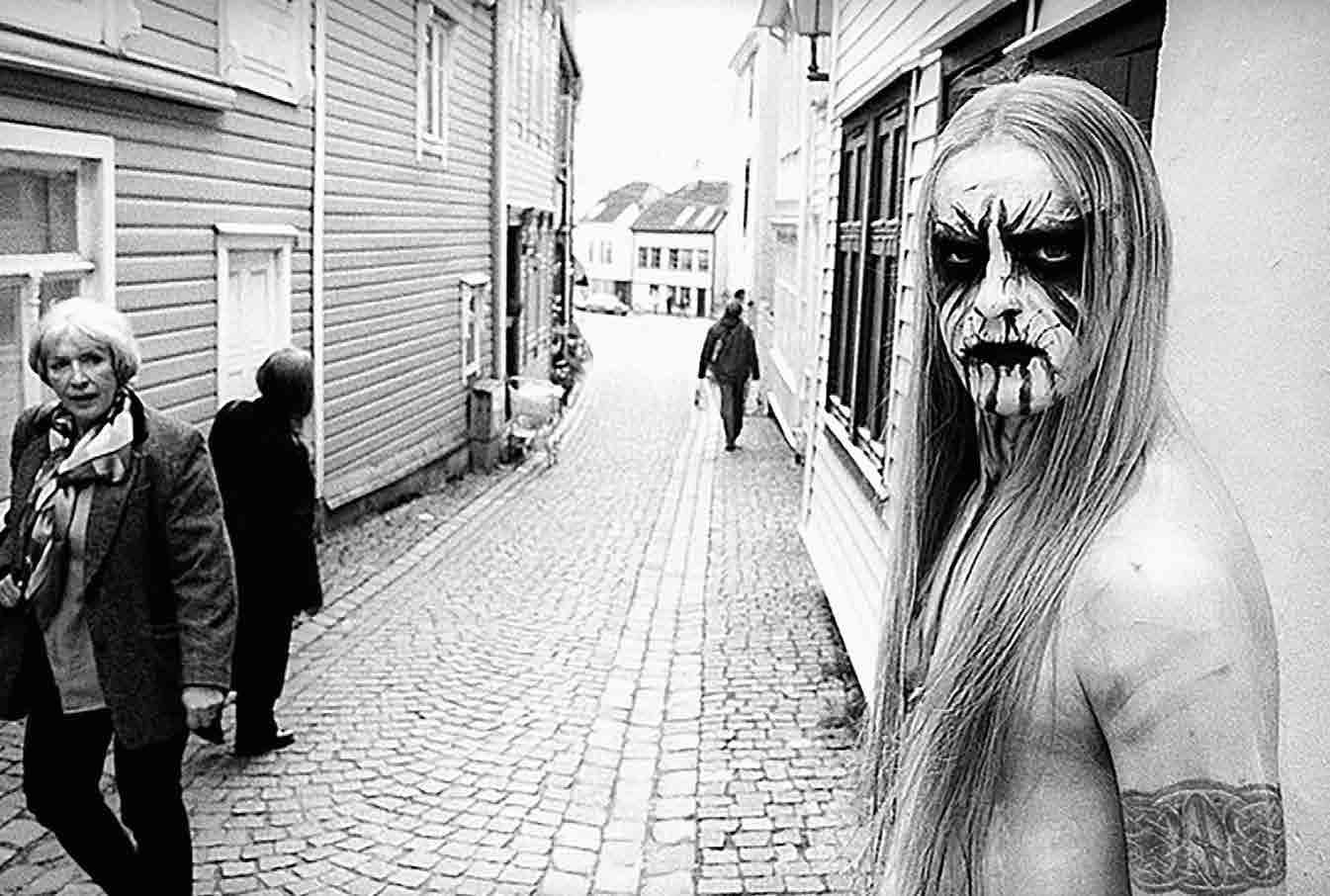
Mayhem’s 2000 album marked the beginning of a new type of music known as black metal which, contrary to expectations, went crazy global. The album’s sound and compositional structure defined the best examples of this genre. Mayhem’s music kept its aggressiveness, though to a lesser degree. While in the past their music was unrefined behind the ideological veil, now the situation changed to turn black metal into the last genre in the struggle to enrich the lexis of metal. Because of this compositional architecture, many listeners turned their backs on Mayhem, but it is also true that this album was a logical continuation of the search that started on one historic day in 1983, when 15-year-old Jørn Stubberud listened to Venom’s Black Metal and decided to form a band.
In the meantime, Vikernes kept lampooning from prison, complaining that people were into music proper, not the idea behind it. Finally, in 2009, he was paroled after 16 years of imprisonment. As his parole was announced, he stated that he had been reformed and severed all ties with far-right groups. The irony in his words and his true colors, however, became evident very soon. In 2011, terrorist Anders Breivik praised him as his ideologist and fellow fighter. Vikernes, who presently lives with his wife and children, is actively engaged in Nazi propaganda and, according to many, is unjustifiably hailed as one of the greatest figures in the history of black metal.
MUSIC
EINAR SELVIK, AKA KVITRAFN, IN THE STREET.
122 VOYAGER 13/2018
PHOTO BY PETER BESTE
Black metal is still relevant. In the 21st century, this genre developed into a social phenomenon far away from Norway, in places like Guatemala and Japan. Local black metal scenes operate in almost every country, developing in the two directions once established by Jørn Stubberud and Varg Vikernes: to some, black metal is therapy and a means to explore and expand one’s musical vocabulary, and to others it is a Nazi haven. In socially underdeveloped countries, black metal is viewed as a way to fight against religious dictatorship and the oppressive state system, with music being a secondary component and lyrics and aggressive sound as dominants. On the other hand, hundreds of musicians in America and Europe prioritize music and maximally polished acoustic sound flows.
One way or another, it was Mayhem that paved the way for them all. Besides his hatred of religion, Jørn Stubberud has almost no ties to the ideas he upheld 30 years ago. Still, he continues holding concerts, and hundreds of thousands of fans worship him as a mythological figure. One time, during his concerts in El Salvador, journalists asked his fans to describe how they perceived Jørn Stubberud’s home. In reply, they said that it had to be a cave-like home, with dripping candles covering the walls, and darkness and the smell of blood all around. In reality, Jørn Stubberud lives in a Norwegian village, in a wooden home, with magnets covering his refrigerator and flowers in the yard. He can’t wait for tours to be over, so that he can go back home to see his grandchild.
In the 1980s, Mayhem’s members compared their music to opera, saying that listening to black metal requires just as much preparation as opera, and there is some truth to it. Their music is grim and disquieting, one that sends shivers down your spine. This music has seen trials and tribulations in the history and mentality of a nation believed to be one
of the happiest in the world. There is more death in opera and black metal than anywhere else.

This music is a response from a generation living a comfortable life of ease, who had no life experience, and who, one sunny day, got fed up with this comfort and tranquility. Today, the story of this bloody and noisy music is part of Norway’s cultural heritage, another gift to the world
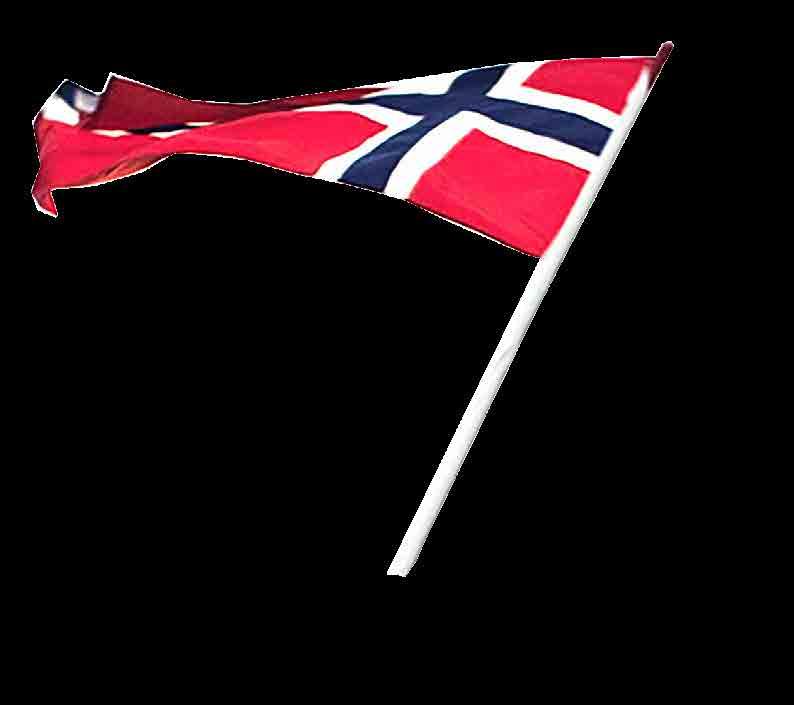
123 VOYAGER 13/2018
DAGNY JUEL
Tiflis
May 23, 1901

Wednesday afternoon
The sun is shining. It is hot.
Rafts, after being set afloat from the raft station, are carried away by the river and grouped together under the simple span bridge near the Madatov Island. The rhythmic pounding of the watermills on the opposite bank can be heard.
Near the lower section of Alexander Garden, the konka horsedriven tram turns onto a narrow street and proceeds over Mikheil’s Bridge toward Vorontsov Square. Although vacant seats can be easily seen in the open car, a uniformed man opts to stand on the back steps, holding the iron rail. Hotels are lined up on either side of the street. To the right, at #21 there is the famous London Hotel, or Hôtel de Londres, run by one Frau Katharina Richter, a German widow. As usual, all 28 rooms are booked, the personnel are fluent in three languages, and the sounds of piano music are heard coming from the big dining room.
STORY
Madonna, 1894 by Edvard Munch
124 VOYAGER 13/2018
VERA ZARKOVSKA
The Mirzoev House on the left side of the street houses the Grand Hotel, which used to be a high-end hotel a few years ago, not has moved into furnished apartments. The fivestory building’s narrow north façade looks at the Madatov Island. This part of the building actually springs up from the water. The balconies on the upper floors offer clear views of the island and the whole left bank. A young woman with her 5-year-old son checked into Room 4 at the Grand Hotel 11 days earlier. Now she is taking a nap after dinner. Her young male companion exits Room 5 next door, enters her room without knocking, leads the child by the hand into the hall, kisses him, and leaves him with his acquaintance in his room. Next, he returns to the woman’s room and locks the door from the inside. He does not rush and seems to have planned everything in advance. He does not look anxious or hesitant. He puts several sealed envelopes on the table and turns toward the woman, aims a loaded pistol at her neck at point-blank range, and kills her with one shot.
On May 27, Iveria newspaper published a brief report: “Vl. Aug. Emeryk, resident of Warsaw Governorate and son of famous coalmine-owner, and Dagny Przybyszewska, wife of Polish writer, found dead on May 23 at Grand Hotel.”
The Russian-language newspaper Кавказъ (Caucasus) issue two days earlier was more detailed in describing the May 23 tragedy at Grand Hotel. Long ago, Władysław August Emeryk, a petty nobleman from the Warsaw Governorate, checked into the hotel. A month ago, he left for Warsaw, and returned together a certain lady and her son, five years of age, two weeks ago. The lady, whom Emeryk introduced as his sister and settled in the room next to his, turned out
to be Dagny Przybyszewska, a writer’s wife born in Norway. On that fateful day, two back-to-back shots were fired in the woman’s room. The police broke through the door and found Dagny Przybyszewska, the victim of this murder, lying in her bed in a pool of blood. She was dressed. Next to the bed, Emeryk lay on the rug showing no signs of life. In the note found nearby, Emeryk admitted to having murdered Dagny Przybyszewska, the wife of a famous writer, and then to killing himself, also asking not to look for reasons and not to accuse anyone. He also requested to keep intact his letters to the victim’s husband and others, and to send them to the addressees instead. Both bodies were transported to the anatomical theater at Mikheil’s Hospital, Кавказъ (Caucasus) newspaper reported.
Emeryk’s final wish was not fulfilled, and his letters were never mailed. Still, contrary to expectations, the letters provided no answers, with the exception of a more or less informative letter to one Melchavsky, Emeryk’s Tbilisi-based friend.
Apparently, it was Melchavsky in whose care Emeryk left the child minutes before the murder. In the letter, he asks Melchavsky to look after the boy and contact his father in Poland. Emeryk’s other letter was addressed to Dagny’s underage son, a letter he was requested to open when he turned 24. “Dear Zenon, I am taking your mother away from you, and I do not know what the future has in store for you, what you will grow up to be, and what your attitude toward her will be. You probably should not trust the strange views on your mother which you will find in available literature. Your mother was not of this world. She was a saint full of queenly empathy, and you meant everything to her. The
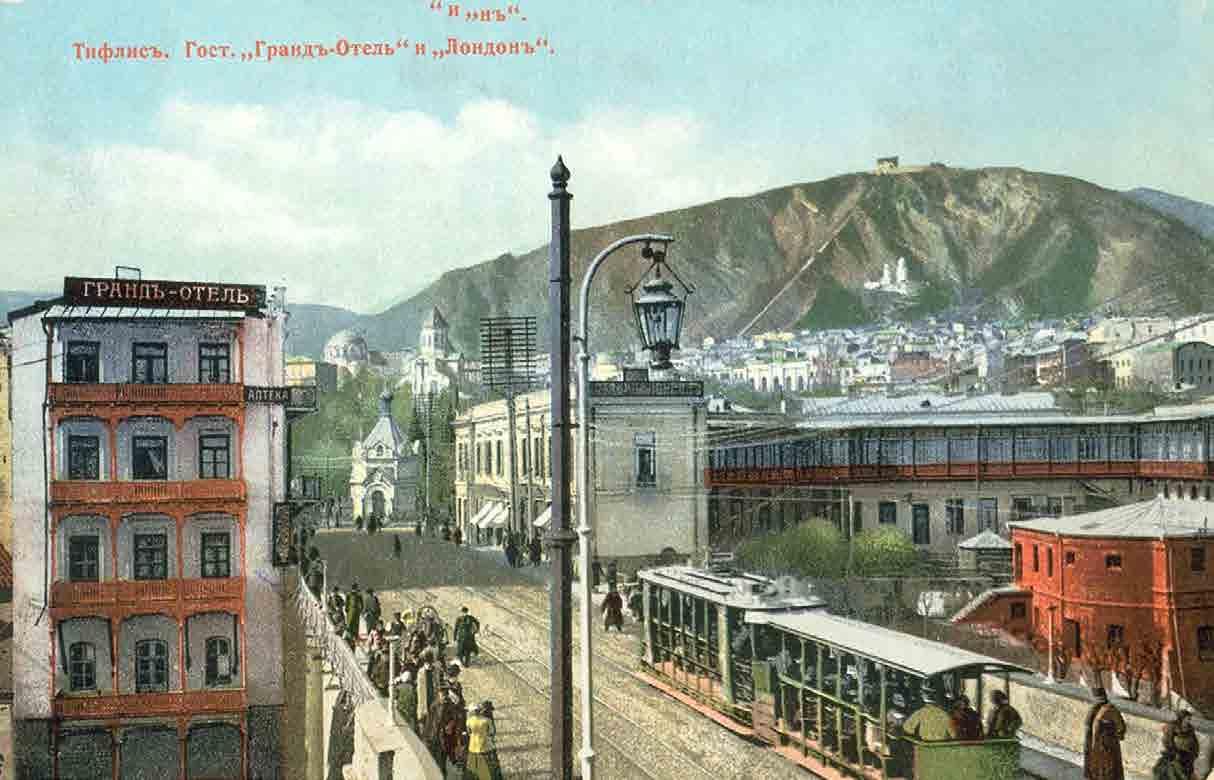
125 VOYAGER 13/2018
HAVE A LOOK AT MUNCH’S JEALOUSY, WHICH HE PAINTED AFTER DAGNY’S MARRIAGE. THE PAINTING FEATURES A COUPLE IN BACK AND A MAN IN FRONT, WHO LOOKS LIKE A SPITTING IMAGE OF PRZYBYSZEWSKI.

supreme queen and a unique creation, she was obedient only to you, and she believed you to be the only justification of her existence.
But I am taking her away from you, an evil, infinitely monstrous thing to do to you. It may ruin your life… but I cannot help it….”
It is hard to imagine how this little boy felt all alone, far away from his family, in a foreign-language environment, left to his fate, and dependent on a stranger, a child who witnessed the murder of his own mother and who, 18 years later, is expected to read this nonsense justifying the murder.
The third letter not only failed to clear up the situation but made things even more complicated. It was addressed to Dagny’s husband, Polish writer Stanisław Przybyszewski.
“Honorable Mister Stanisław Przybyszewski, dear Stas, What can I tell you? Not much. I did what you were supposed to do. She knew everything…. But then her motherly nature overcame her…. She loved Zenon very much. Thus, I had to put everything aside, and now I am killing her when she least expects it, when she is in love with you. Know that you have always been her only love. I respect you. I adore you and love you, but I know that you will curse me for doing this, and that will be my tragedy. Stas, I am killing her, and it is for her own good. Oh, I wish you could find it in your heart not to curse me!
Your Władysław, Tiflis, May 21, 1901.”
This report-like letter, which seems to unveil some background, made some suspect Przybyszewski, who seemed to be in the clear at first, of having a hand in his wife’s murder.
Norwegian Dagny and Polish Stanisław met for the first time in Berlin and got married in 1893, but before that…
Dagny, a descendant of the aristocratic Juel clan raised in the family of a prominent doctor, left home at the age of 19 and moved from the small Norwegian town of Kongsvinger to study music in Oslo. Later, while taking a course in the Berlin Conservatory, she finds herself in the middle – and maybe even in the spotlight – of the local bohemian artistic community. She frequented Zum schwarzen Ferkel (the Black Piglet), a small tavern where mostly Scandinavian authors, poets, and artists gathered, drank on end, had fun, and discussed the arts and philosophy at length in the 1890s.
Skinny Dagny was rumored to be able to consume enormous amounts of absinthe. She was gorgeous, with a contagious laughter, and especially charming when dancing. She was uncompromising and daring, defying all limitations. And, according to author Zurab Karumidze, she wrote what the women of her time did not write: symbolist poems, plays, and prose. She also translated. Dagny Juel was a representative of the generation of women who started emancipation in the arts.
Her amorous adventures have been studied and scrutinized by many. Some believe that she had a passionate affair with Edvard Munch, because of whom
STORY
126 VOYAGER 13/2018
she moved to Berlin in the first place. The Norwegian artist depicted her in numerous paintings, and she is commonly believed to be the prototype of his famous Madonna.
Yet their correspondence looks nothing like communication between two people madly in love with each other. On the other hand, have a look at Munch’s Jealousy, which he painted after Dagny’s marriage. The painting features a couple in the background and a man in front, who looks like a spitting image of Przybyszewski.
Dagny was also rumored to have been August Strindberg’s mistress. In his correspondence, the Swedish playwright insists that, with his fiancé absent, Dagny Juel had been involved with him in the course of three weeks.

Another version claims that Dagny turned down Strindberg’s marriage proposal, who, in his adoration, likened her to Aspasia, the wisest, shrewdest, and most beautiful in Ancient Greece; she even ridiculed him because of his old age.
Stanisław Przybyszewski, an extremely scandalous Polish author obsessed with weird philosophical ideas, makes Dagny’s acquaintance at the Black Piglet. Soon, he leaves his two children and pregnant wife to marry Dagny, who refers to him affectionately as Stachu and has two children with him. At first, the family lives with Dagny’s parents in Norway and later moves to Krakow and Warsaw in Poland. With his popularity on the rise, Przybyszewski travels a lot and delivers lectures on the arts and literature.
After learning that her beloved Stachu is having an affair with Jadwiga Kasprowiczowa, the wife of his friend and poet Jan Kasprowicz, Dagny also tours Europe in the company of Polish poet Vincent Brzozowski. Dagny’s vengeful antics caused her family’s displeasure in Norway.
Eventually, the couple were trying to make things right, and that is when they received Emeryk’s invitation to join him in his travel to the Caucasus.
Word has it that after arriving at the train station to travel to an unknown country somewhere between Asia and Europe, Przybyszewski, under the pretext of some urgent errands, decided to stay put with their small daughter Iwa. He kept his wife’s papers, saw off Dagny and their 5-year-old son Zenon together with Emeryk, and promised to see her in Tiflis in a week.
While Dagny was at the Grand Hotel, she wrote to her husband several times and asked him to send her documents so that she could return home. Przybyszewski, however, was too busy torn between two mistresses.
Then was the day when Dagny was taking a nap after dinner in Room 4 of the Grand Hotel in Tiflis, an unfamiliar city, where she and her 5-year-old son checked in 11 days earlier.
THE WOMEN'S MUSEUM
Dagny Juel is nothing short of a myth. Today, her biographers are having trouble telling real facts from the fantasies of those under her influence. The most reliable sources, however, such as her works, diaries, poems, plays, and such, were shelved for a long time in both Norway and Poland. The first articles about Dagny Juel were published in the 1960s, followed by three biographies. In Norway, Dagny Juel is now praised as a symbol of the fight for women’s rights, as evidenced by the Women’s Museum in her Kongsvinger family estate.
Here, in the Rolighed Villa, the famous doctor Hans Lemmich Juel, his wife, and four daughters settled in 1875. In 2001, the 100th anniversary of Dagny’s death, a permanent exhibition called The Lady in Berlin opened in the four Juel sisters’ bedroom.
Literature about Dagny Juel is preserved in a special section in the museum’s library. The museum’s shop features a full collection of Dagny’s literary legacy in the Norwegian language. The museum’s café offers homemade pastries and delicious soups. You can even choose a place to enjoy your meal: in the blue kitchen, the cafeteria, or on the veranda. Next to the café there is a special entertainment room for children.
Løkkegata 35, 2213 Kongsvinger kvinnemuseet.no/en
127 VOYAGER 13/2018









































 Bohemian Grünerløkka District
Bohemian Grünerløkka District






























 IRINA POPIASHVILI
IRINA POPIASHVILI





































 UNA ABASHIDZE
UNA ABASHIDZE




























 Rasmus Meyers allé 9, Inngang gjennom KODE 4 www.lysverket.no
Rasmus Meyers allé 9, Inngang gjennom KODE 4 www.lysverket.no






















 Northern Soul Adventures northernsouladventures.com
Northern Soul Adventures northernsouladventures.com





































 DIKKEN ZWILGMEYER FOUR COUSINS
MTP PUBLISHING
VESTLY MOTHER, FATHER, EIGHT CHILDREN, AND A TRUCK BAKUR SULAKAURI
ARNE SVINGEN THE BALLAD OF A BROKEN NOSE BAKUR SULAKAURI PUBLISHING
MARIA PARR WAFFLE HEARTS BAKUR SULAKAURI PUBLISHING
DIKKEN ZWILGMEYER FOUR COUSINS
MTP PUBLISHING
VESTLY MOTHER, FATHER, EIGHT CHILDREN, AND A TRUCK BAKUR SULAKAURI
ARNE SVINGEN THE BALLAD OF A BROKEN NOSE BAKUR SULAKAURI PUBLISHING
MARIA PARR WAFFLE HEARTS BAKUR SULAKAURI PUBLISHING




























 KAKHA TOLORDAVA
KAKHA TOLORDAVA







 MIKHEIL TSIKHELASHVILI
MIKHEIL TSIKHELASHVILI









